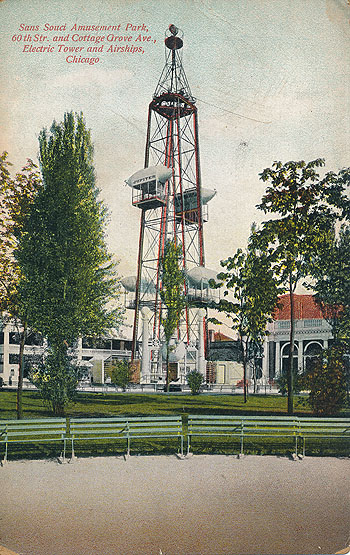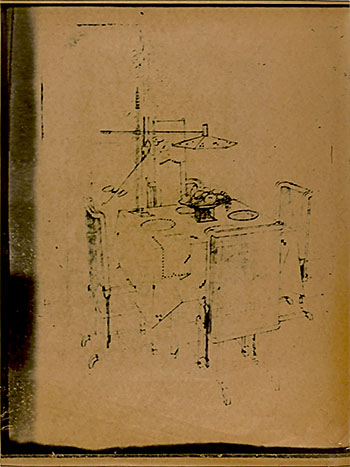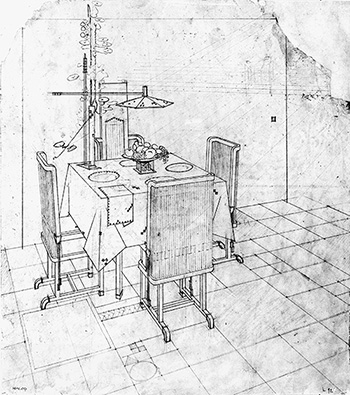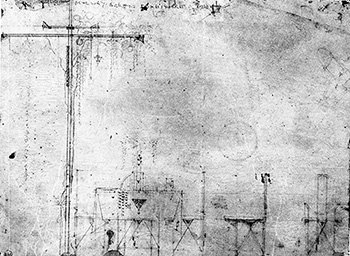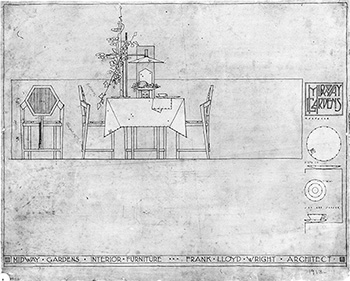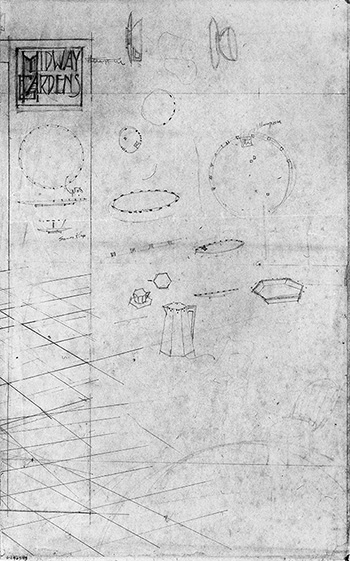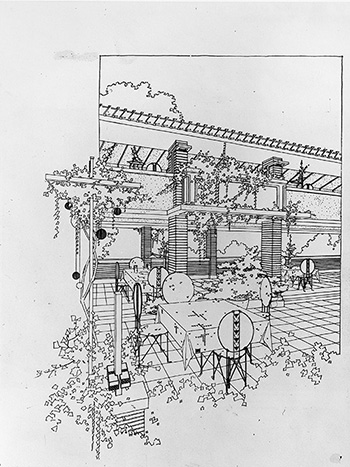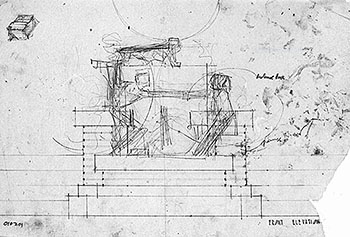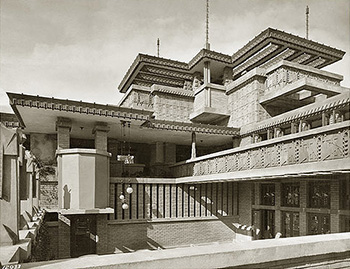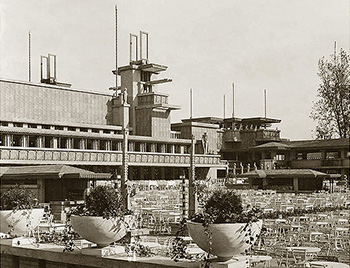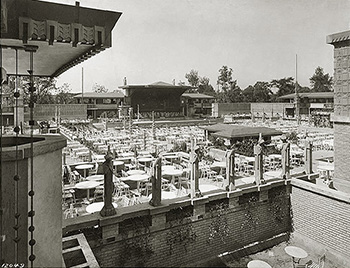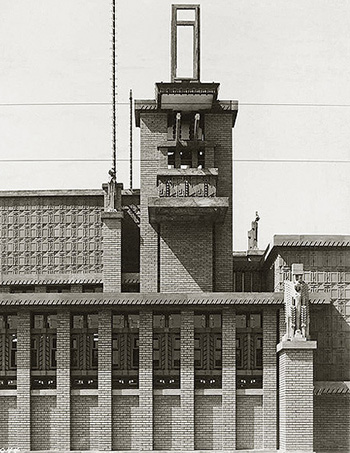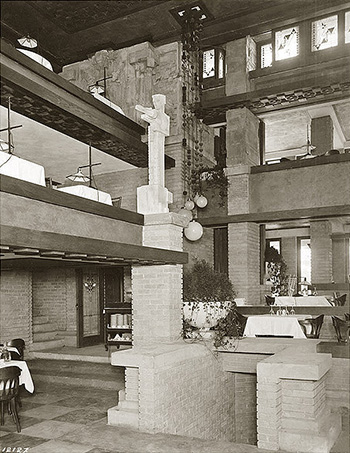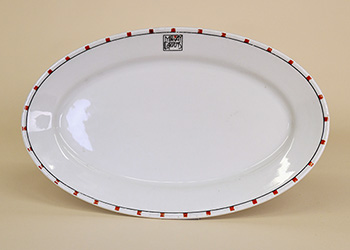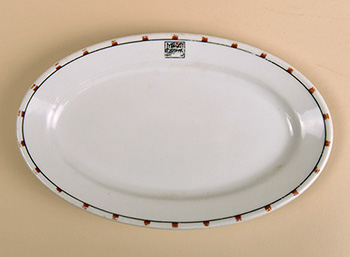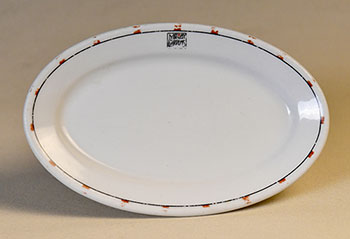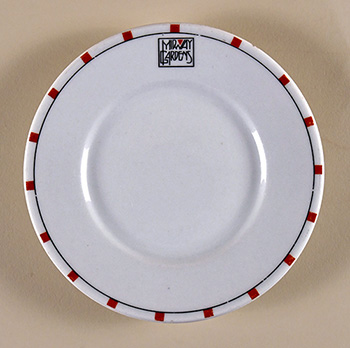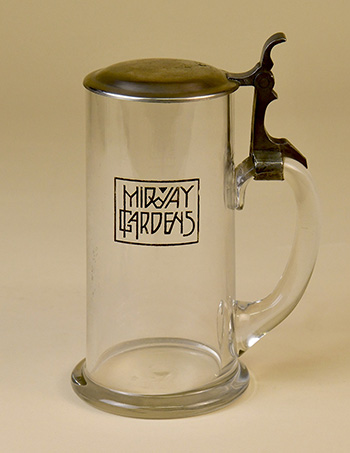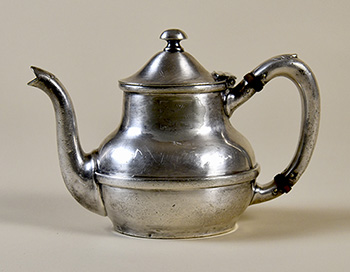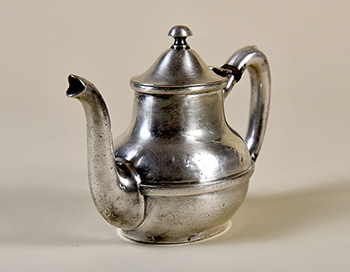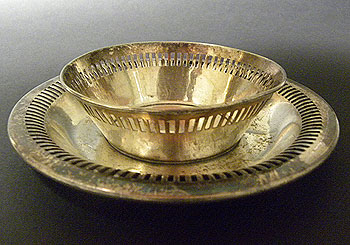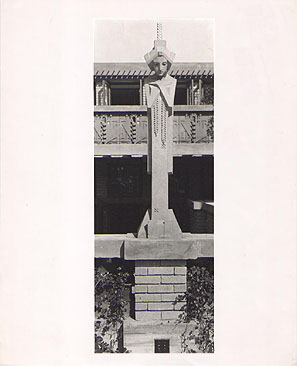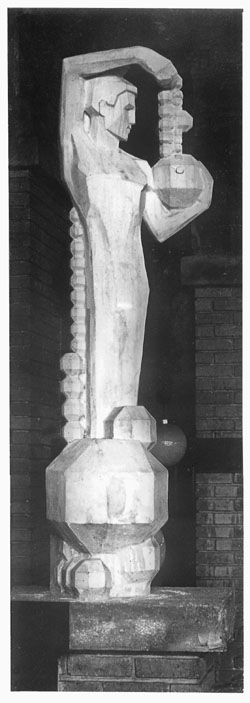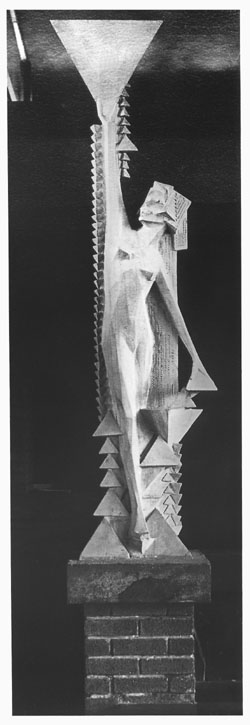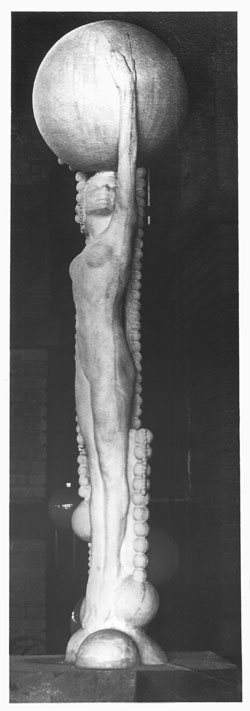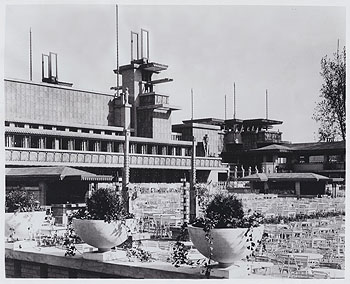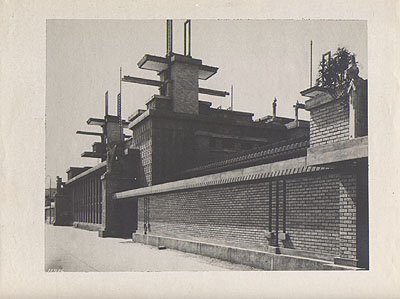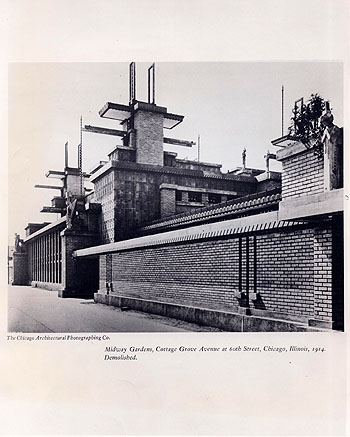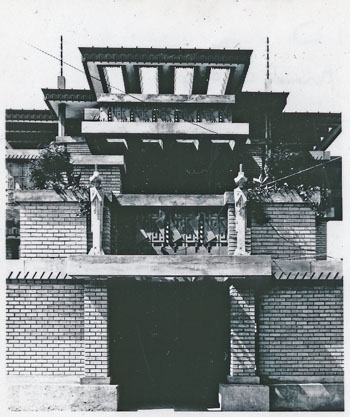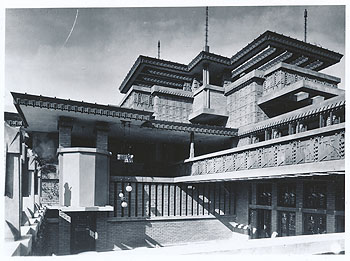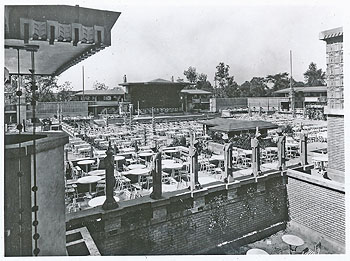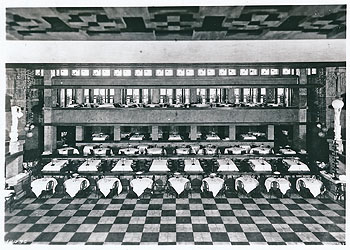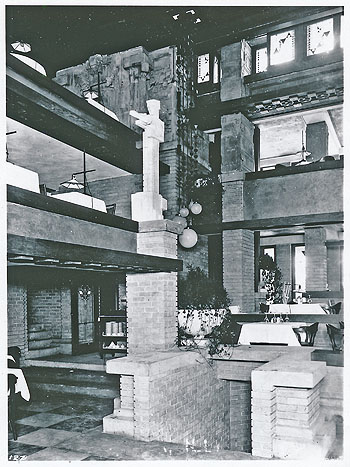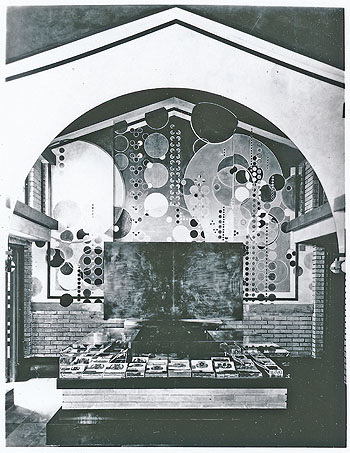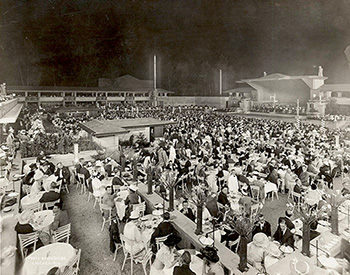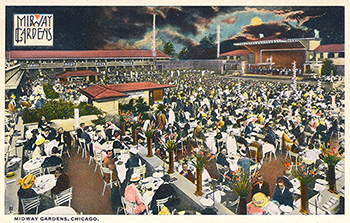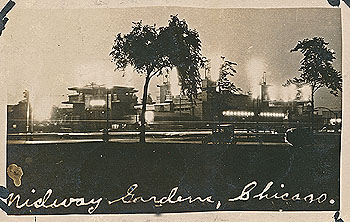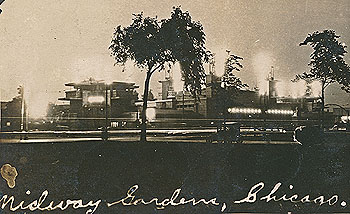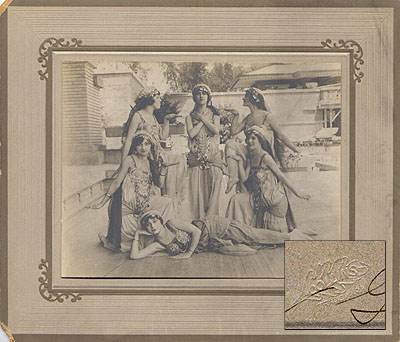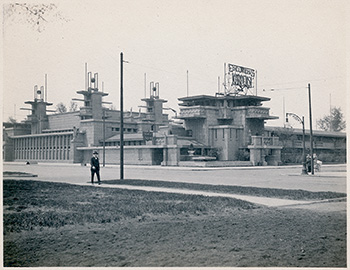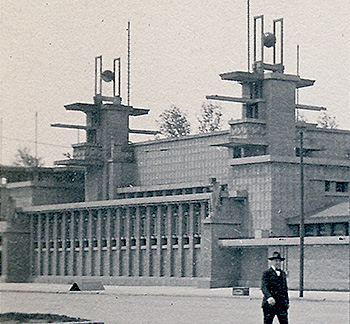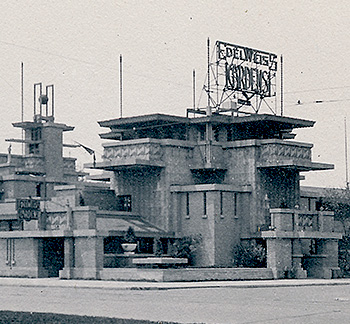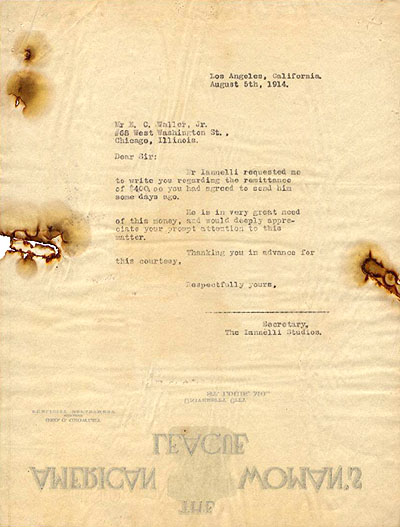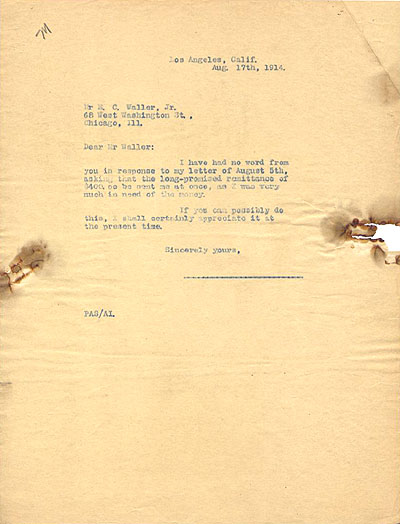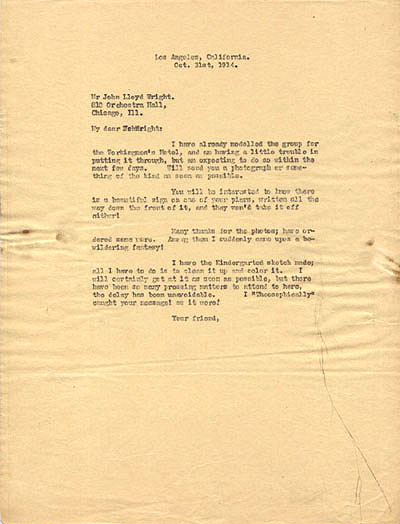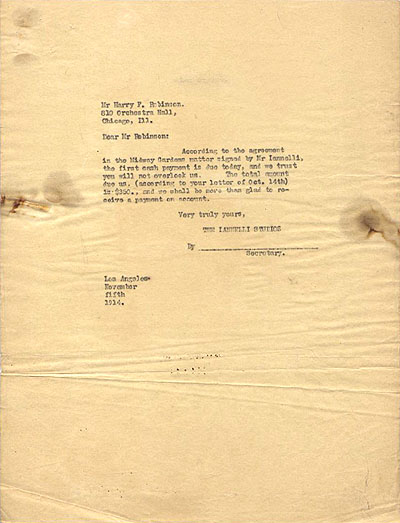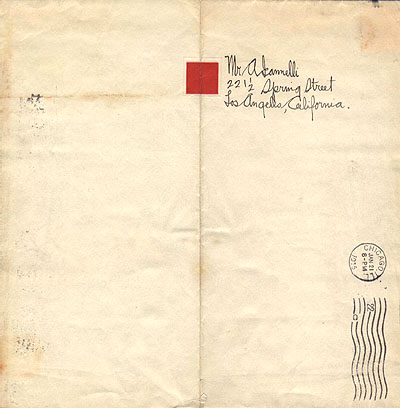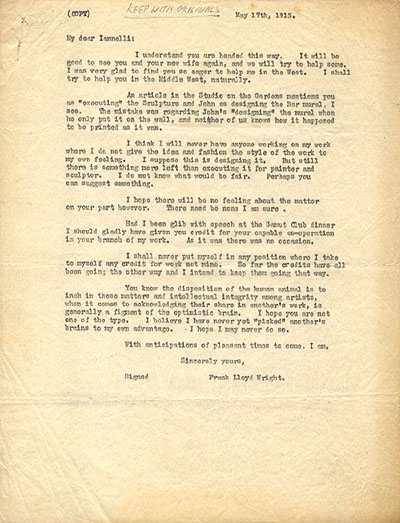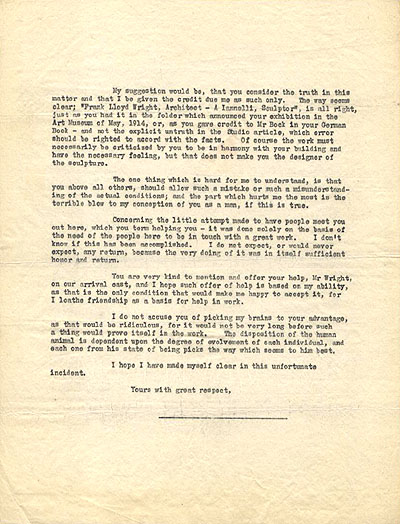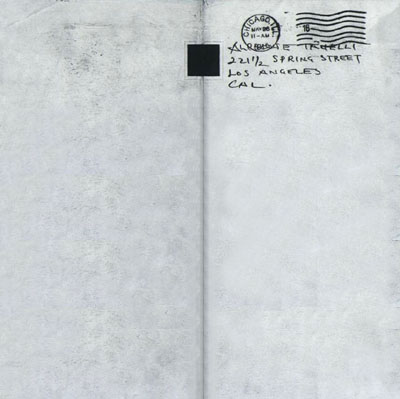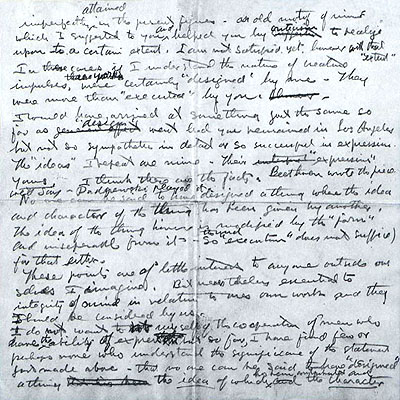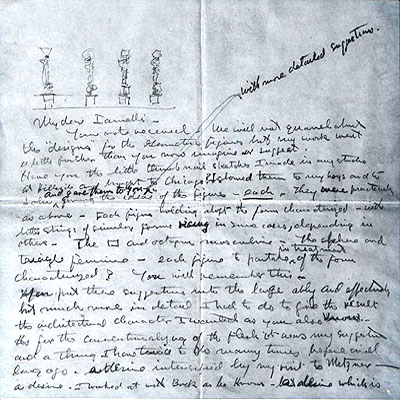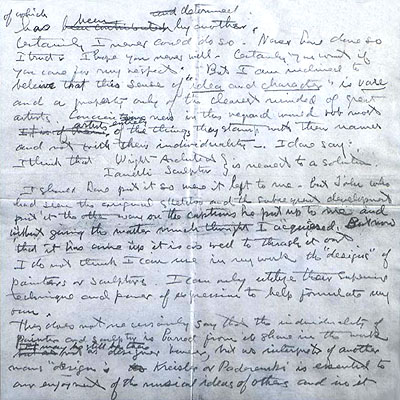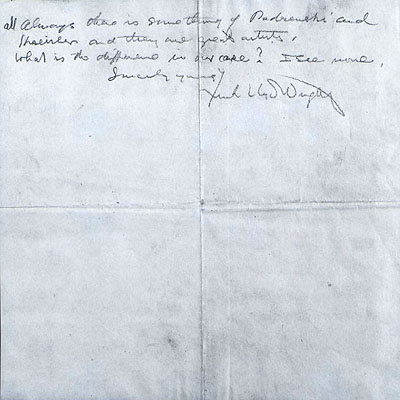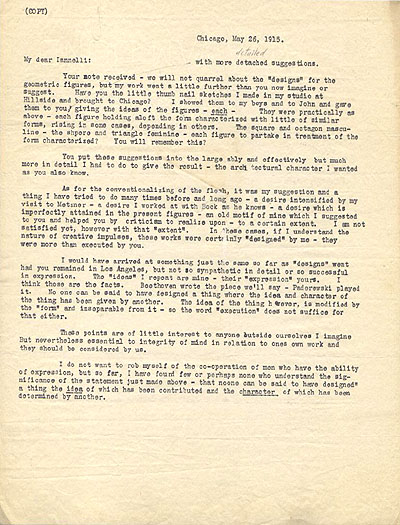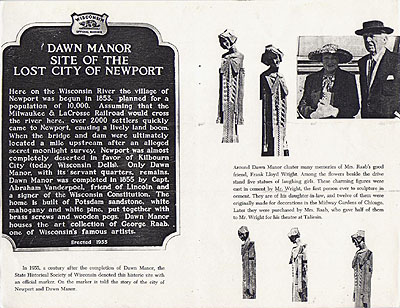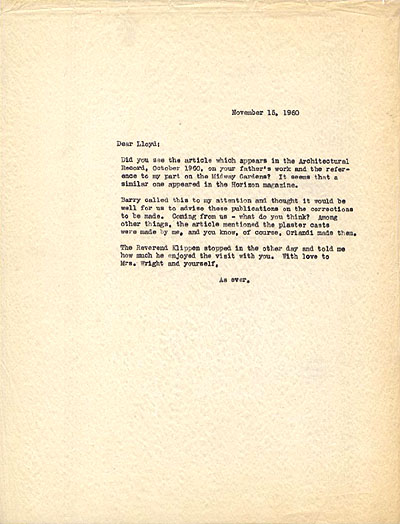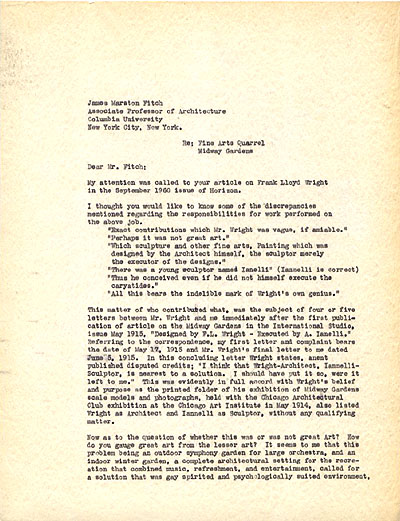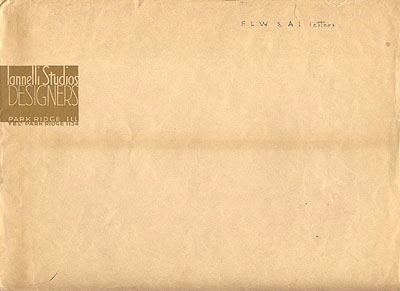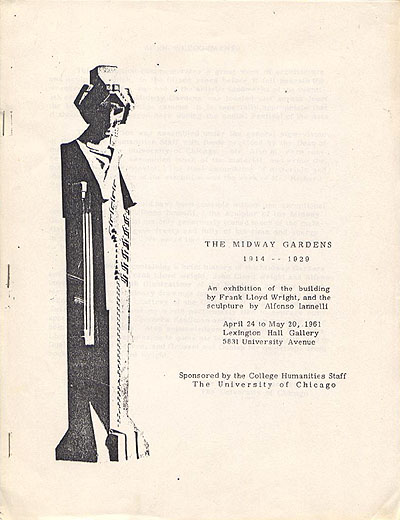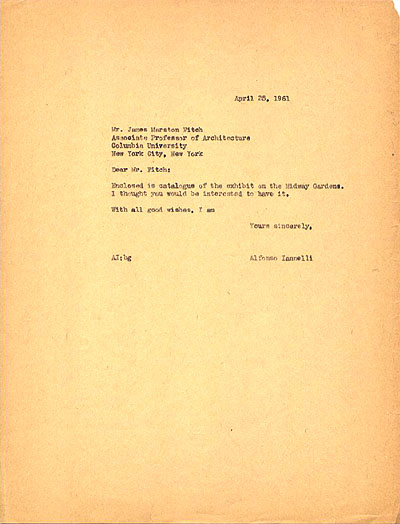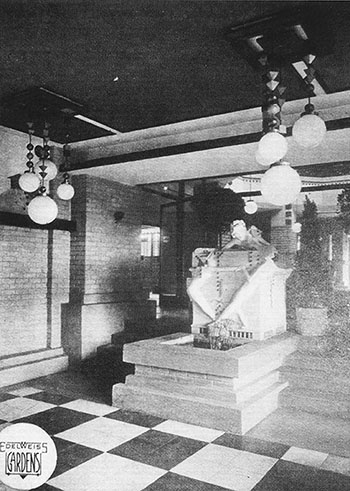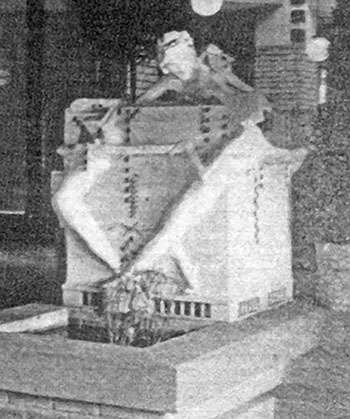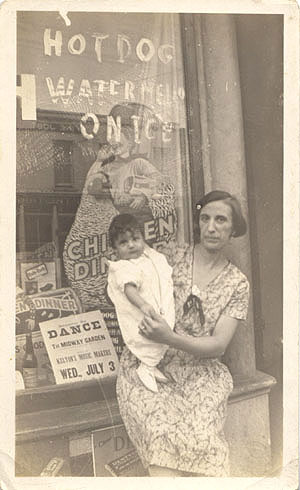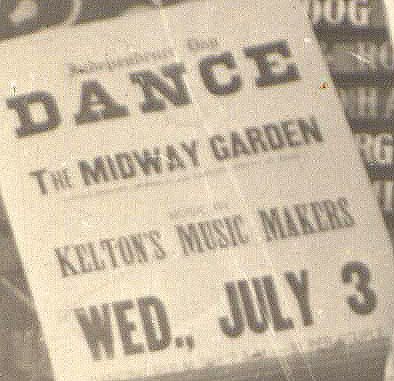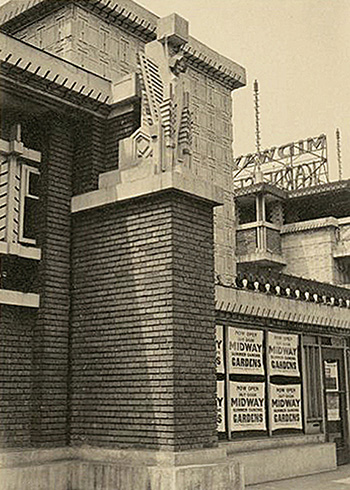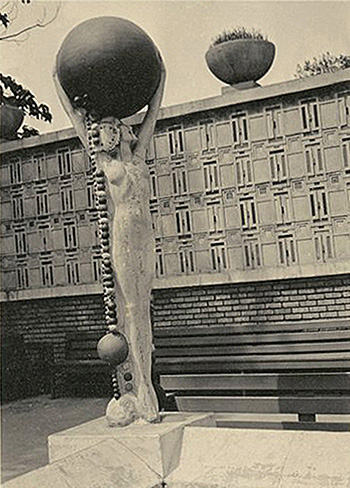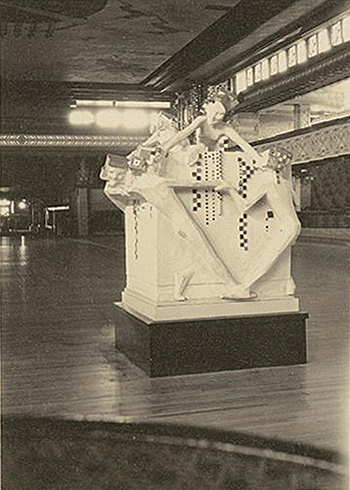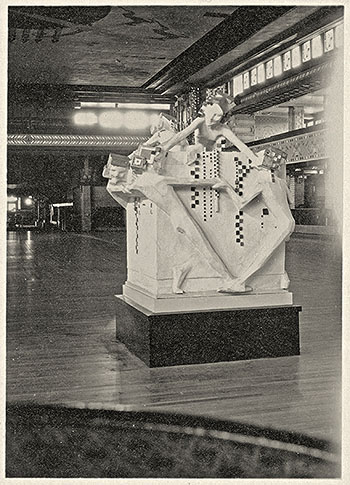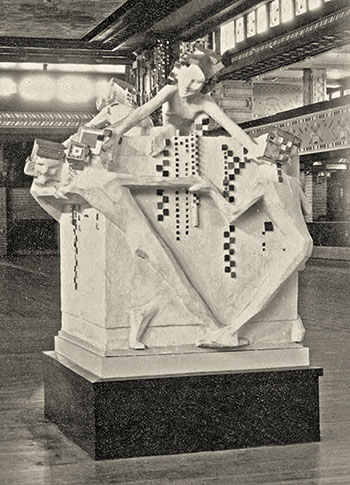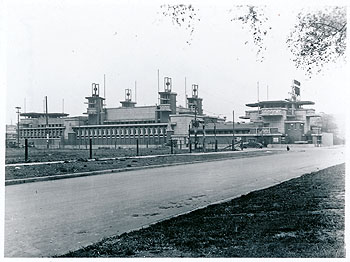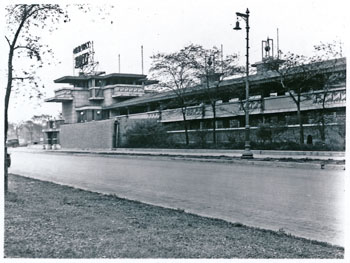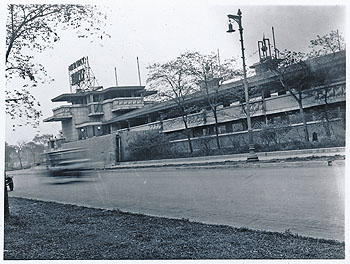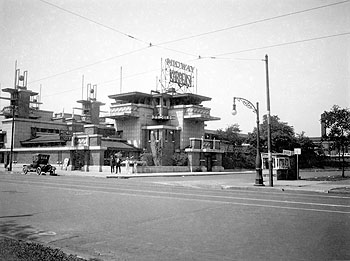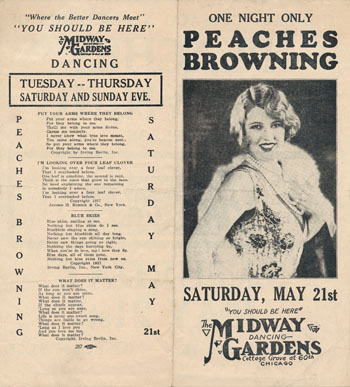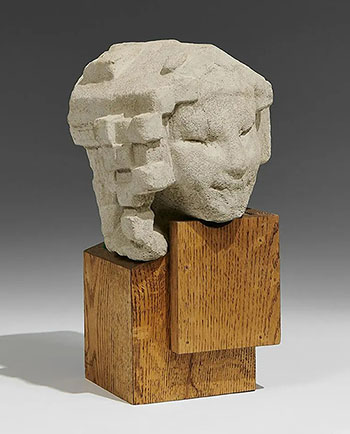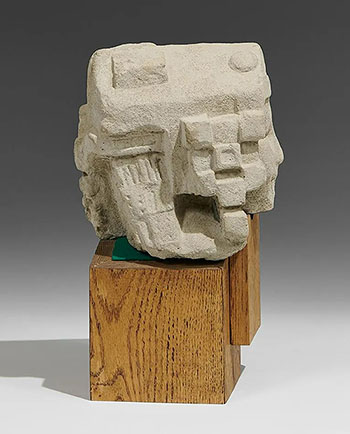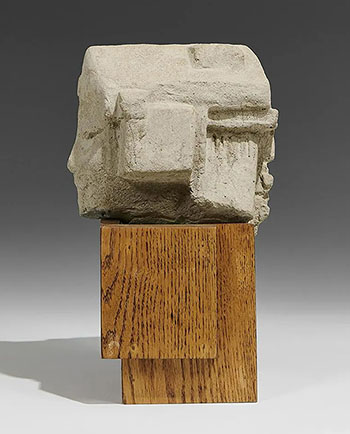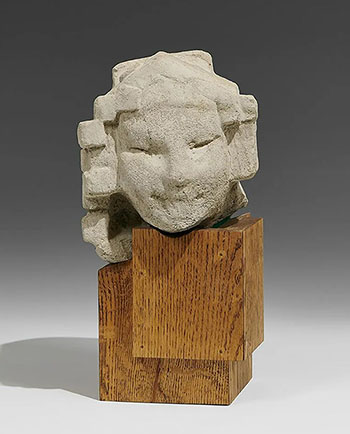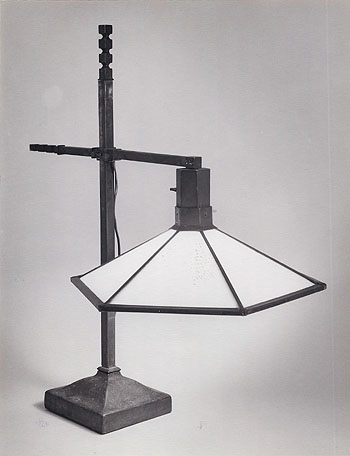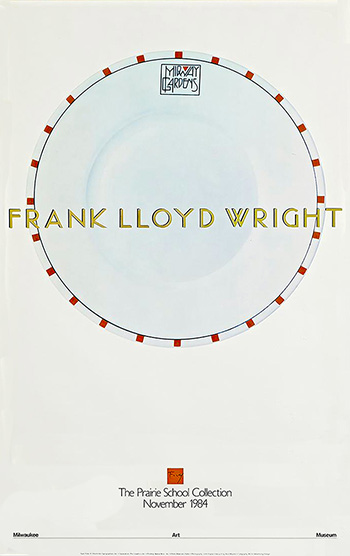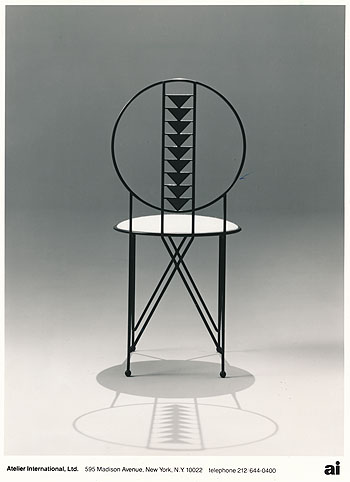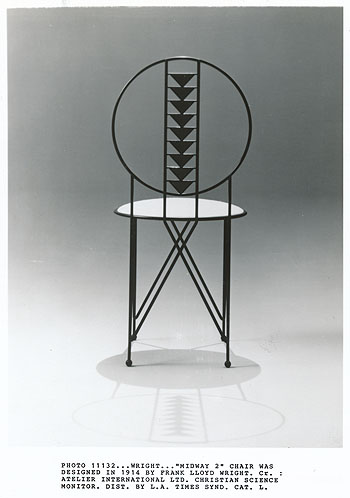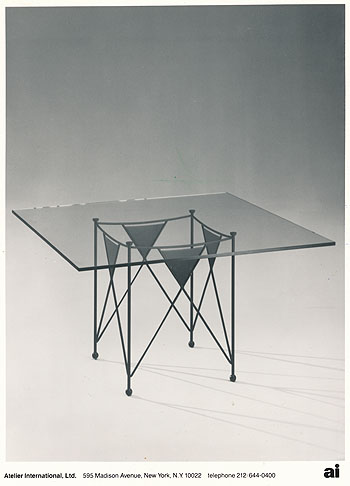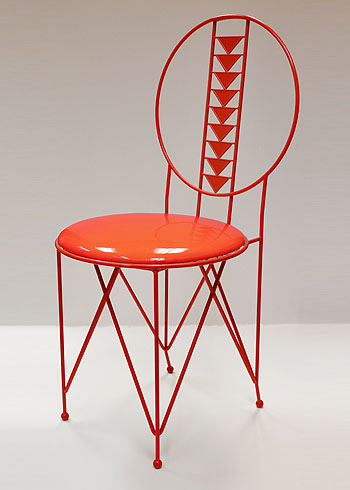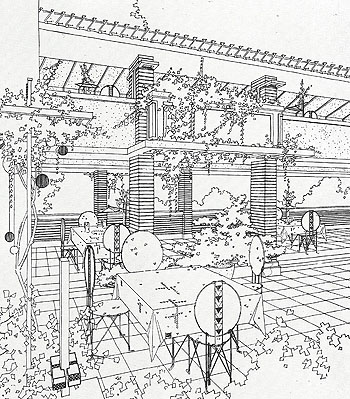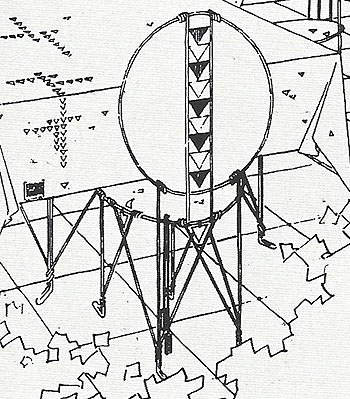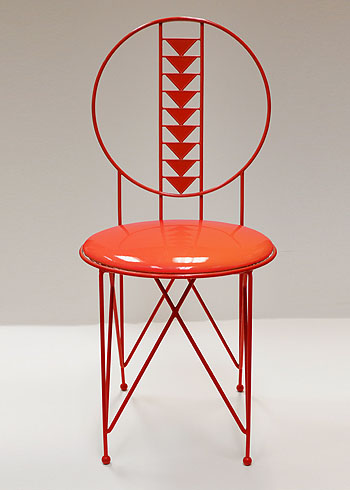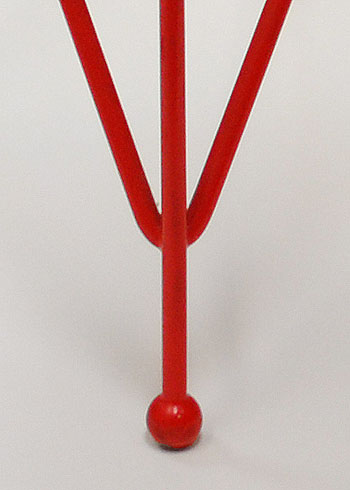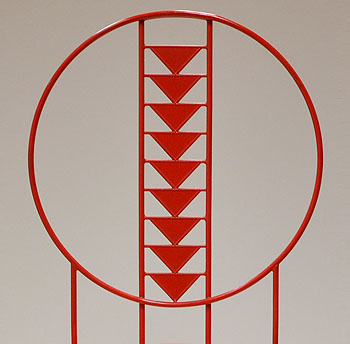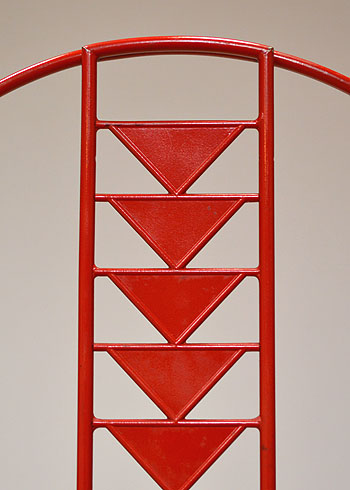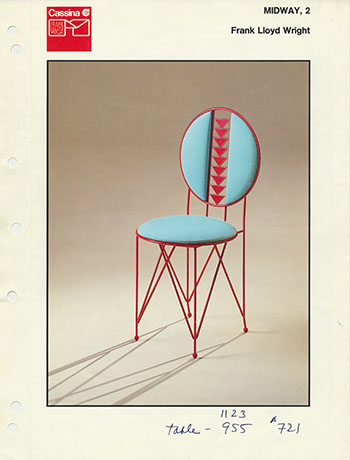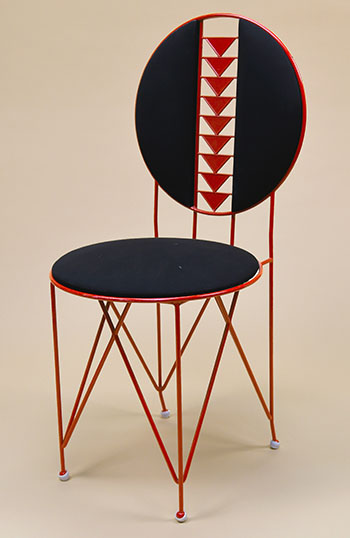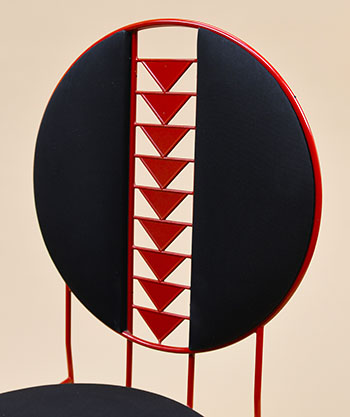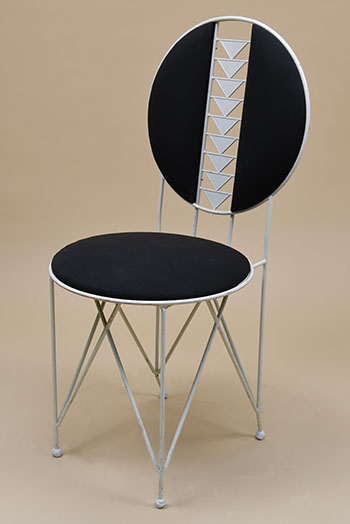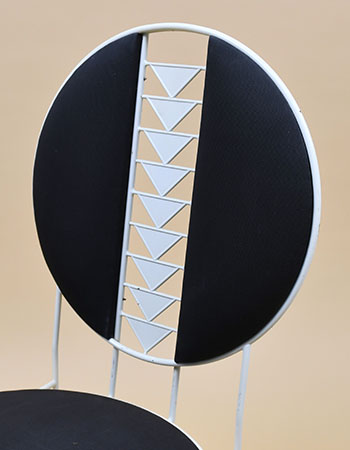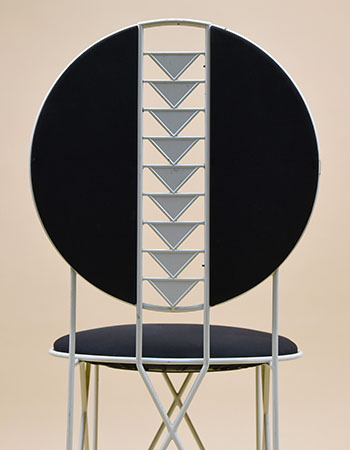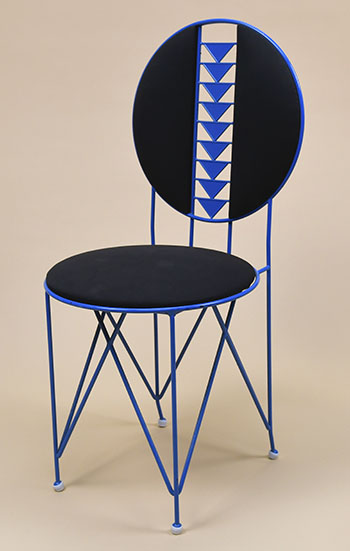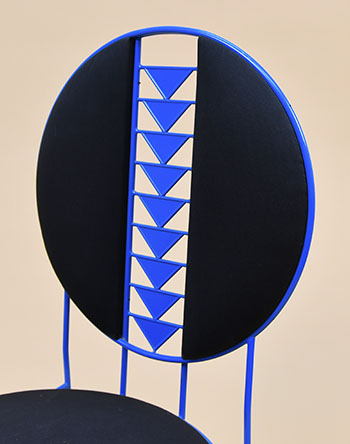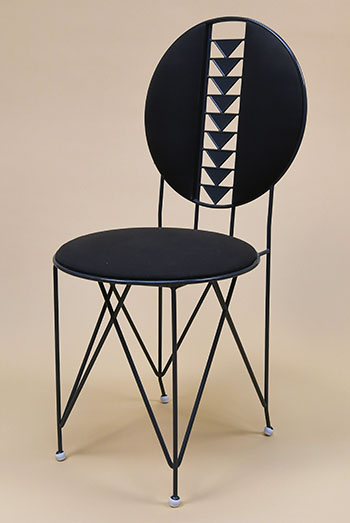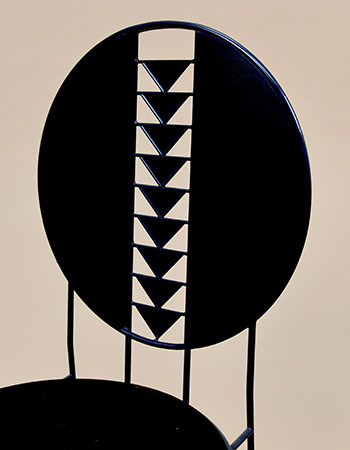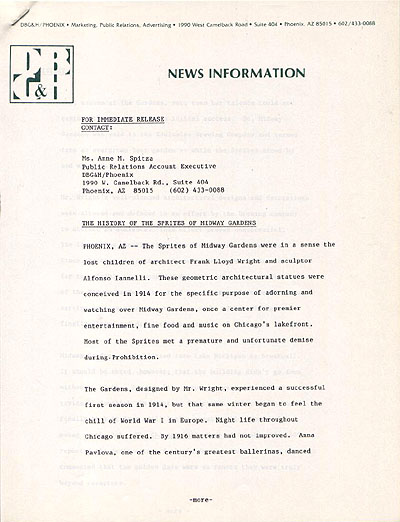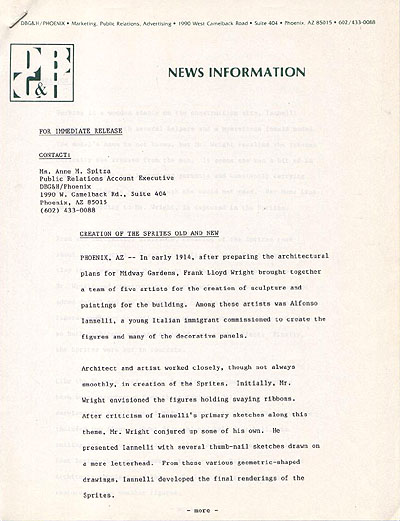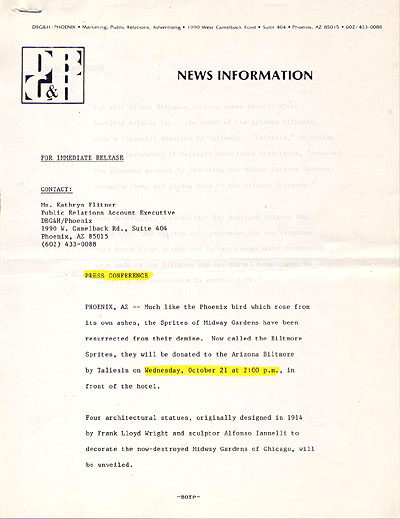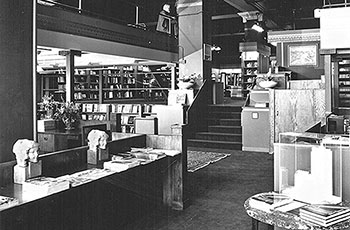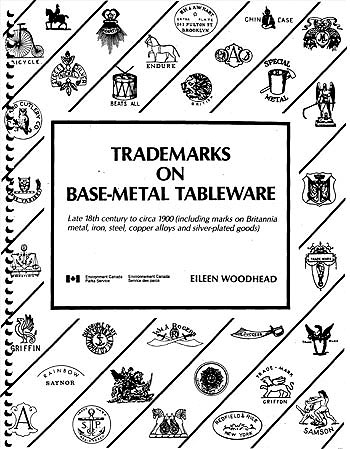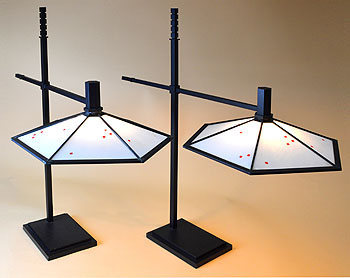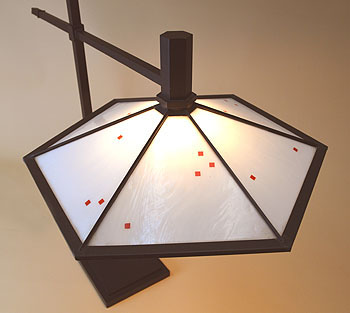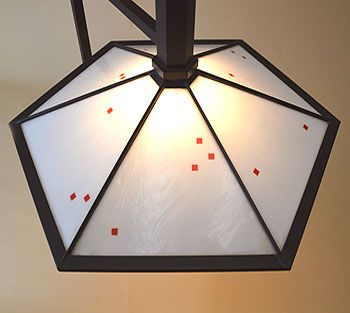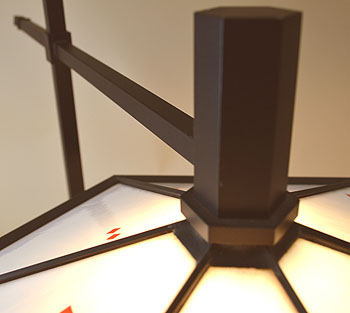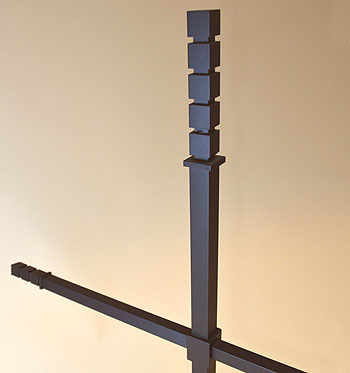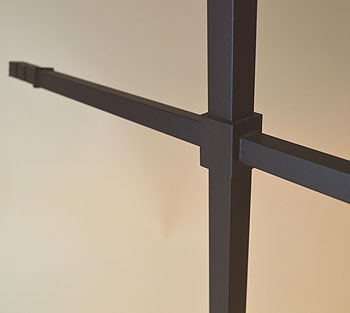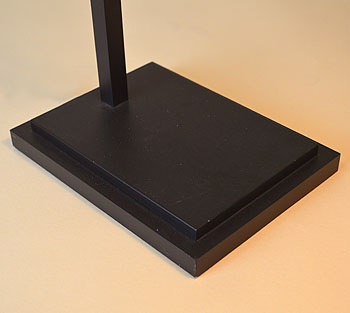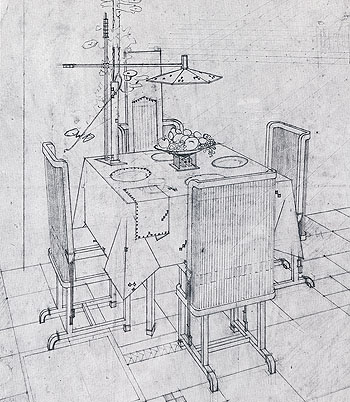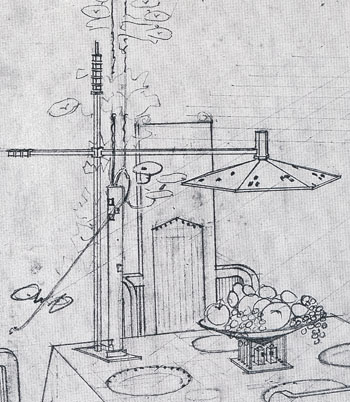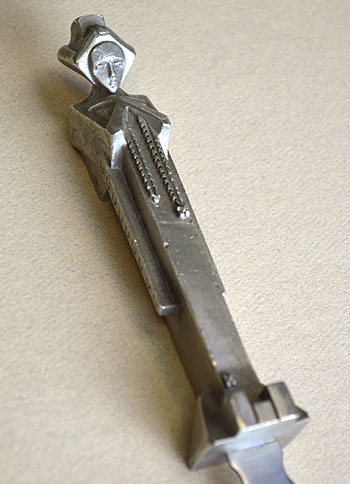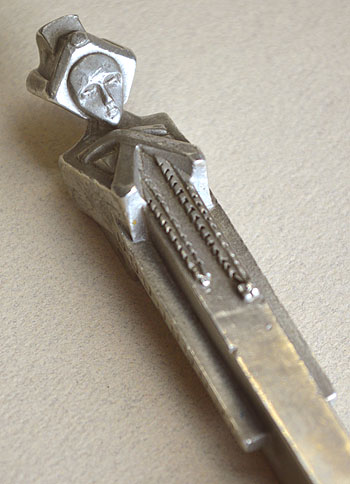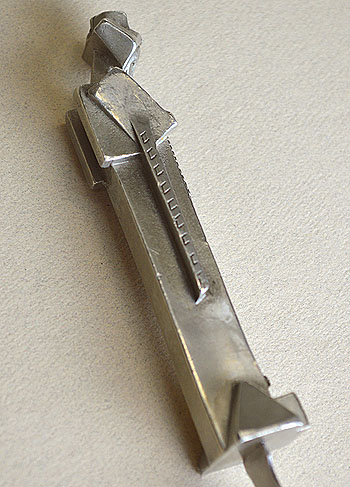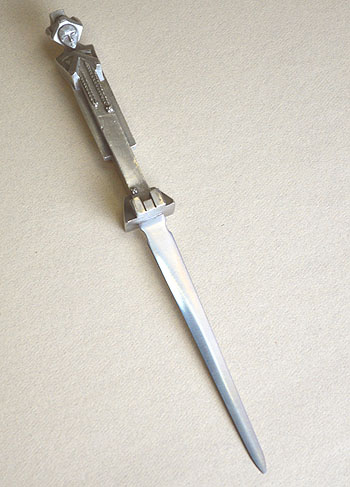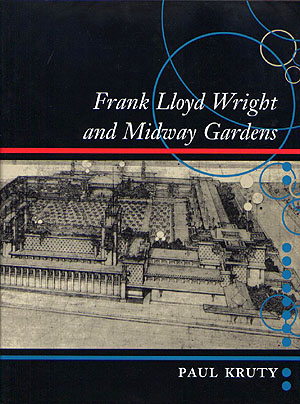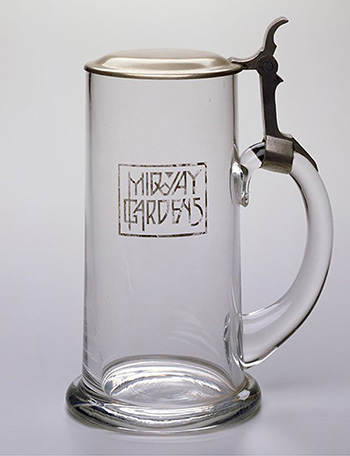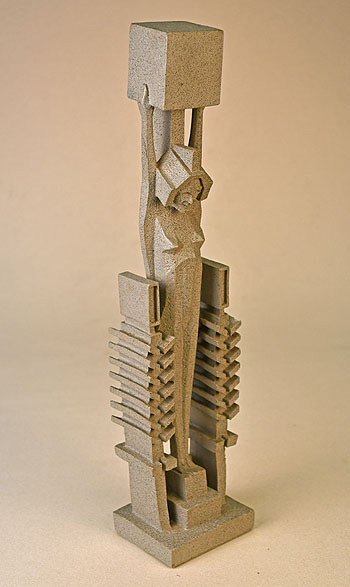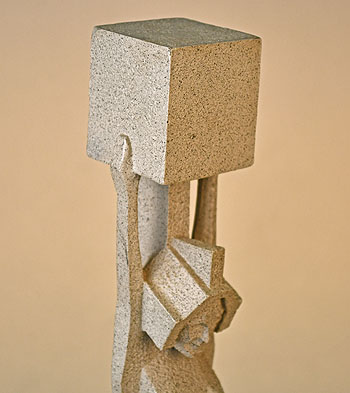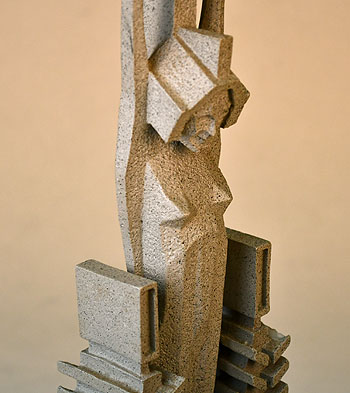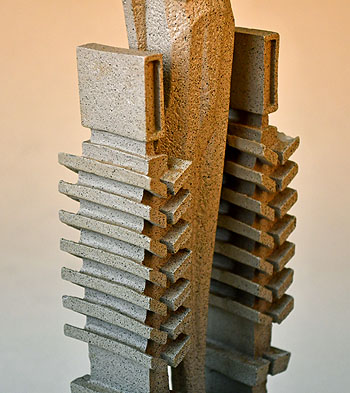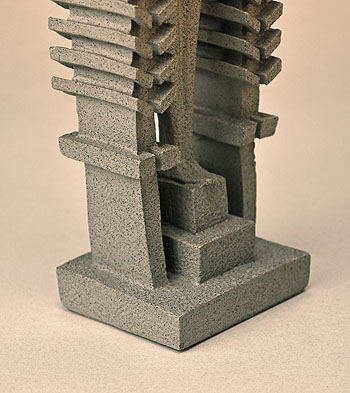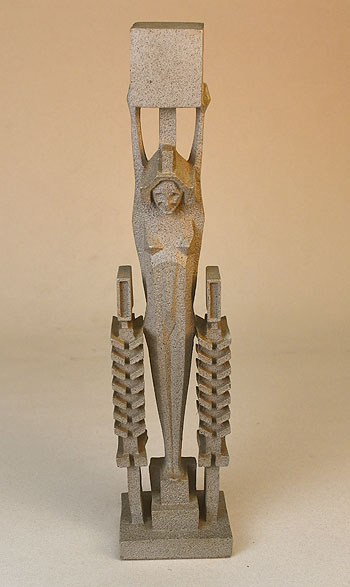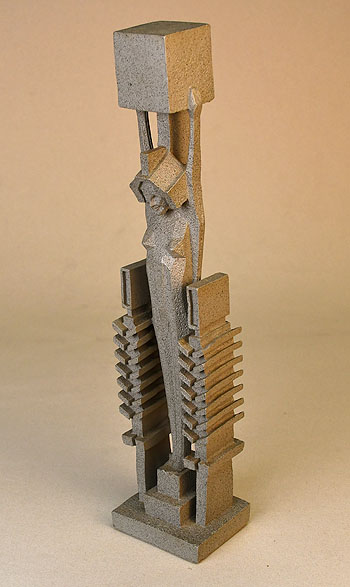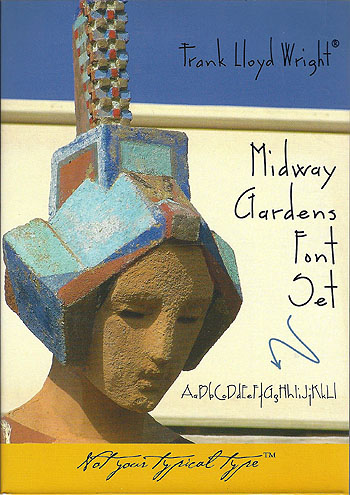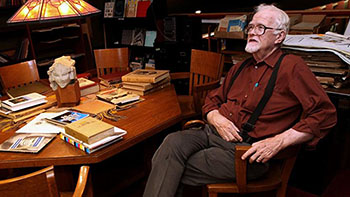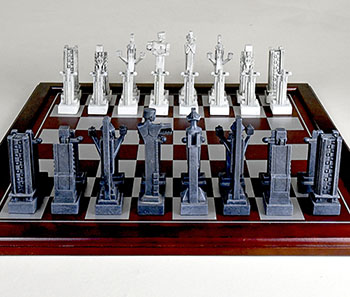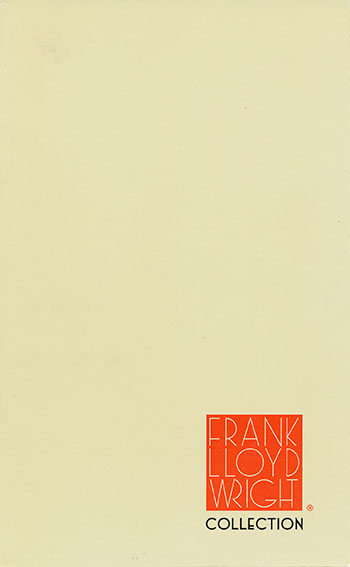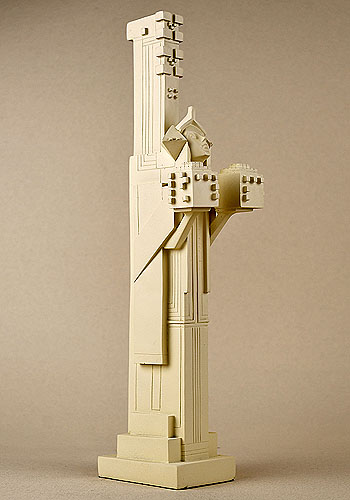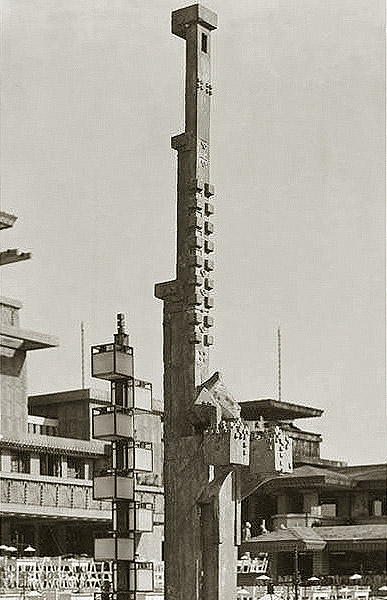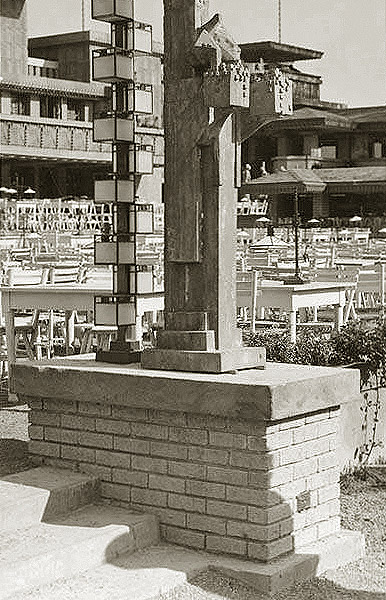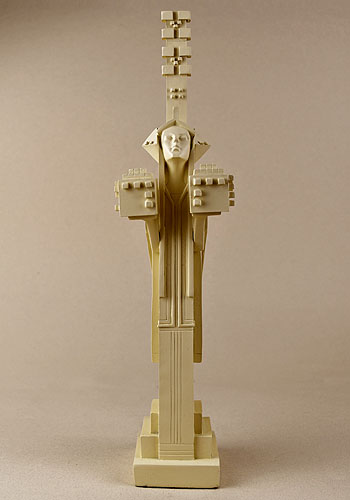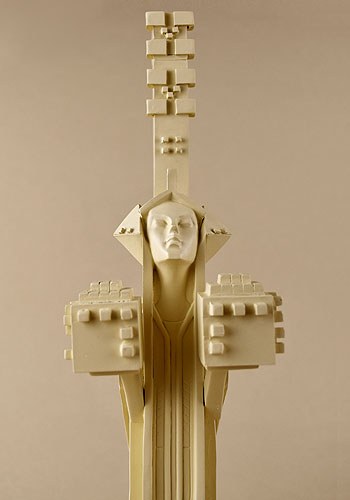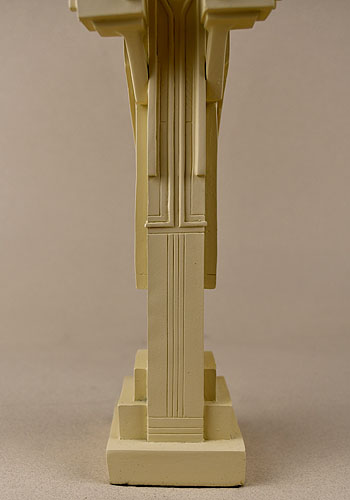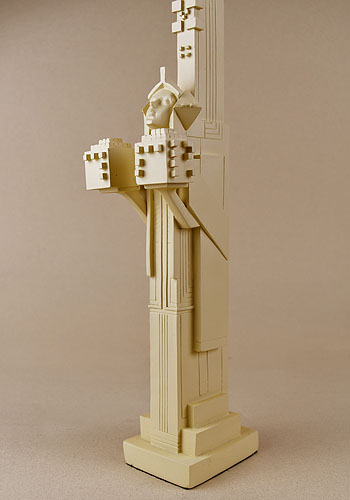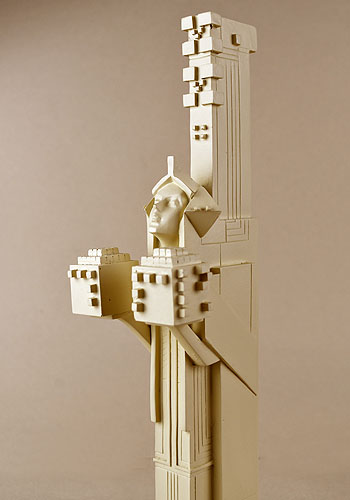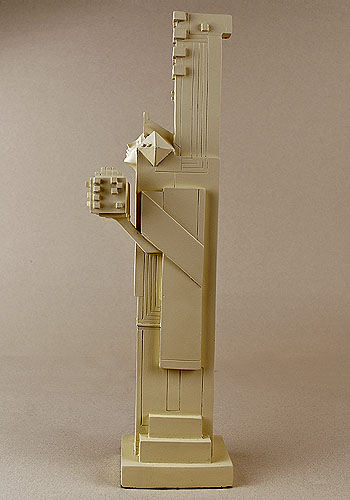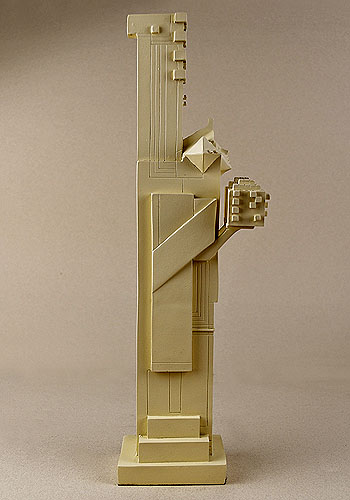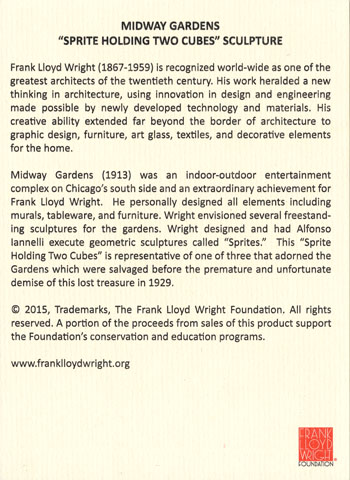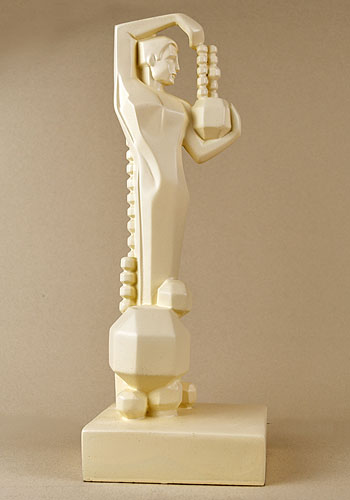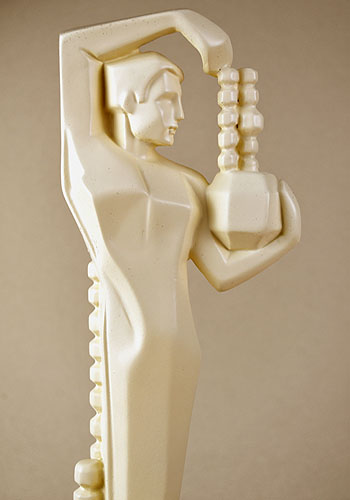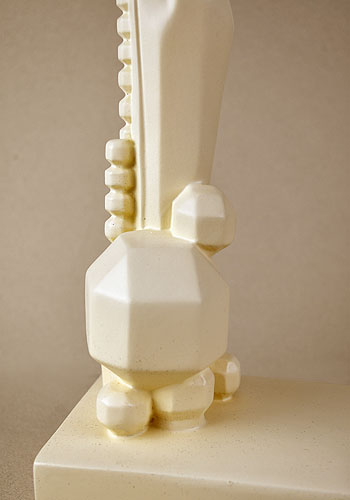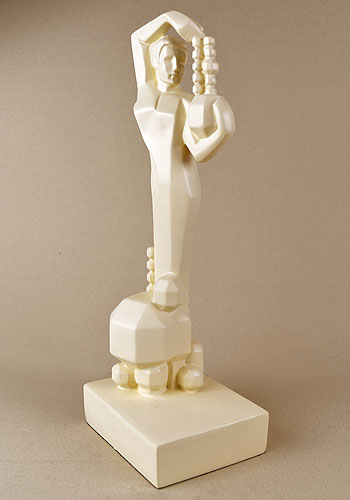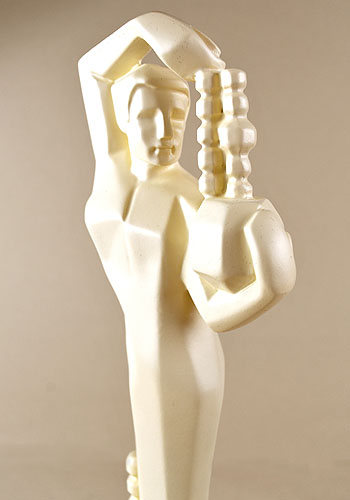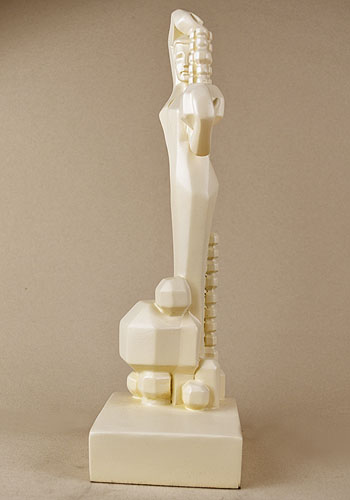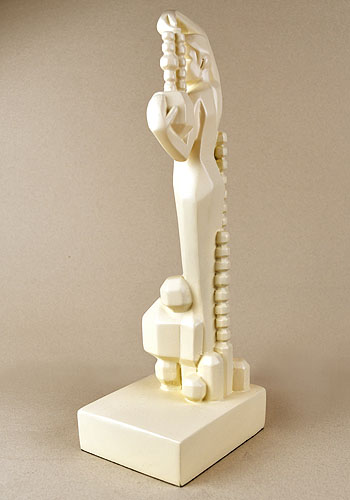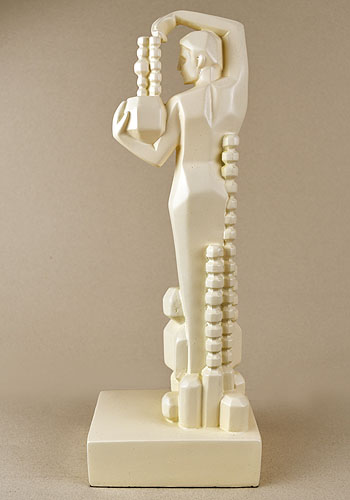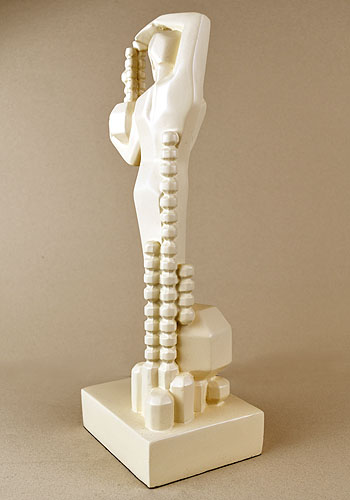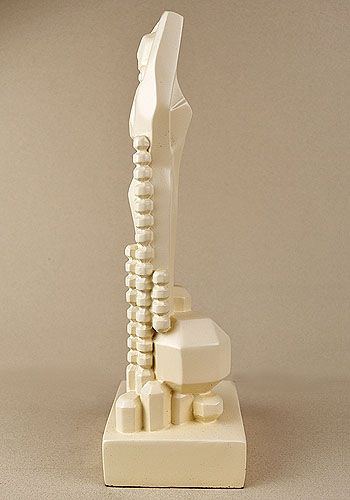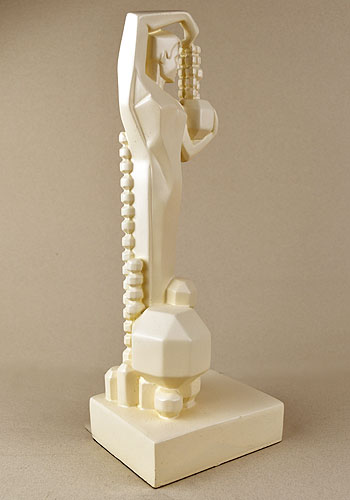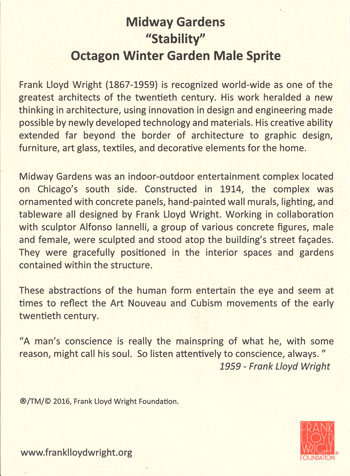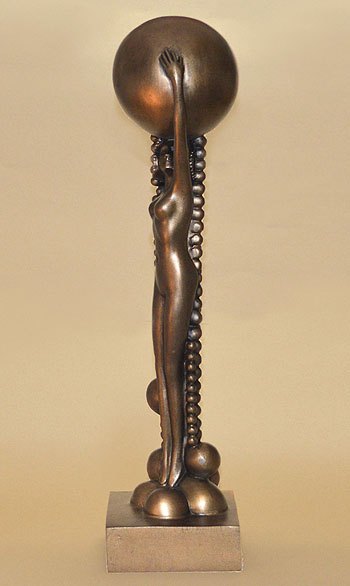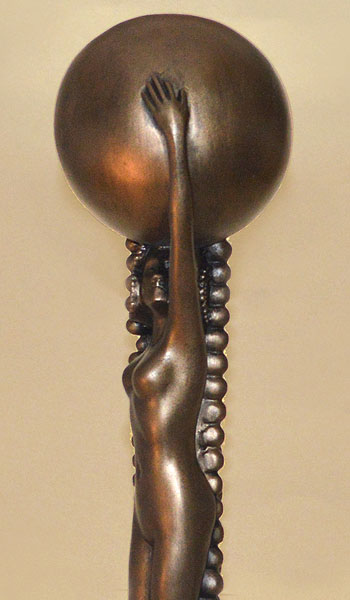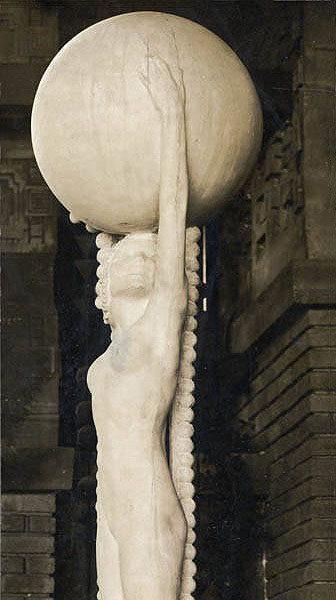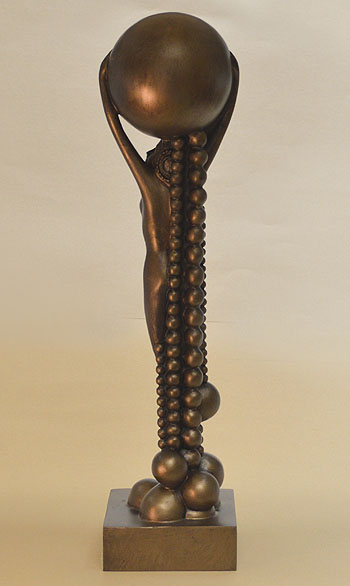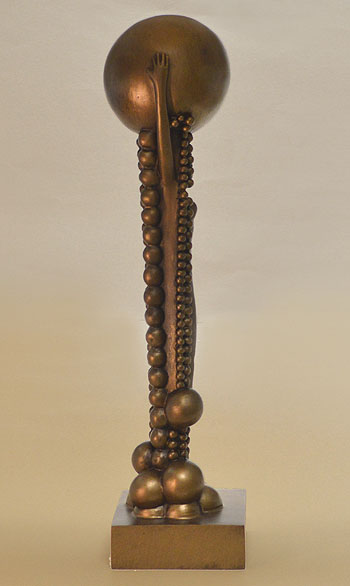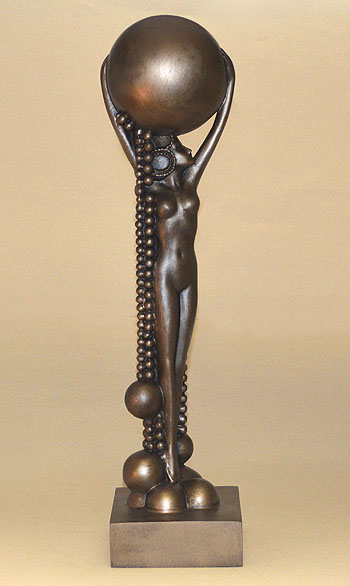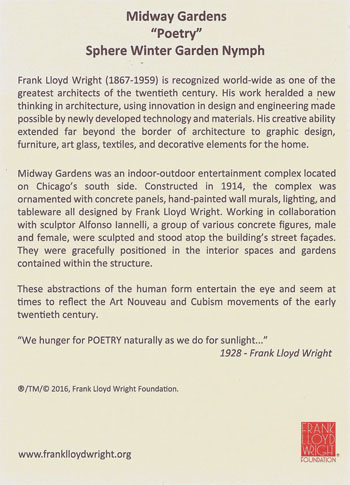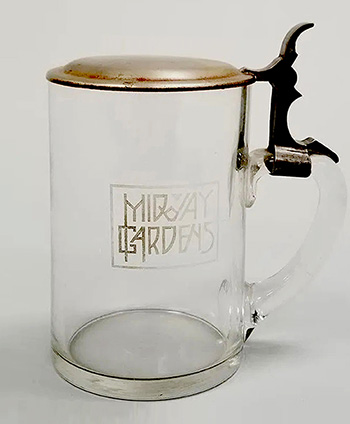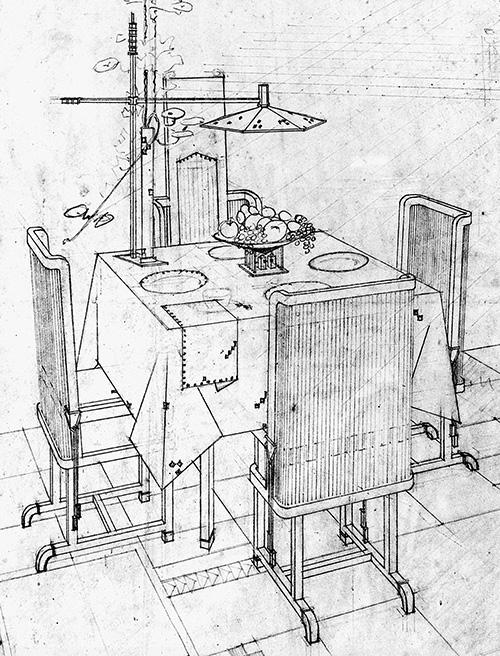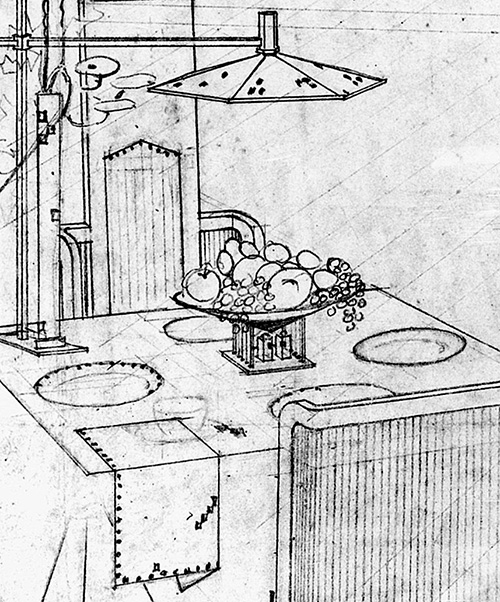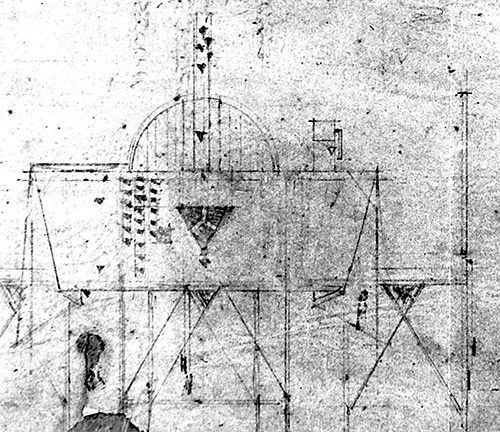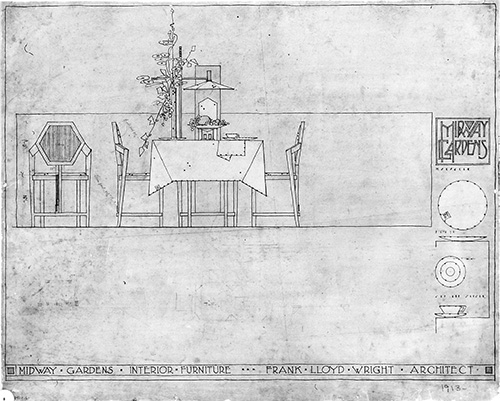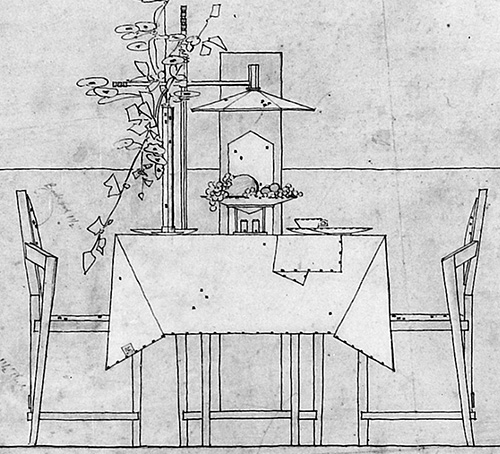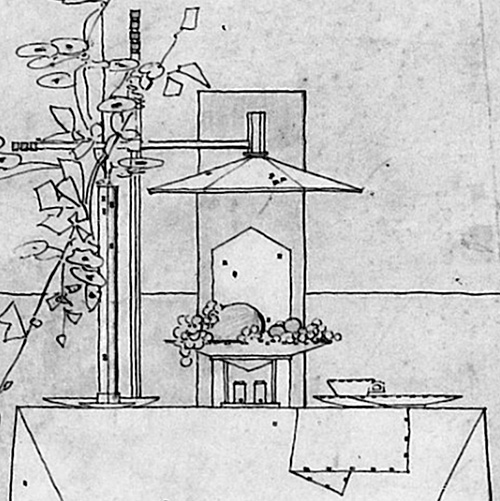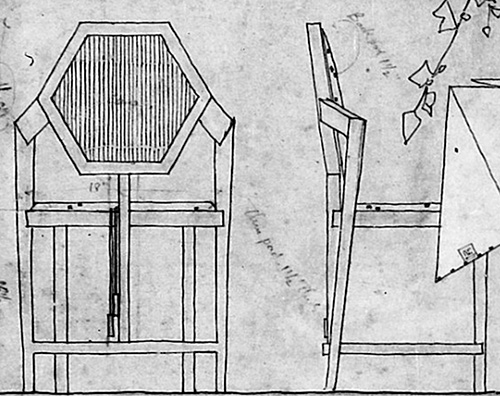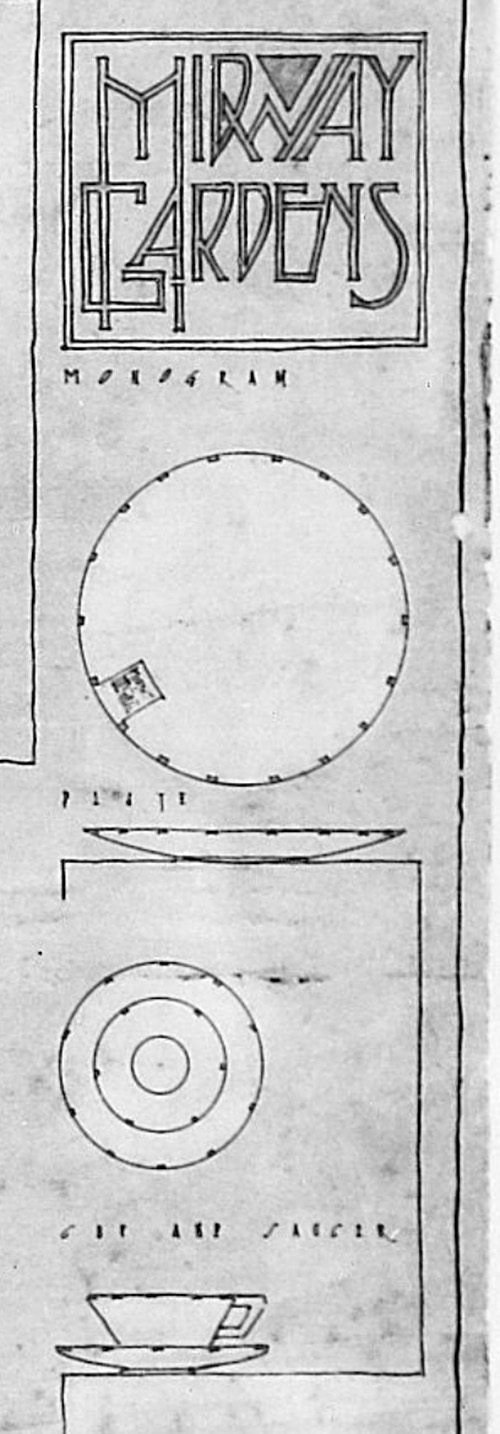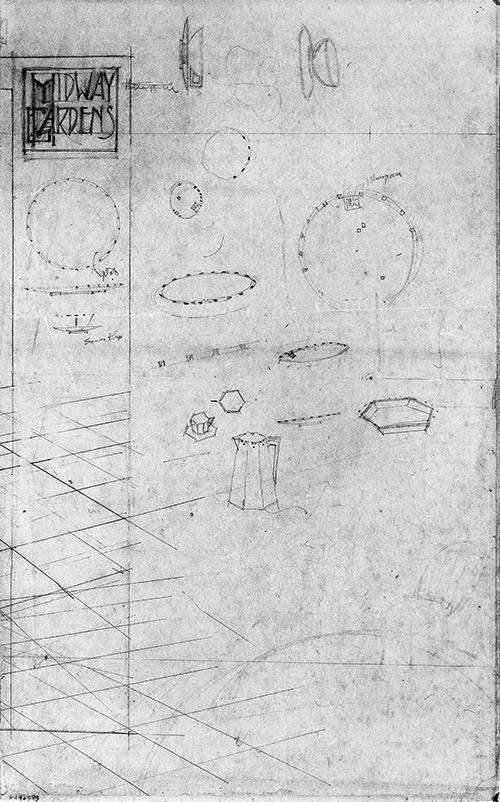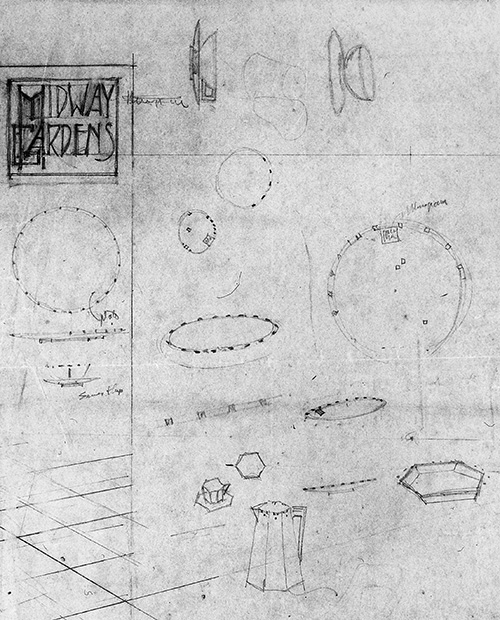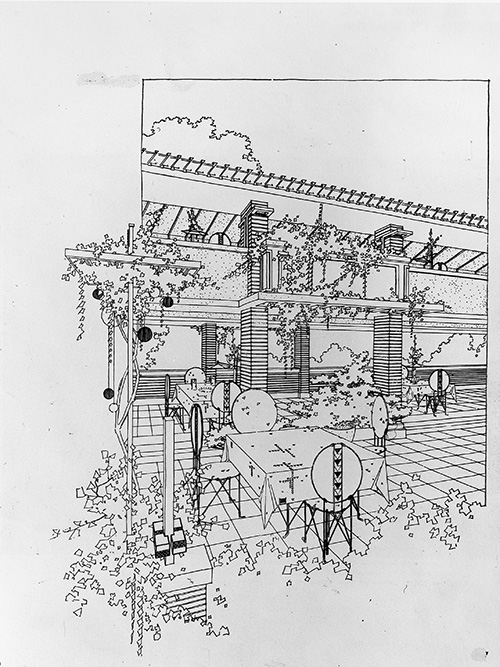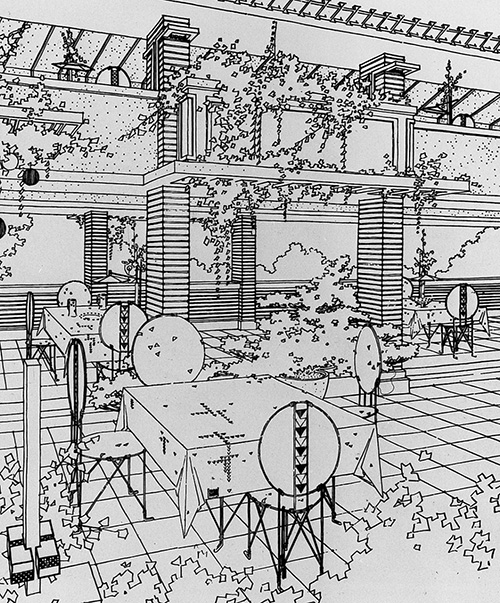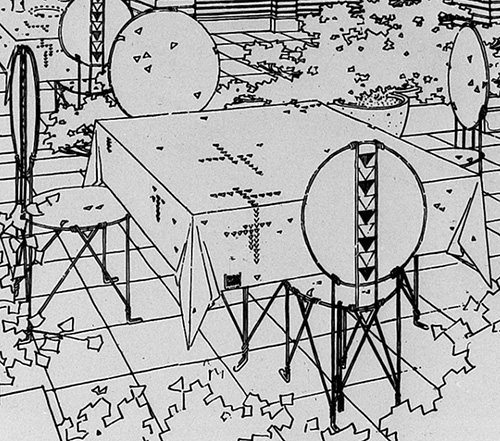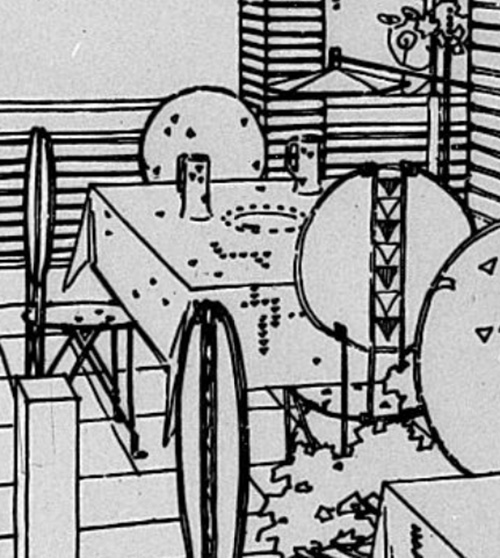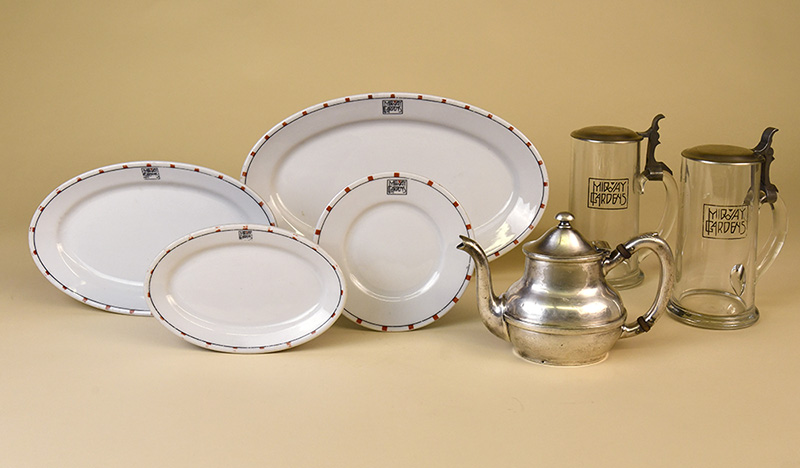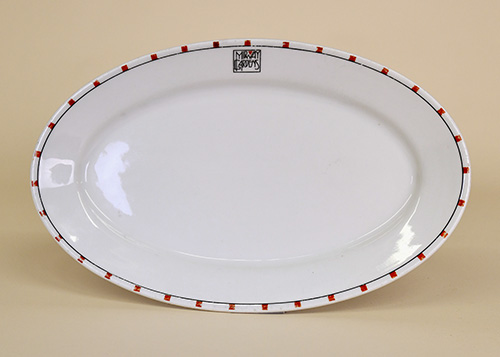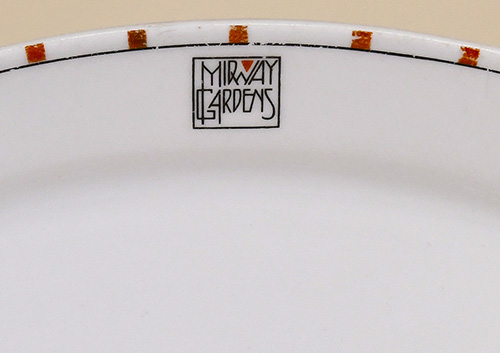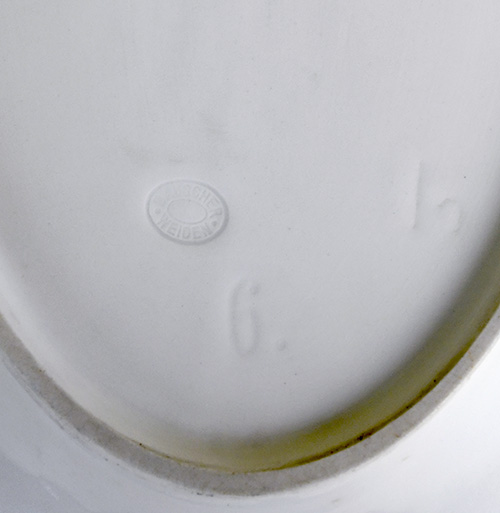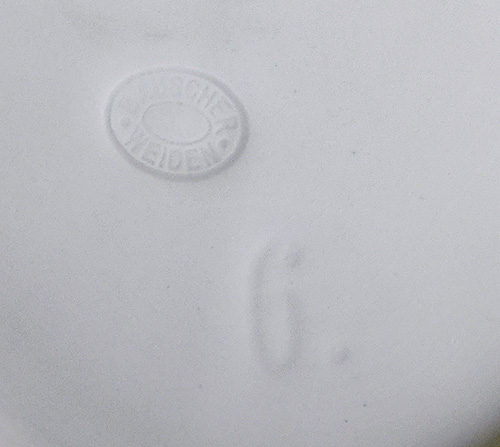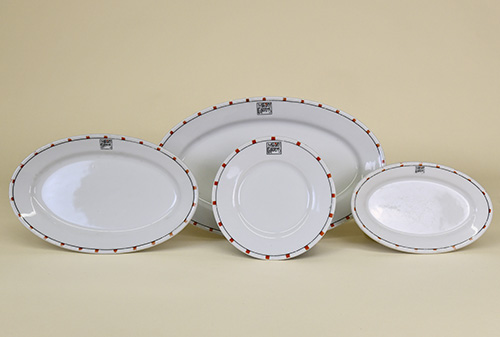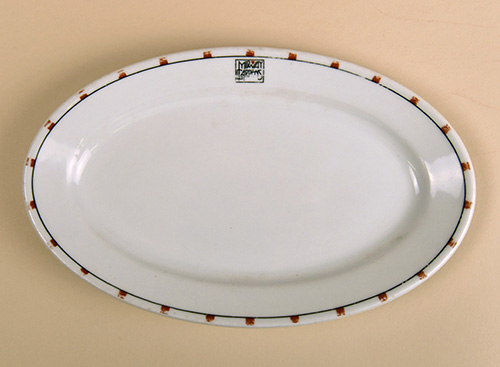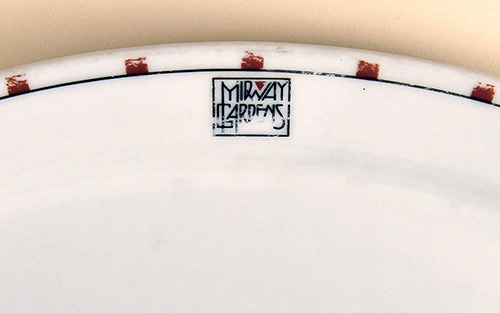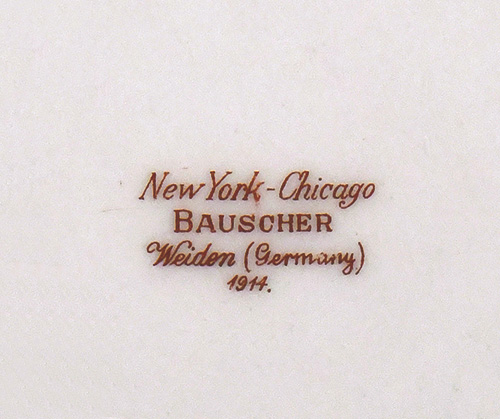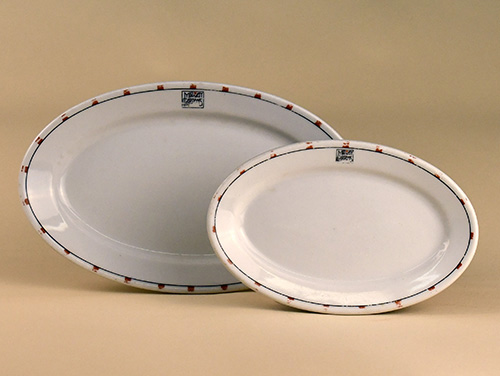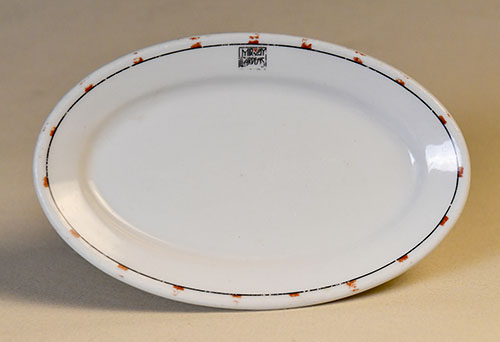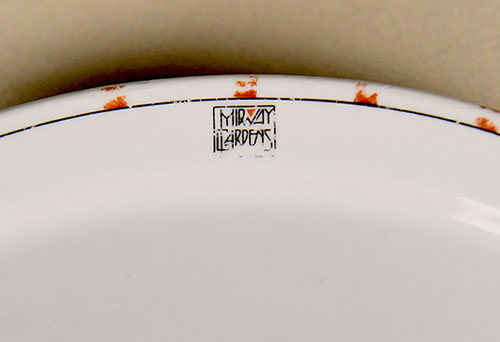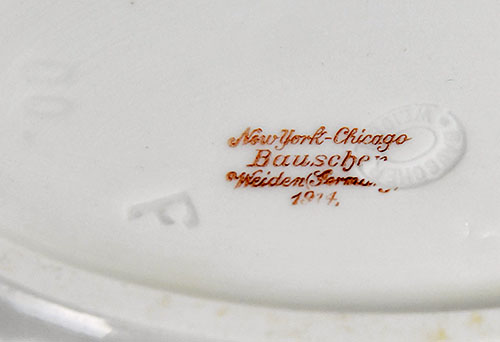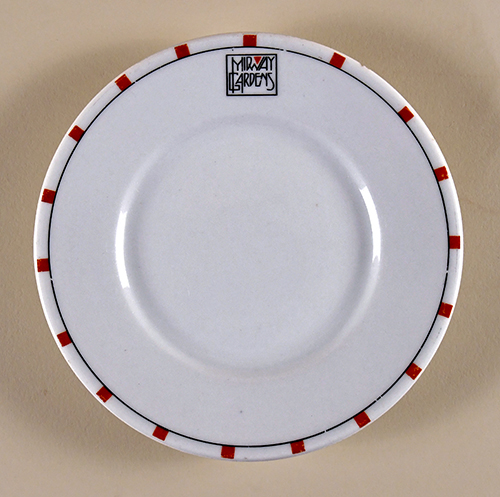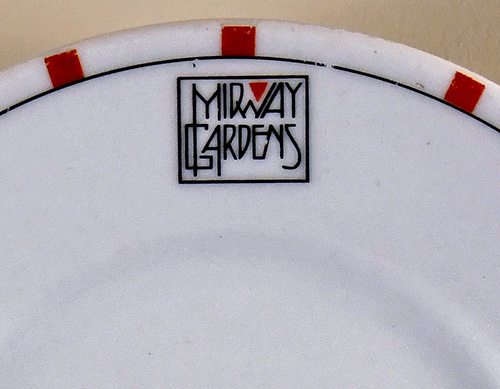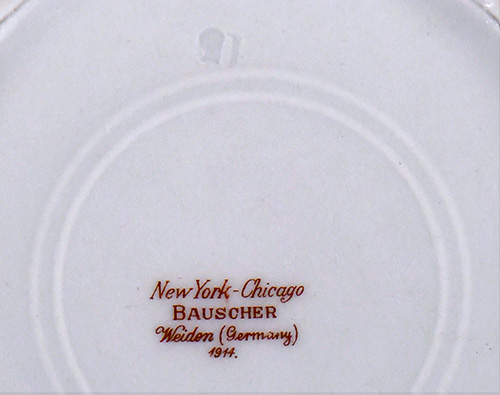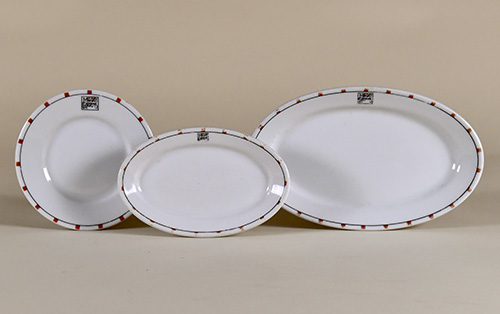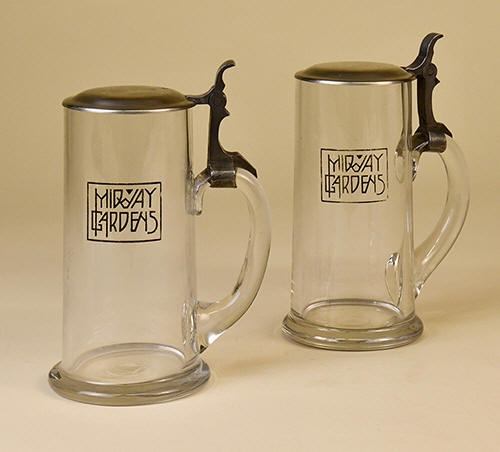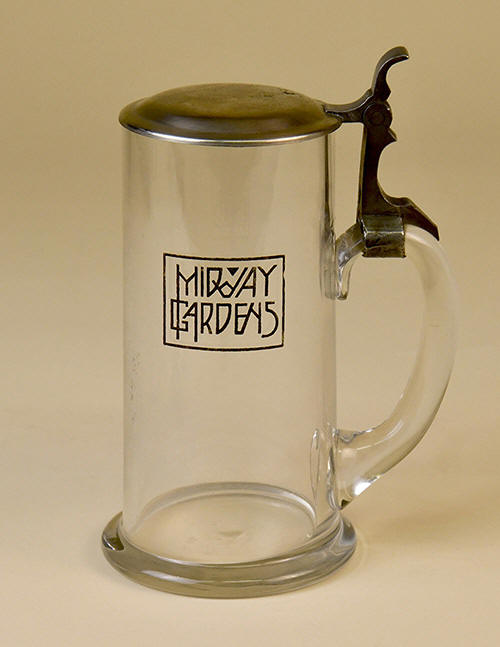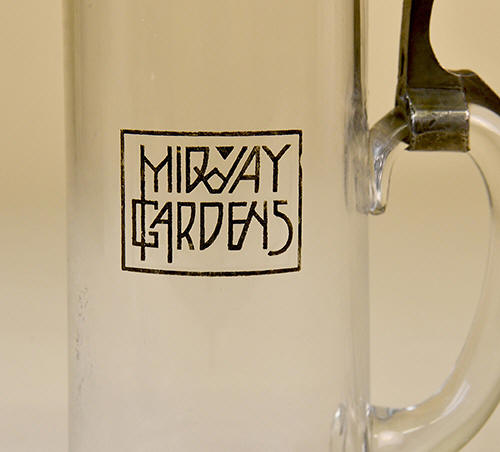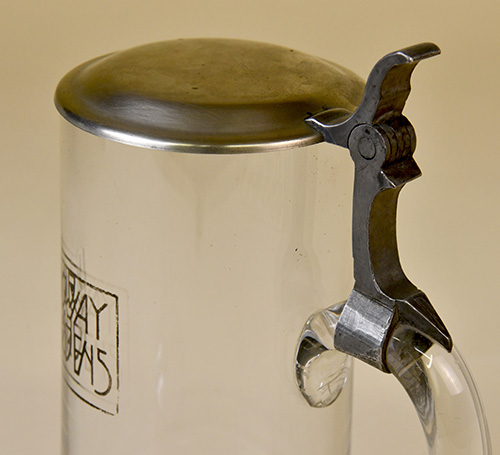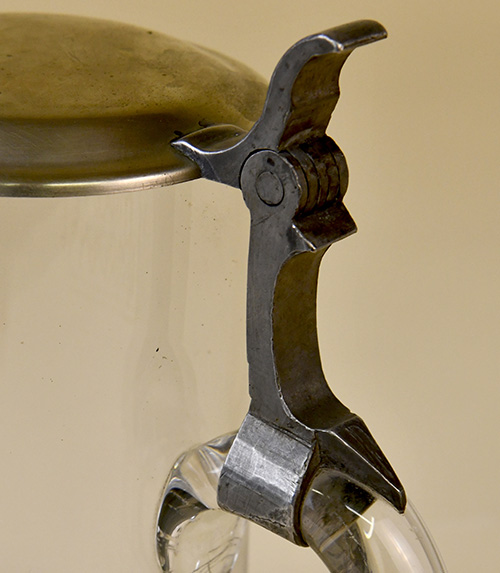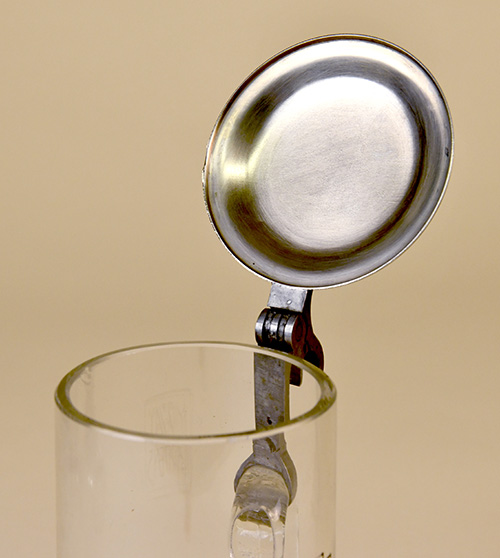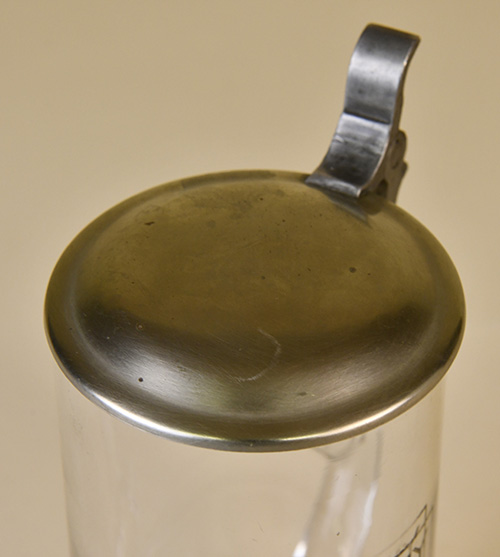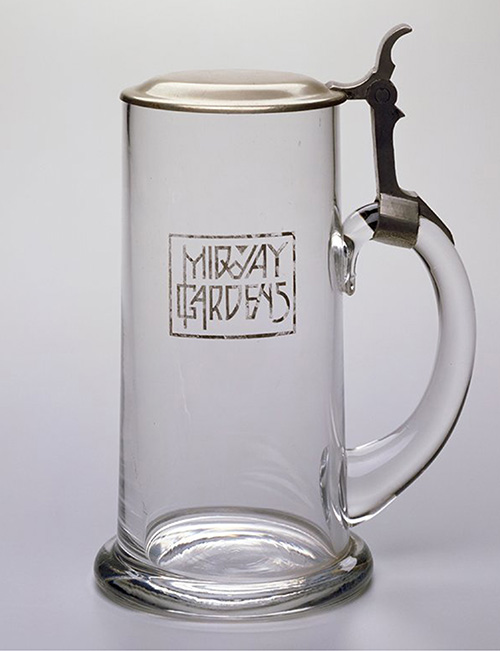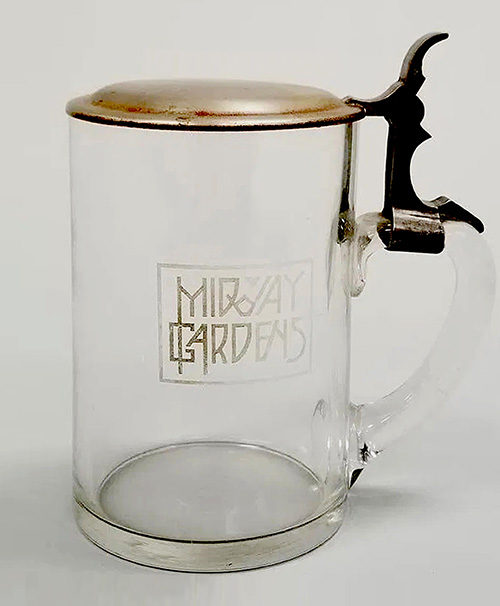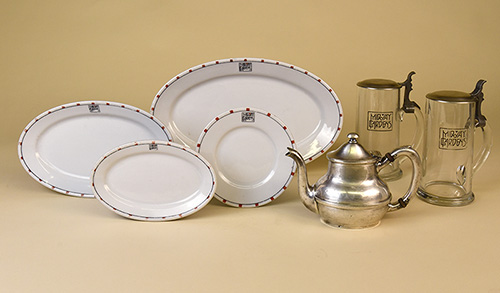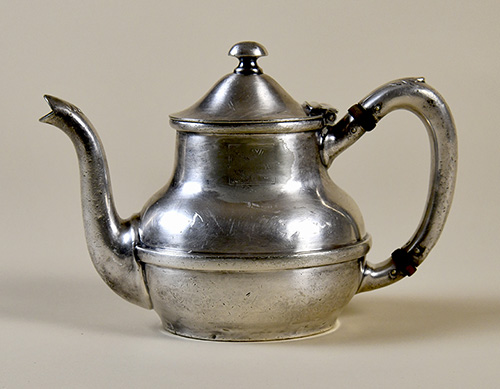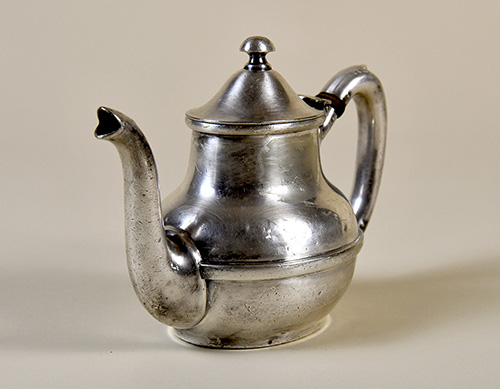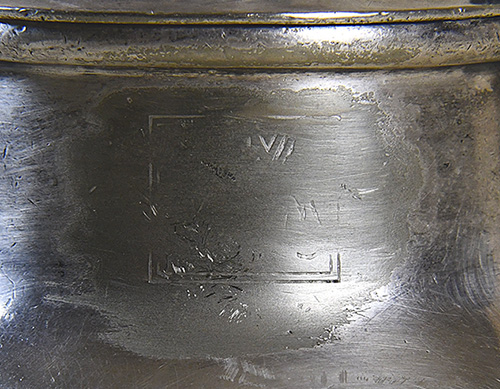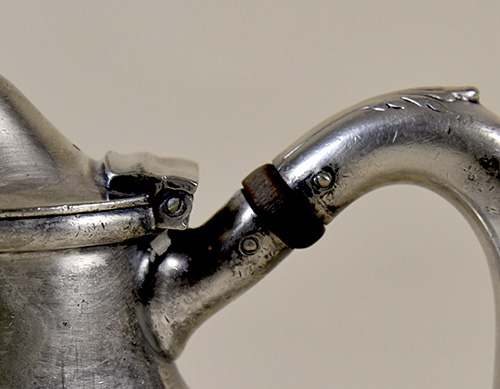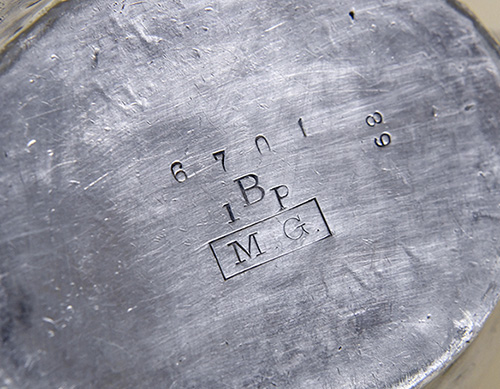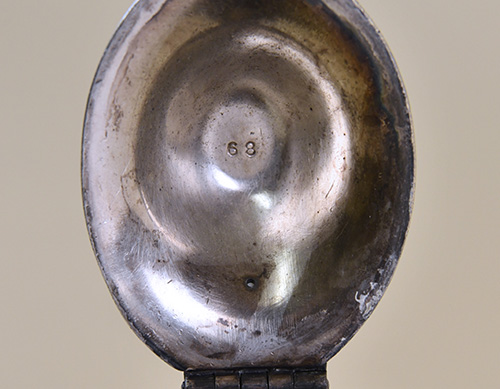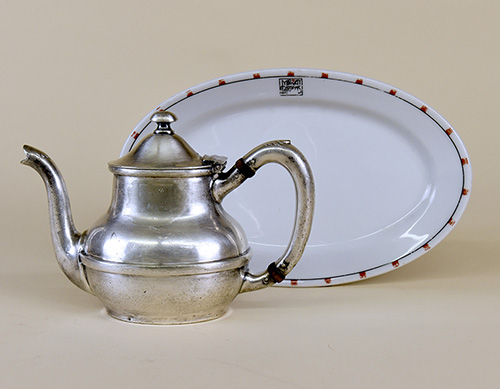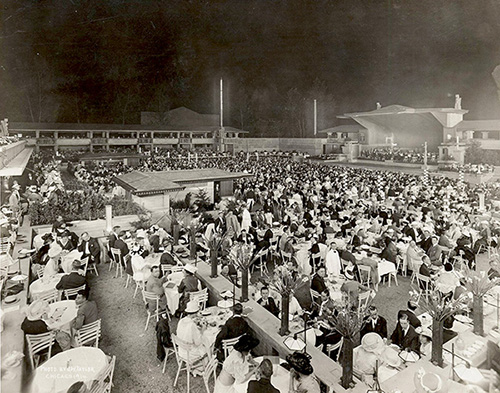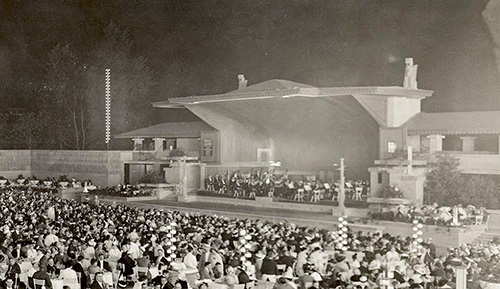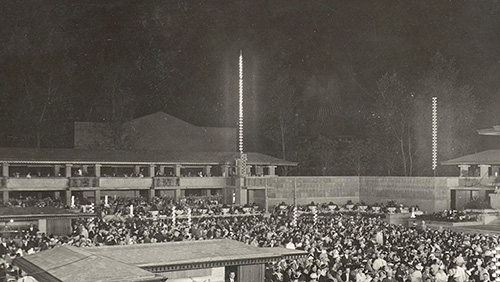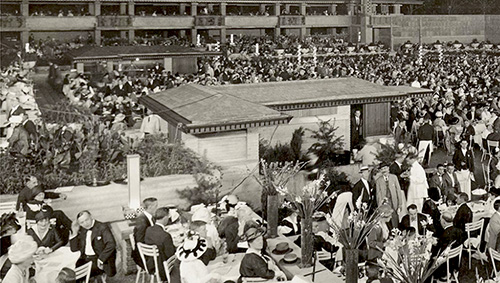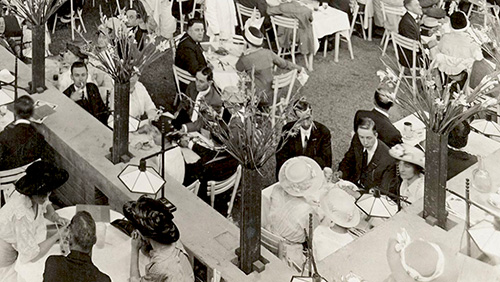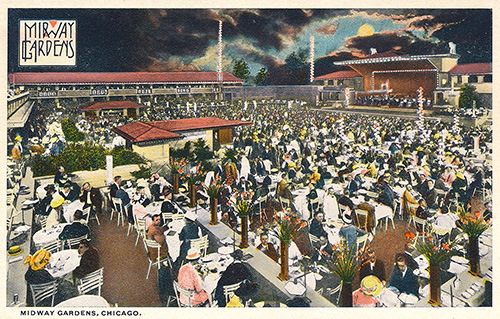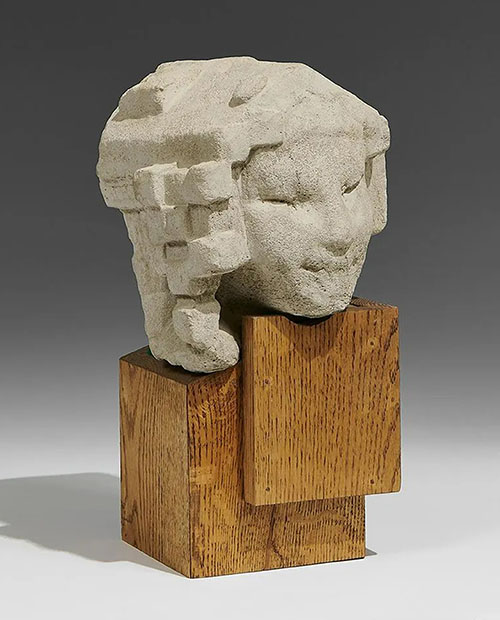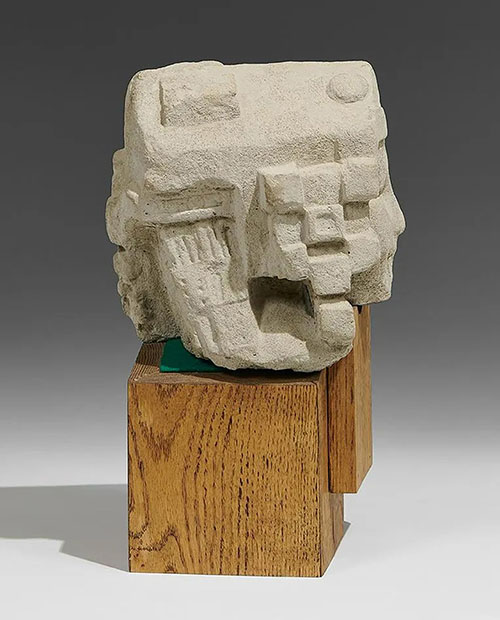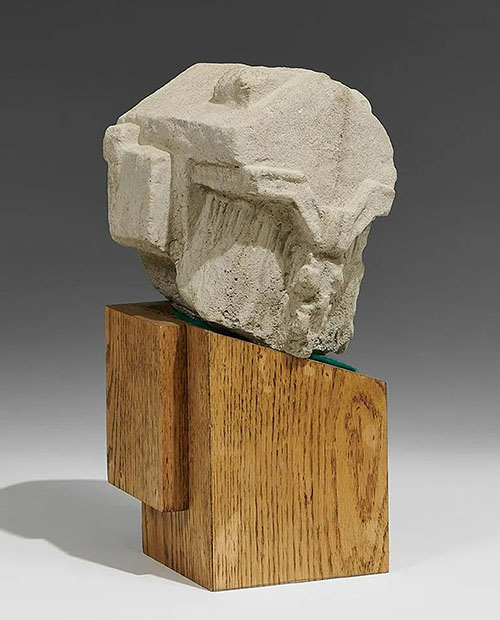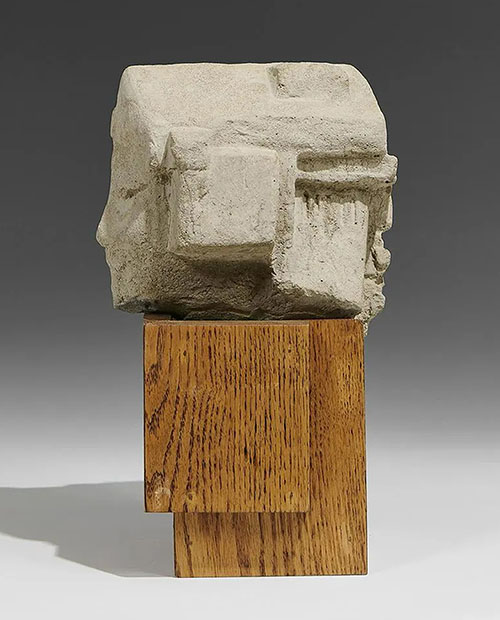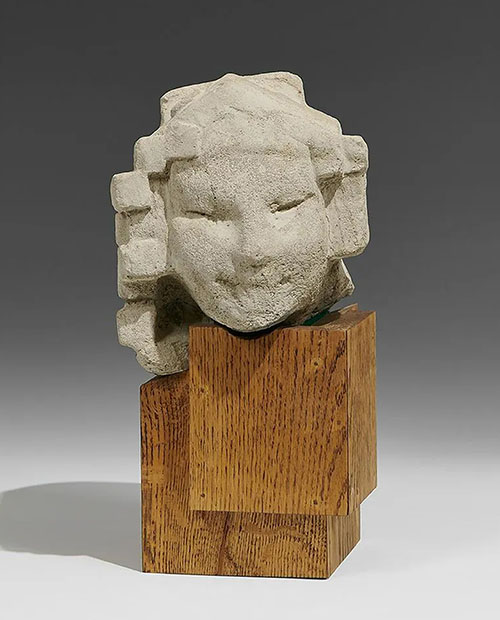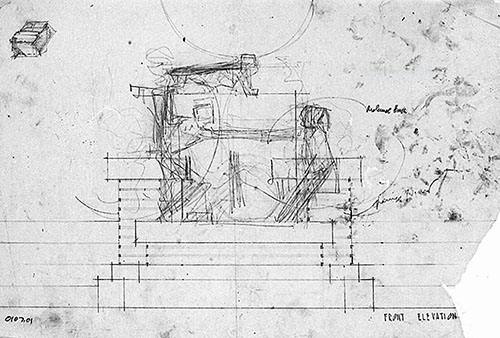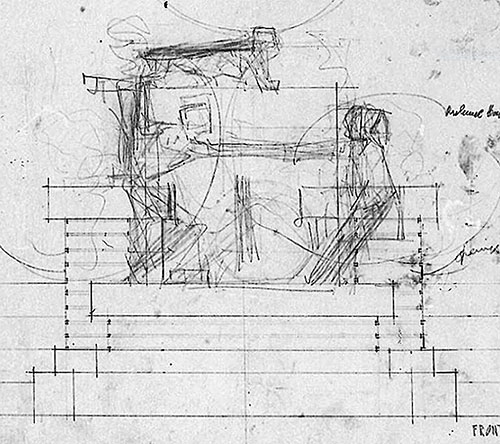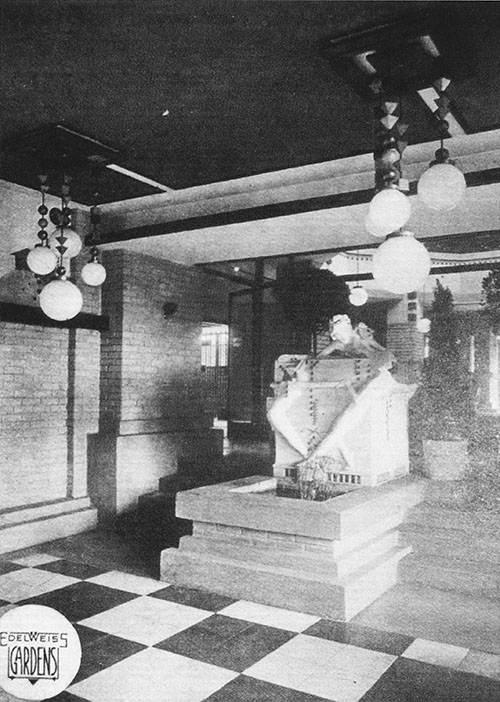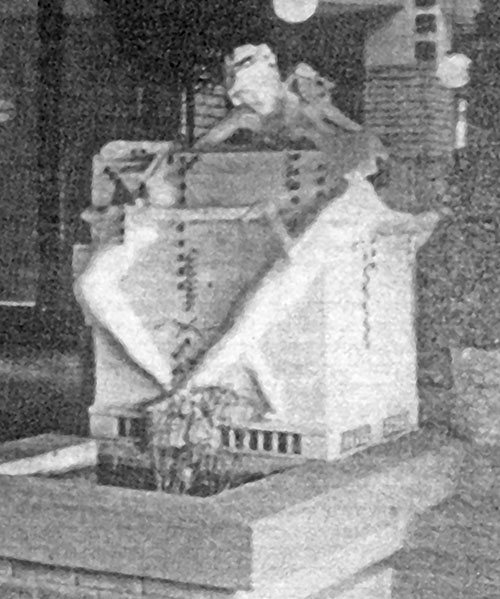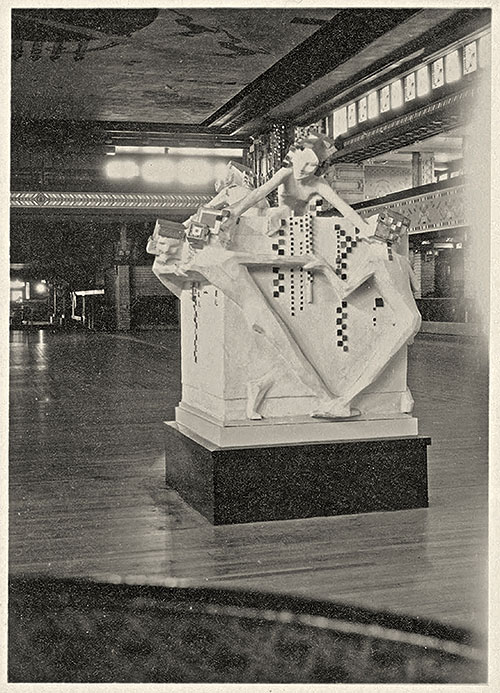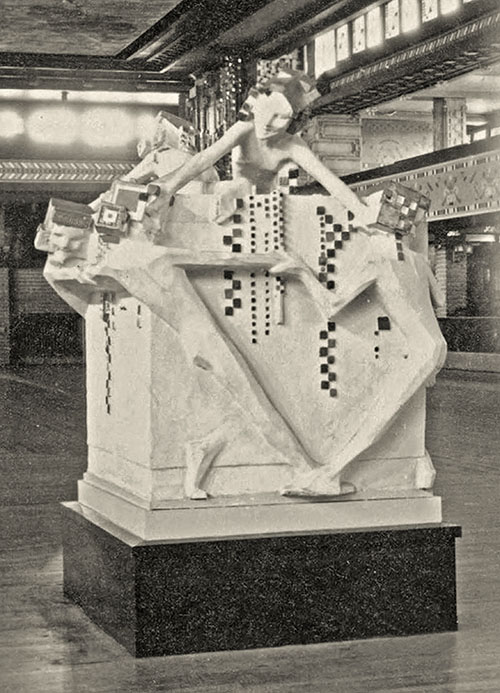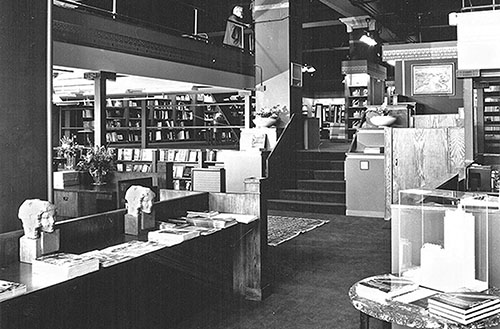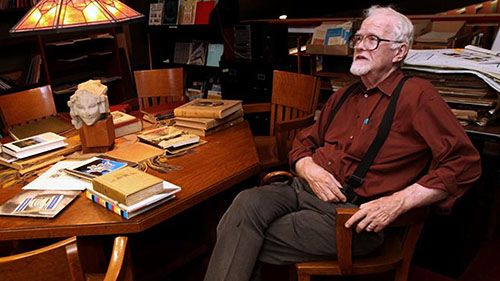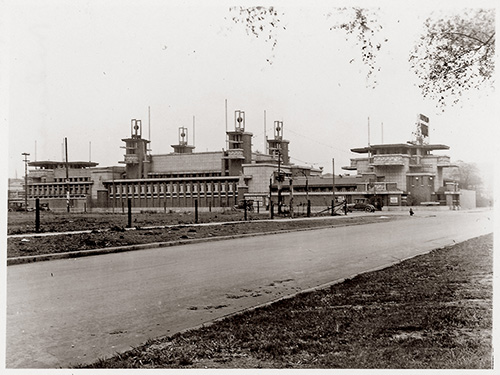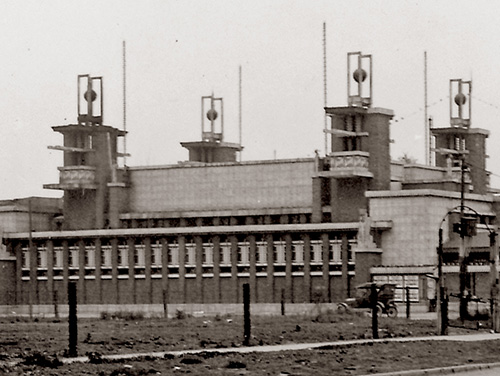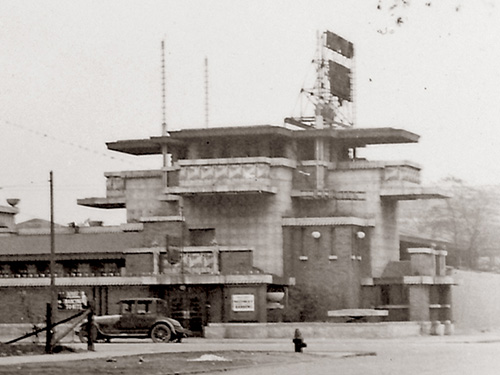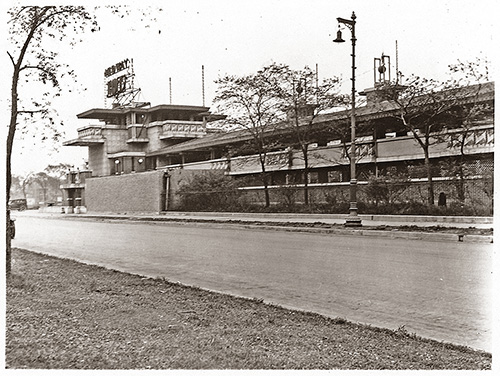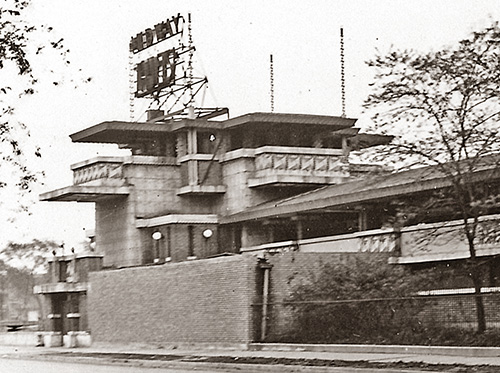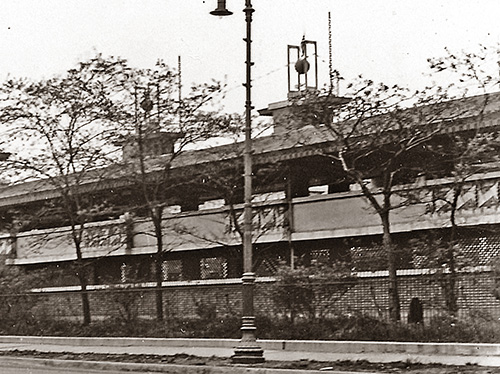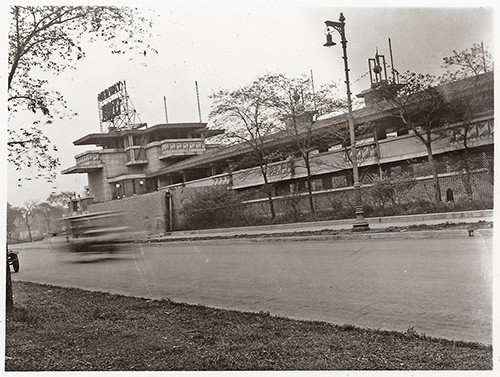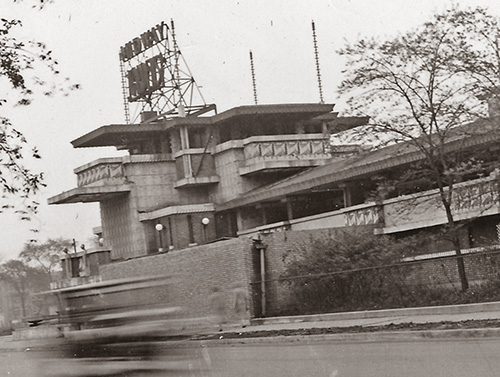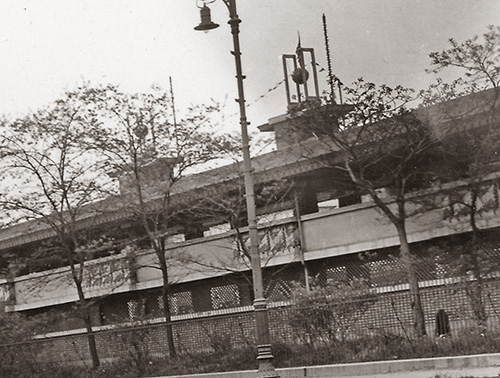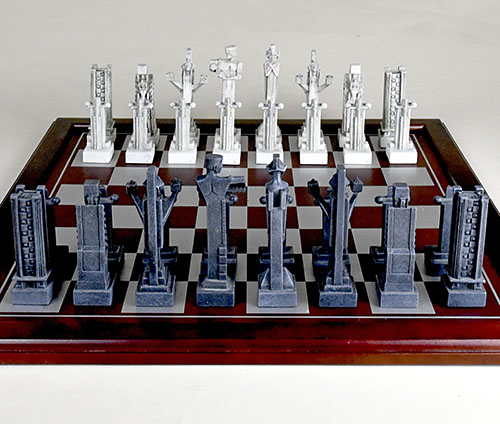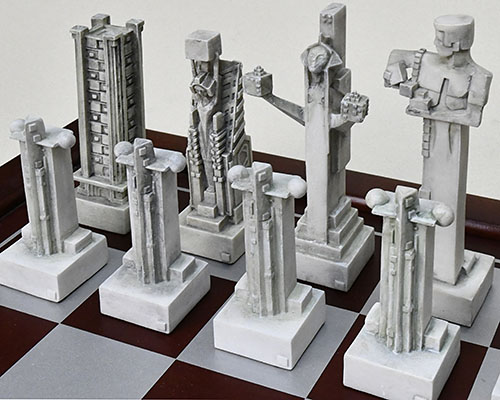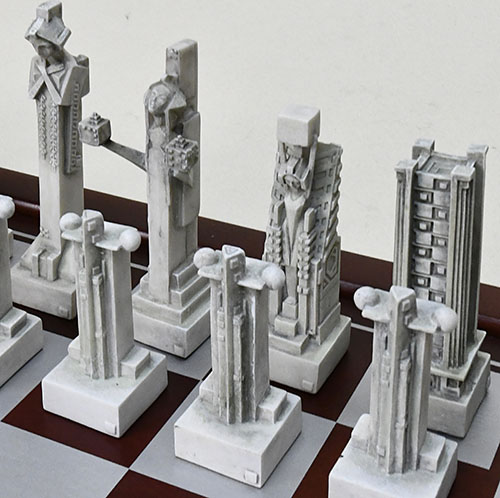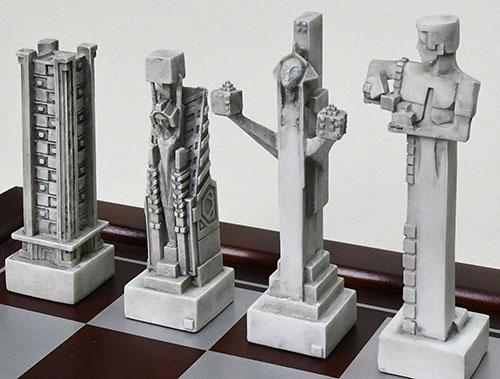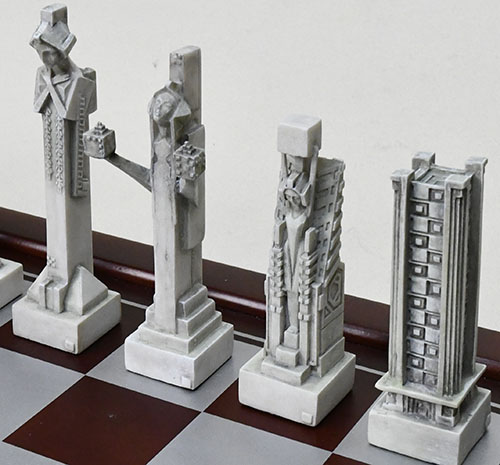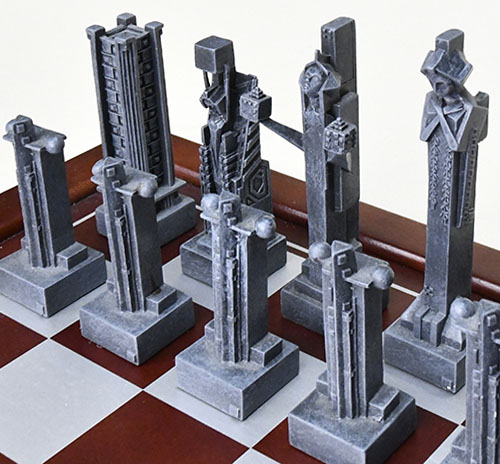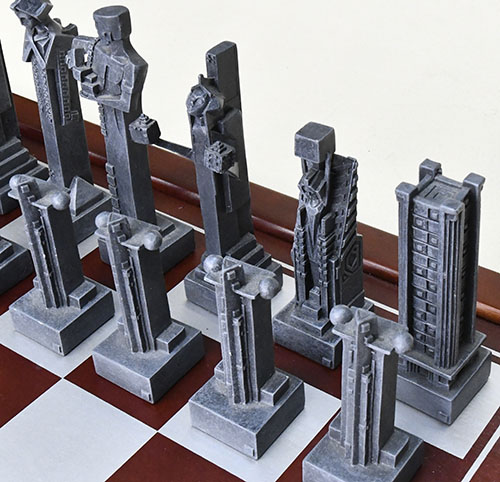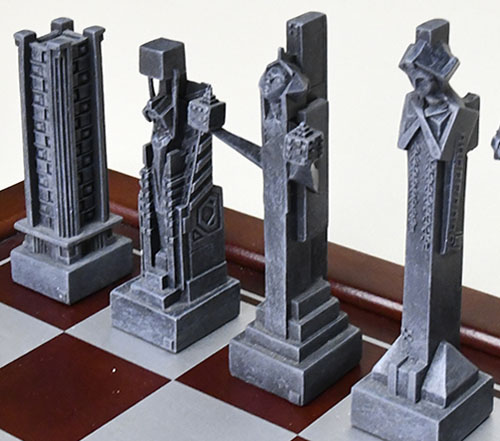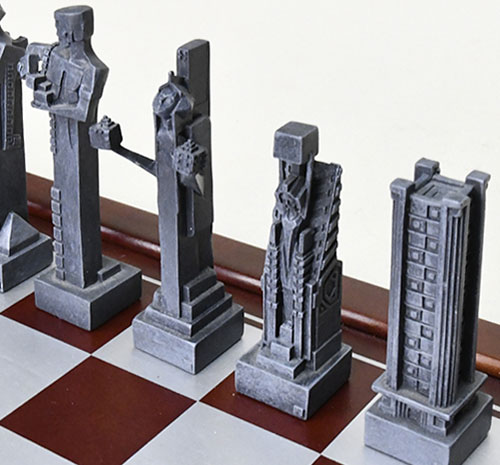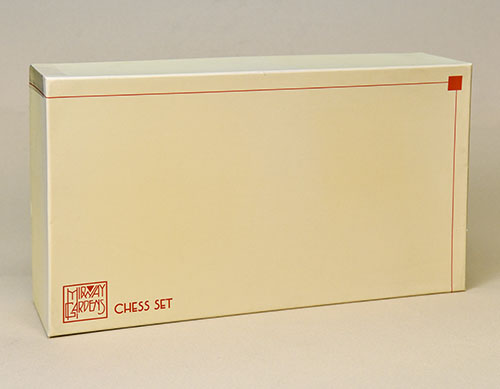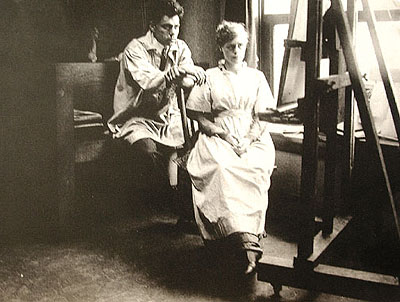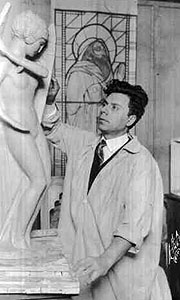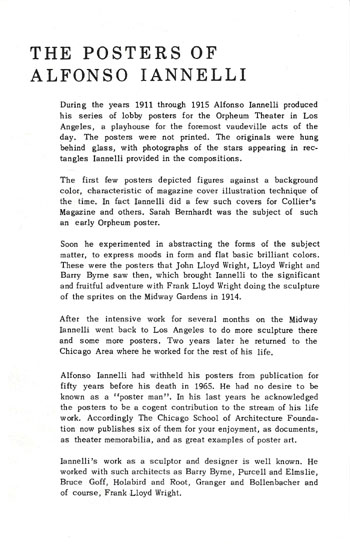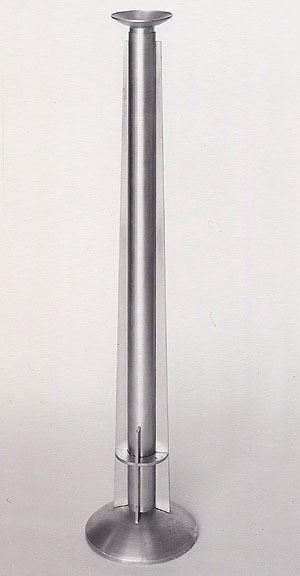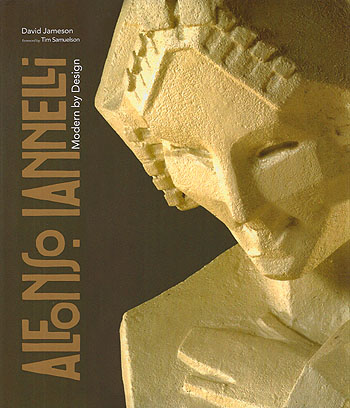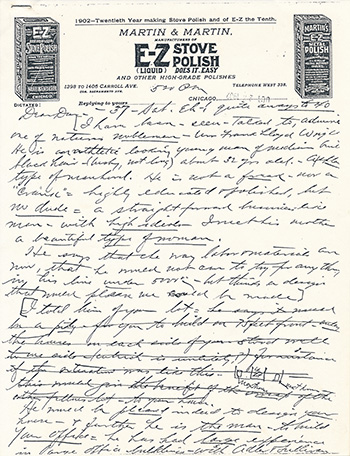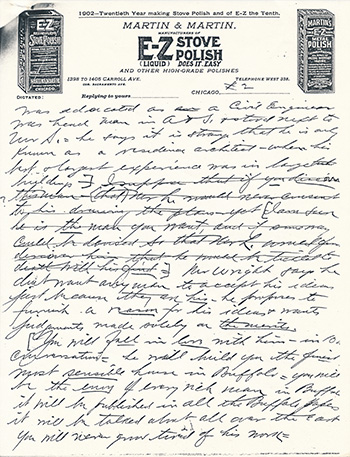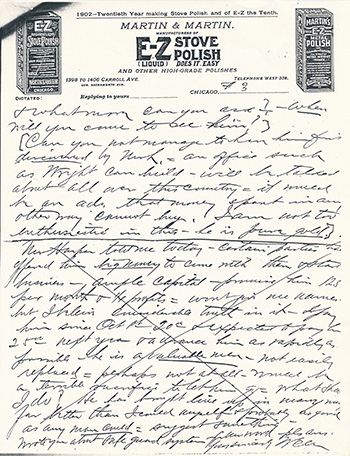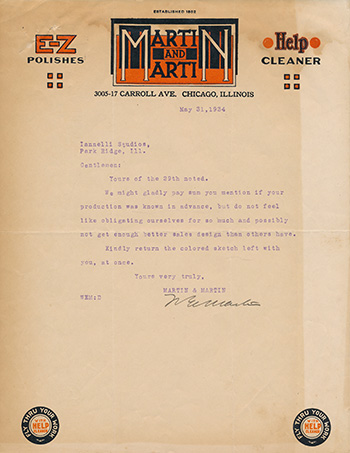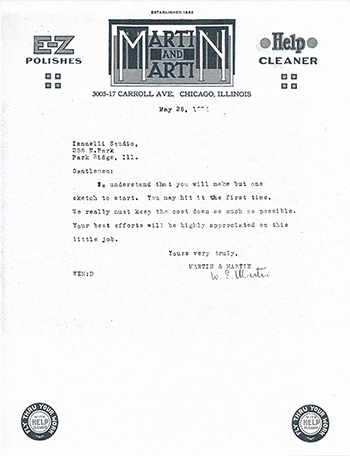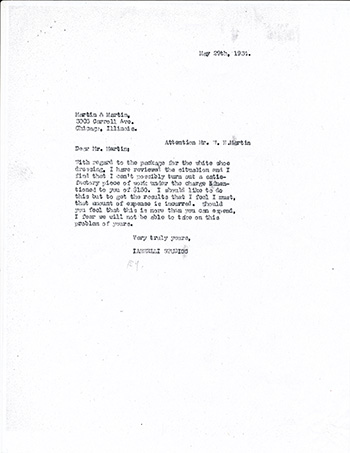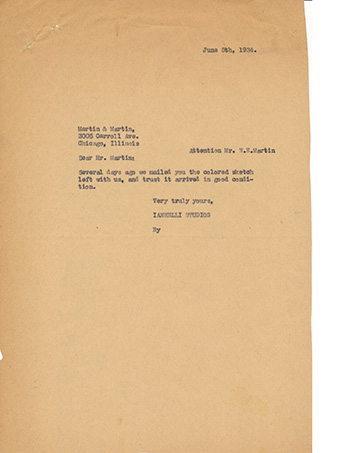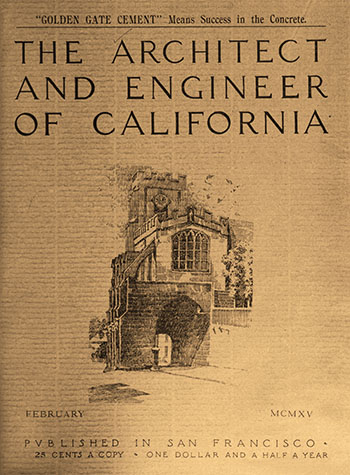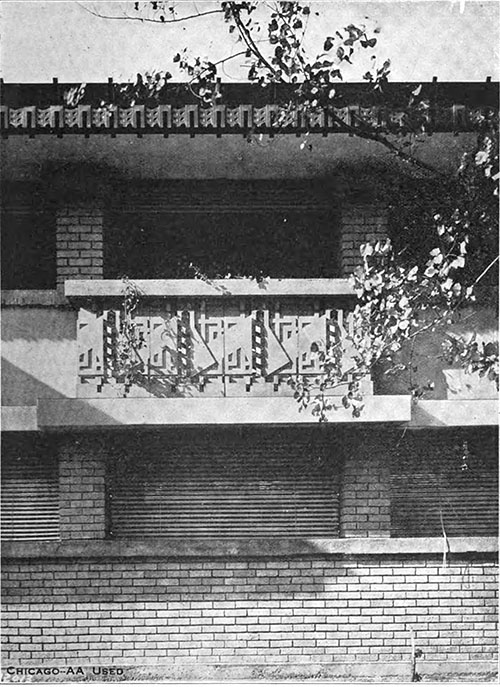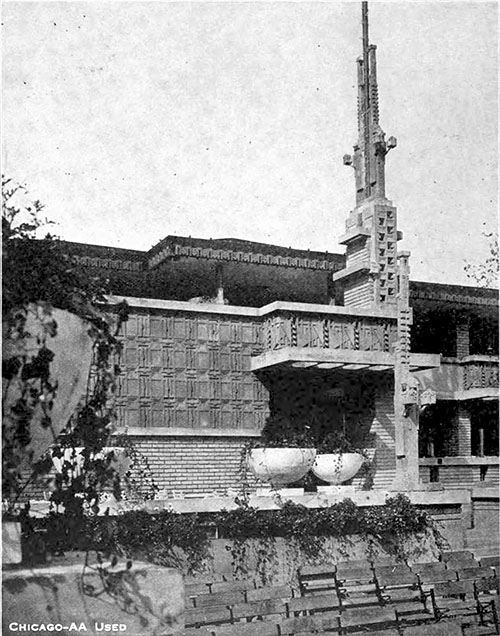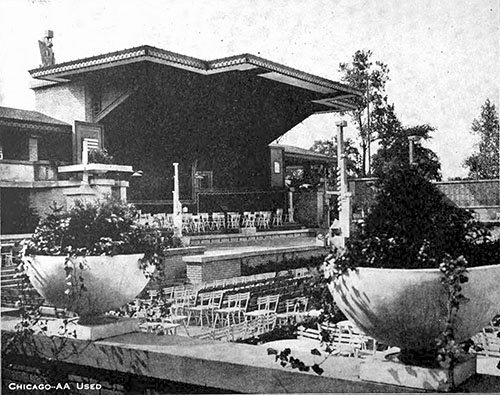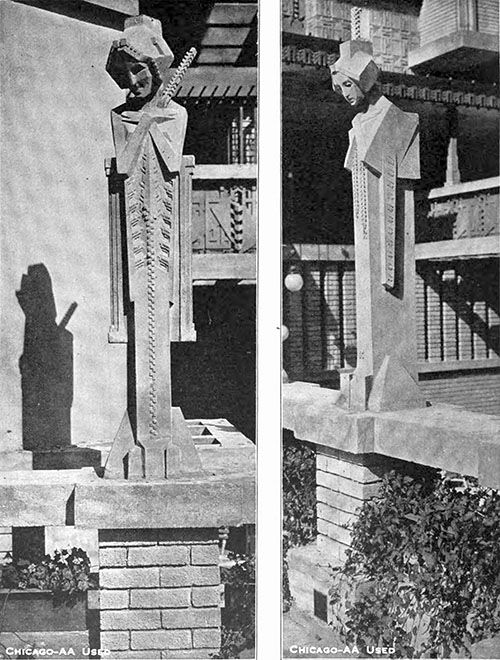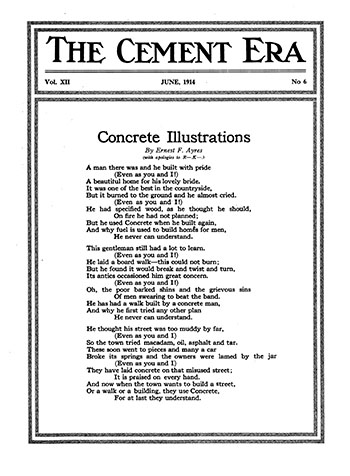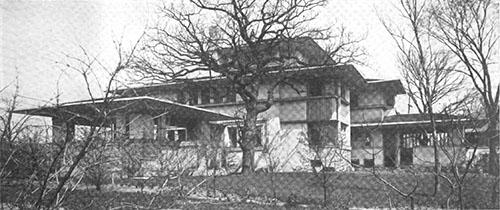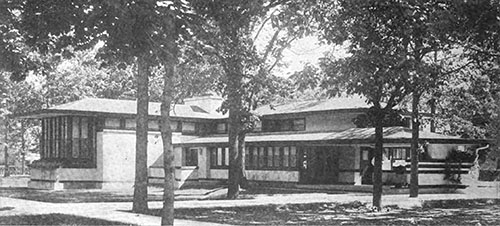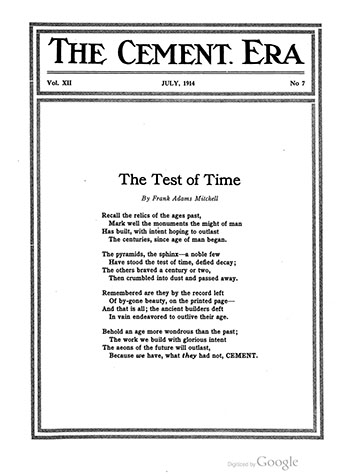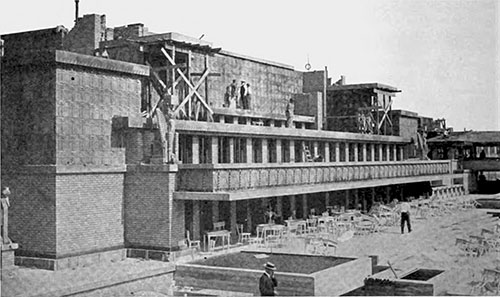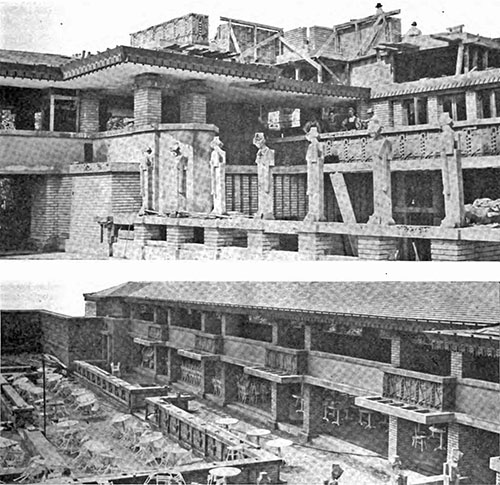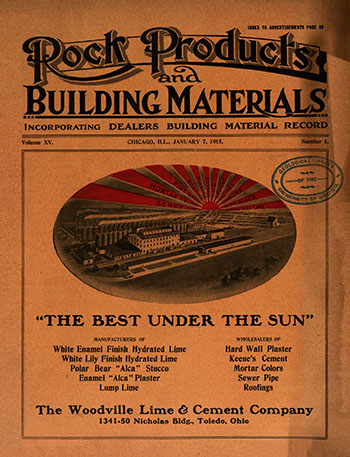
SUPPORT THE
WRIGHT LIBRARY
PROCEEDS FROM EVERY SALE GOES TO SUPPORT THE WRIGHT LIBRARY.
CLICK TO ORDER.
WE PROUDLY SUPPORT THE FRANK LLOYD WRIGHT FOUNDATION
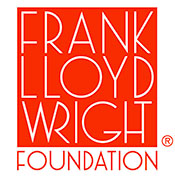
WE PROUDLY SUPPORT THE FRANK LLOYD WRIGHT BUILDING CONSERVANCY
WE PROUDLY SUPPORT FALLINGWATER
AND THE WESTERN PENNSYLVANIA CONSERVANCY

INTRODUCTION / STUDIES For additional information on Midway Gardens see our Wright Study: WRIGHT STUDY ON THE MIDWAY GARDENS
Edward C. Waller was an important early Wright patron. He lived in River Forest near the Wright's William Winslow house. Waller sold Winslow the property upon which his home was built. Waller commissioned several projects to be designed by Wright: the Francisco Terrace Apartments 1895 (S.030) (since demolished); the Waller Apartments 1895 (S.031); the remodeling of his home in River Forest 1899 (S.047); the Edward C. Waller Gates (S.065) and Stables (S.066) 1901; and the Edward C. Waller Bathing Pavilion 1909 (S.166). Waller's son Edward C. Jr. commissioned Midway Gardens 1913 (S.180). Midway Gardens. Designed in 1913, built in 1914, demolished in 1929. It experienced a successful first season in 1914, but that same winter began to feel the chill of World War I in Europe. Night life throughout Chicago suffered. By 1916 matters had not improved. Anna Pavlova, one of the century's greatest ballerinas, danced that season at the Gardens, yet, even her talents could not restore the establishment's initial success. So, Midway Gardens was sold to the Edelweiss Brewing Company in 1916 and turned into a beer garden.
Mr. Wright's well-planned architectural designs and decorations were altered and defaced in an effort by the brewing company to attract an audience. This effort proved unsuccessful. The final blow came in 1920 when Prohibition was declared. Since the open-air patios and the enclosed Winter Gardens were far too visible to be converted to a speakeasy, ownership of the Midway Gardens continued to change hands several times, serving once as a garage and a car wash. The building was finally closed and demolished in October of 1929.
Midway Gardens was bulldozed into Lake Michigan as break wall. The building didn't go down without a fight. Two wrecking companies went out of business trying to demolish the concretestructure. The company that finally took it down still lost a considerable amount of money on the job.
The Sprites were thought to be lost forever. Then sometime after World War II, word reached Taliesin, the original estate and Frank Lloyd Wright School in Spring Green, Wisconsin, that a few of the Sprites had been saved and were lying in pieces in a farmer's field in Lake Delton, Wisconsin. A member of the Midway Gardens wrecking crew either rescued the Sprites from the lake or snatched them before they were destroyed. For years they had lain in his farm field. Taliesin recovered the three damaged Sprites and shipped them to the Stillwater, Minnesota home of Don Lovness, a client and friend of the Wright's. Lovness and his wife restored two 5 to 6-foot Sprites and a 12-foot Sprite. For over 20 years, these figures guarded their Frank Lloyd Wright-designed home.
In 1980, Mrs. Wright built a garden at Taliesin West and had the Sprites shipped to Phoenix for placement. After restoration and recasting work was done on these wandering Sprites, Taliesin Associated Architects donated eight Sprites, each standing 6 feet tall and weighing 450 pounds, to the Arizona Biltmore in October of 1985.
For a different account see the "Dawn Manor" article #15.
Date: Circa 1907
Title: Midway Gardens (1913 - S.180). Sans Souci Amusement Park Circa 1907.
Description: Before Midway Gardens, the Sans Souci Amusement Park covered the grounds where Midway gardens would be built. Sans Souci opened in the Summer of 1899 and closed in 1913. It was Chicago's first amusement park. Text on face: "Sans Souci Amusement Park, 60th Str. and Cottage Grove Ave., Electric Tower and Airships, Chicago." Text on verso: "No. 175. Publ. by Franklin Post Card Co., Chicago, Ill. Made in Germany. Post Card. (58998)."
Size: 3.5 x 5.4
S#: 0080.45.0720Date: 1960/1913
Title: 2) Midway Gardens, Chicago, Illinois, Table Setting 1913 (1913 - S.180).
Description: Presentation view of the Midway Gardens table setting. Frank Llloyd Wright designed the furniture, lamp and dishes. Published in Frank Lloyd Wright Monograph 1907-1913, Pfeiffer, 1991, p.256. FLLW #1401.006.
Size: 18 x 13.5 Diazo Print.
S#: 1458.130.0922 -2Date: 1913
Title: 1) Midway Garden, Chicago, Illinois, Table Setting Illustration 1913 (FLLW#1401.06) (1913 - S.180).
Description: Illustration for the Midway Garden table setting, including table, lamp and vase, linens, china and fruit bowl. There are three side chairs and one tall back arm chair. Designed by Frank Lloyd Wright in 1913, Midway Gardens was built in 1914 and demolished in 1929.
Midway Gardens covered a city block and included the exterior summer garden with performance stage and an interior Winter Garden for year round entertainment. Wright designed the complete structure: furnishings, furniture, sculptures, murals, windows, dinnerware, monogram, a complete work of art. Hand written lower left: “1401.06.” Courtesy of the Frank Lloyd Wright Archives, Avery Library, Columbia University.See Additional Details...
Size: 8 x 9.5 B&W photograph.
S#: 0120.35.1025Date: 1913
Title: 2) Midway Garden, Chicago, Illinois, Study Illustration for Table Setting and Chair 1913 (FLLW#1401.17) (1913 - S.180).
Description: Study illustration for the Midway Garden table setting, including decorative pole, table, chairs, vase, linens and beer stein. There are three chairs at the table, a front and side view to the right. Designed by Frank Lloyd Wright in 1913, Midway Gardens was built in 1914 and demolished in 1929.
Midway Gardens covered a city block and included the exterior summer garden with performance stage and an interior Winter Garden for year round entertainment. Wright designed the complete structure: furnishings, furniture, sculptures, murals, windows, dinnerware, monogram, a complete work of art. Hand written at the top: “Studies Midway Garden Furniture 1913.” Courtesy of the Frank Lloyd Wright Archives, Avery Library, Columbia University. See Additional Details...
Size: 8 x 9.5 B&W photograph.
S#: 0120.36.1025Date: 1913
Title: 3) Midway Garden, Chicago, Illinois, Interior Furniture 1913 (FLLW#1401.20) (1913 - S.180).
Description: Illustration for the Midway Garden table setting and chair design, including the table, lamp and vase, linens, china and fruit bowl. There are two side chairs and one tall back chair at the table. To the left is a front view of the chair. On the right side are designs for the Midway Gardens Monogram, China plate and the cup and saucer. Designed by Frank Lloyd Wright in 1913, Midway Gardens was built in 1914 and demolished in 1929.
Midway Gardens covered a city block and included the exterior summer garden with performance stage and an interior Winter Garden for year round entertainment. Wright designed the complete structure: furnishings, furniture, sculptures, murals, windows, dinnerware, monogram, a complete work of art. Lower text: “Midway Garden, Interior Furniture, Frank Lloyd Wright, Architect.” Hand written lower left: “1401.20.” Hand written lower right: “1913.” FLLW#1401.18 is nearly an exact copy of the illustration. Courtesy of the Frank Lloyd Wright Archives, Avery Library, Columbia University. See Additional Details...
Size: 10 x 8 B&W photograph.
S#: 0120.37.1025Date: 1913
Title: 4) Midway Garden, Chicago, Illinois, Chinaware Study 1913 (FLLW#1401.83) (1913 - S.180).
Description: Illustration for the Midway Garden china and table setting. This includes, left: Midway Garden monogram, plate, cup and saucer. Top: Cup and saucer, chinaware designs. Center: Small red-square pattern, chinaware, hexagonal cup and saucer, coffee pot, dish. Designed by Frank Lloyd Wright in 1913, Midway Gardens was built in 1914 and demolished in 1929.
Midway Gardens covered a city block and included the exterior summer garden with performance stage and an interior Winter Garden for year round entertainment. Wright designed the complete structure: furnishings, furniture, sculptures, murals, windows, dinnerware, monogram, a complete work of art. Hand written lower left: “1401.83.” Courtesy of the Frank Lloyd Wright Archives, Avery Library, Columbia University. See Additional Details...
Size: 6.5 x 10 B&W photograph.
S#: 0120.38.1025Date: 1913
Title: 5) Midway Garden, Chicago, Illinois, Interior View 1913 (FLLW#1401.179) (1913 - S.180).
Description: Interior illustration of Midway Gardens with three table settings. These table and chair settings were never produced for Midway Gardens, but were executed in 1986 by Cassina. Each table is covered with a linen tablecloth. Setting on the table in the background on the left is a lamp, vase, round plate and two beer steins, which are very similar to the beer steins used by Midway Gardens. Setting on the background table on the right is lamp, vase and fruit bowl. Designed by Frank Lloyd Wright in 1913, Midway Gardens was built in 1914 and demolished in 1929.
Midway Gardens covered a city block and included the exterior summer garden with performance stage and an interior Winter Garden for year round entertainment. Wright designed the complete structure: furnishings, furniture, sculptures, murals, windows, dinnerware, monogram, a complete work of art. This illustration was published in Frank Lloyd Wright, A Testament, Wright, 1957, p.117. Courtesy of the Frank Lloyd Wright Archives, Avery Library, Columbia University. See Additional Details...
Size: 8 x 10 B&W photograph.
S#: 0120.39.1025Date: 1913
Title: Midway Garden, Chicago, Illinois, Winter Garden Sculpture Drawing 1913 (FLLW#1401.213) (1913 - S.180).
Description: Drawing for the Winter Garden Sculpture. Designed by Frank Lloyd Wright in 1913, the sculptures were executed by Alfonso Iannelli. Midway Gardens was built in 1914 and demolished in 1929. Two fountains were located in the Winter Garden, one at either end of the promenade. As you enter Midway Gardens through the Belvedere, stairs lead down to the Promenade. This fountain was originally located in the center of the stairs. The promenade lead to the Winter Garden Restaurant. In 1953, Iannelli wrote an essay for his unpublished book. "My last problems were two fountains at the entry of the dining room which was worked out by John (Lloyd Wright) and me on the Cube theme - children sprites playing over and around the Cube - a playful garland of planes winding over and around, protruding and receding into the mass. Mr. Wright made some suggestions as it was being carried out." Alfanso Iannelli, Jameson, 2013, p.80-81. Hand Written lower left: "0107.01." It was later renumbered "1401.213." Text lower right: "Front Elevation." Courtesy of the Frank Lloyd Wright Archives, Avery Library. See Additional Details...
Size: 10 x 6.75 B&W photograph.
S#: 0120.27.0122Date: 1914
Title: Midway Gardens, Chicago, Illinois, Fuermann Photographs, 1914 (1913 - S.180).
Description: Set of 23 historic photographs by Henry Fuermann & Sons, documenting Midway Gardens in September 1914. Henry Fuermann & Sons photographed many of the buildings in the Chicago area. These Midway Gardens images photographed in 1914 are an invaluable record of Wright's Masterpiece. The Images are the most complete record of Midway Gardens as Wright envisioned it.
“Midway Gardens was an indoor and outdoor facility. It was comprised of a music pavilion and stage, arcades on either side of the terraced summer gardens, an indoor lobby, club, tavern, two belvederes, promenades, cigar concession stands, two sunken gardens and pools, dance floors, cantilevered balconies, terraces, gardens and courtyards. He used bricks and concrete blocks with designs. Wright not only designed the building but also the wall murals, concrete... Continue...
Size: Multiple sizes.
S#: 0124.84.1025 (1-23)
See Additional Photographs...
See Additional Photographs...Date: 1914
Title: Midway Gardens Large Oval Platter, Chicago, Illinois, 1914 (1913 - S.180).
Description: Original large glazed porcelain oval platter. Designed for Midway Gardens, Chicago, by Frank Lloyd Wright. Midway Gardens covered a city block and included the exterior summer garden with performance stage and an interior Winter Garden for year round entertainment. Wright designed the complete structure: furnishings, furniture, sculptures, murals, windows, dinnerware, monogram, a complete work of art.
The Midway Garden monogram and plate designed by Frank Lloyd Wright. The platter is bordered with red squares, approximately 0.1875" x 0.1875." On the inside edge of the squares is a black oval line. The red squares are approximately .75 inches apart. The monogram is black lettering within a black rectangle, with a small red triangle. Manufacturer's mark is impressed in the base: "Bauscher Weiden." Also impressed in the base is “6.” and maybe “h”. Provenance: Midway Gardens, Chicago / Private Collection, Owner of the Ward W. Willits House, Highland Park, IL. Acquired from Toomey & Co., 2024. See Additional Details...
Size: Large platter. 12.9" Wide by 8" Deep x 1.375" High.
S#: 0124.78.1024Date: 1914
Title: Midway Gardens Medium Oval Platter, Chicago, Illinois, 1914 (1913 - S.180).
Description: Original medium glazed porcelain oval platter. Designed for Midway Gardens, Chicago, by Frank Lloyd Wright. Midway Gardens covered a city block and included the exterior summer garden with performance stage and an interior Winter Garden for year round entertainment. Wright designed the complete structure: furnishings, furniture, sculptures, murals, windows, dinnerware, monogram, a complete work of art.
The Midway Garden monogram and plate designed by Frank Lloyd Wright. The platter is bordered with red squares, approximately 0.1875" x 0.1875." On the inside edge of the squares is a black oval line. The red squares are approximately .75 inches apart. The monogram is black lettering within a black rectangle, with a small red triangle. Stamped manufacturer's mark and date to underside in red: "New York-Chicago Bauscher Weiden (Germany) 1914". Provenance: Midway Gardens, Chicago; Private Collection. Toomey & Co., Chicago. Acquired from Toomey & Co., 2024. See Additional Details...
Size: Large platter. 9.75" by 6".
S#: 0124.67.0324Date: 1914
Title: Midway Gardens Small Oval Platter, Chicago, Illinois, 1914 (1913 - S.180).
Description: Original small oval platter. Designed for Midway Gardens, Chicago, by Frank Lloyd Wright. Midway Gardens covered a city block and included the exterior summer garden with performance stage and an interior Winter Garden for year round entertainment. Wright designed the complete structure: furnishings, furniture, sculptures, murals, windows, dinnerware, monogram, a complete work of art.
The Midway Garden monogram and the design of the plate is by Frank Lloyd Wright. The platter is bordered with red squares, approximately 0.1875" x 0.1875." On the inside edge of the squares is a black oval line. The red squares are approximately .75 inches apart. The monogram is black lettering within a black rectangle, with a small red triangle. Marked on the bottom in red: "New York-Chicago Bauscher Weiden (Germany) 1914". Impressed mark in oval: "Bauscher Weiden." Separate impressions: "00" and “F.” See Additional Details...
Size: Small platter. 7" by 4.5".
S#: 0124.64.0224Date: 1914
Title: Midway Gardens Small Plate, Chicago, Illinois, 1914 (1913 - S.180).
Description: Original small glazed porcelain plate. Designed for Midway Gardens, Chicago, by Frank Lloyd Wright. Midway Gardens covered a city block and included the exterior summer garden with performance stage and an interior Winter Garden for year round entertainment. Wright designed the complete structure: furnishings, furniture, sculptures, murals, windows, dinnerware, monogram, a complete work of art.
The Midway Garden monogram and plate were designed by Frank Lloyd Wright. The plate is bordered with red squares, approximately 0.1875" x 0.1875." On the inside edge of the squares is a black circular line. The red squares are approximately .75 inches apart. The monogram is black lettering within a black rectangle, with a small red triangle. Stamped manufacturer's mark and date to underside in red: "New York-Chicago Bauscher Weiden (Germany) 1914". Impressed in the base is a barely visible “15.” Provenance: Midway Gardens, Chicago; Private Collection. See Additional Details...
Size: Small plate, 5.875."
S#: 0124.69.0724Date: 1914
Title: Midway Gardens, Chicago, Illinois, Beer Steins, 1914 (1913 - S.180).
Description: Two original beer steins from the Midway Gardens, 1914. Midway Gardens covered a city block and included the exterior summer garden with performance stage and an interior Winter Garden for year round entertainment. Designed by Frank Lloyd Wright in 1913. He designed the complete structure: furnishings, furniture, sculptures, murals, windows, dinnerware, monogram, a complete work of art.
The Frank Lloyd Wright Archives at the Avery Library, Columbia University hold 174 original drawings for Midway Gardens. There are six that illustrate table settings: 1) 1401.06: Chairs, Table, Lamp, Tableware. 2) 1401.17: Table, Chair, Linen, Parasol. 3 & 4) 1401.18 & 20: Wood Chair, Table, Lamp, China. 5) 1401.83: Chinaware Studies. 6) 1401.179: Table, Chair. There are no specific designs for beer mugs, unlike designs for china. But there are two drawings with beer mugs, slightly different in design. We surmise that these mugs may have been ordered out of a catalog and imprinted with the monogram Frank Lloyd Wright designed.
What is clear is the monogram imprinted on the glass. The Wright designed monogram appeared in four drawings: 1401.18 & 20; 1401.83 and 1401.179. It was prominently placed on the china and tea pot. The black monogram imprinted on each glass is 1.75" Wide x 1" High. The metal handle (strap, strap support, hinge and thumblift) are pewter and the lid appears to be a sturdier metal. Unlike the Midway Garden teapot, there are no markings on either the inside of the lid or the base of the glass.
The beer stein appears to have been produced in two sizes. This taller 7" beer stein and a shorter 5.75" tall. The shorter was sold at auction in St. Paul, Minnesota in 2024.
These two beer steins are very well preserved. Acquired from an estate sale in Indiana,Their last name was Stout. They had a large collection of beer steins. See Additional Details...
Size: The glass is 6.25" tall, the base is 3.5" and the top is 2.75". With the glass handle it is 4.9" deep. The total height with metal handle is 7" tall.
S#: 0124.83.0925 (1-2)
Date: 1914
Title: Midway Gardens Teapot, Chicago, Illinois, 1914 (1913 - S.180).
Description: Original silver-plate teapot from the Midway Gardens. The Midway Gardens was designed by Frank Lloyd Wright in 1913. It covered a city block and included the exterior summer garden with performance stage and an interior Winter Garden for year round entertainment. Wright designed the complete structure: furnishings, furniture, sculptures, murals, windows, dinnerware, monogram, a complete work of art.
The Frank Lloyd Wright Archives at the Avery Library, Columbia University holds 174 original drawings for Midway Gardens. There are four that relate to the interior table settings: 1) 1401.113 (47): Midway Gardens Two Chairs. 2) 1401.179 (53): Midway Gardens Dining Room Table / Chair Setting Perspective. 3) 1401.20 (62): Midway Gardens Furniture, Linen, Lamp, China, Monogram. 4) 1401.83 (172): Midway Gardens Chinaware Studies. This includes plates, Coffee/Teapot, and tee cup.
It is very clear that Frank Lloyd Wright designed the monogram that is engraved on this teapot, but there is no evidence that he designed the teapot itself. The “Coffee / Teapot” he designed in 1401.83 is clearly a Wright design. We surmise that this teapot was ordered out of a catalog and engraved with the monogram frank Lloyd Wright designed. Unlike the ceramic plates and platters where Wright designed the plates and the monogram, we would conclude the monogram was designed by Wright, but not the teapot.
The teapots were produced in two sizes. This was the smaller of the two. The larger may have been a coffee pot. It is 7.25" long, 3,25" wide and 5" tall. Impressed in the base: “6701", the manufacturer’s model number; “IBP”, possibly the manufacturer Independent Birmingham Potters; “M. G.” within a rectangle, (Midway Gardens), and “68,” the number of the teapot. There is a “68" imprinted on the inside of the teapot’s lid. It appears that each teapot was sequentially numbers. The handle is insulated with a small piece of bone.
Sometime during the last 100 years, someone desecrated the teapot by attempting to grind off the Midway Garden monogram. But they failed to fully remove it, and in the process removed part of the silver plating. See Additional Details...
Size: 7.25" long, 3,25" wide and 5" tall
S#: 0124.80.0625Date: Circa 1914
Title: Midway Gardens Dish (Midway Gardens, 1913 - S.180).
Description: Frank Lloyd Wright designed many decorative details for the Midway Gardens. Was this silver dish (above) produced for Wright's Midway Gardens or some other? That was the question we attempted to unravel. We did an extensive search through everything that was published about the Midway Gardens. We also contacted the Meriden Historical Society... Continue...
Size: 5.5" x 1". Inner bowl 3.75".
S#: 0124.11.0110Date: 1914 Title: Midway Garden Sprite.
Description: Chicago Architectural Photographing Company, Chicago. Original gelatin silver photograph printed by photographer Clarence Fuermann (1883-1983). Printed in the early 1960s from the original negative (1913-14). Clarence Fuermann of Henry Fuermann and Sons. The original image was published in "The Life-Work of the American Architect Frank Lloyd Wright" 1925, page 76, center.
Size: 8 x 10
S#: 1407.01.0406
Date: Circa 1914 Title: Midway Garden (1913 - S.180) Male Sprite 1913-14.
Description: Male sprite holding a geometric dodecahedron, in the Northeast corner of the Winter Garden. This sculpture appeared only once in the Midway Gardens. In the May, 1915 issue of "The International Studio" the caption read "Sprites designed by Frank Lloyd Wright, executed by Alfonso Iannelli". A dispute arose between Iannelli and Wright as to who designed the sculptures. Published in "Life Work of the American Architect Frank Lloyd Wright", 1925, page 77. Photographed by Clarence Fuermann.
Size: Original 4 x 10.5 B&W photograph.
S#: 0124.17.0712
Date: Circa 1914 Title: Midway Garden (1913 - S.180) Female Sprite 1913-14.
Description: Female Sprite holding triangle in the Northwest corner of the Winter Garden. This sculpture appeared only once in the Midway Gardens. In the May, 1915 issue of "The International Studio" the caption read "Sprites designed by Frank Lloyd Wright, executed by Alfonso Iannelli". A dispute arose between Iannelli and Wright as to who designed the sculptures. Published in "The International Studio", May, 1915, page LXXXI. Photographed by Clarence Fuermann.
Size: Original 4 x 10.5 B&W photograph.
S#: 0124.18.0712
Date: Circa 1914 Title: Midway Garden (1913 - S.180) Female Sprite 1913-14.
Description: Female sprite holding a sphere, in the Southeast corner of the Winter Garden. This sculpture appeared only once in the Midway Gardens. In the May, 1915 issue of "The International Studio" the caption read "Sprites designed by Frank Lloyd Wright, executed by Alfonso Iannelli". A dispute arose between Iannelli and Wright as to who designed the sculptures. Photographed by Clarence Fuermann.
Size: Original 4 x 10.5 B&W photograph.
S#: 0124.19.0712
Date: 1914 Title: Midway Gardens Summer Garden 1914.
Description: Photographed by Henry Fuermann & Sons in September 1914. The Southeast corner of the interior, viewed from the North Terrace looking out over the Summer Garden. The Winter Garden on the left, the South Belvedere is in the center, and the South Arcade is on the right. Vases, Totem poles and Light Tree are visible in the foreground. Label pasted to verso: "Photo caption: Nostalgia buffs will get a glimpse of the past at the flower show where "˜Memories of Midway Gardens" has been recreated by the Chicago School of Architecture Foundation. This unique entertainment complex was designed by Frank Lloyd Wright in 1914 and located near the University of Chicago. The original Midway Gardens (pictured here) was a center for good entertainment, food and music and was designed by Wright as a synthesis of architecture, sculpture and painting. The mini-Midway gardens at the Flower Show was designed by Joe Karr and Associates who designed the courtyard garden at Glessner House, home of the Chicago School of Architecture Foundation, 1800 S. Prairie Avenue." Stamped on verso: Mar 29 1973". Acquired from the archives of the Chicago Tribune.
Size: Original 10 x 8 B&W photograph.
S#: 0124.14.1211
Date: Midway Garden Entrance 1914 Title: Midway Garden Entrance.
Description: Chicago Architectural Photographing Company, photographer Clarence Fuermann (1883-1983), Chicago, (Note: "Domino's Collection" page 152; "In The Nature of Materials", page xvi, no. 194). Purchased from "The Architectural Forum". Note on back indicates it was used by Arthur Drexler - MOMA. This image published in "Frank Lloyd Wright: Writings and Buildings" 1960, Edgar Kaufmann and Ben Raeburn, page 120. "Frank Lloyd Wright and Midway Gardens" 1998, Paul Kruty, page g. "Frank Lloyd Wright: Preserving an Architectural Heritage, Domino’s Collection" David A. Hanks, page 89.
Size: 8 x 10
S#: 1407.02.0706
Date: 1914 Title: Midway Gardens 1914.
Description: Photographed by Henry Fuermann & Sons in 1914. Cottage Grove Avenue viewed from the Northeast. The Winter Garden to the left side of this image, the Tavern is on the right. Both towers are prominent above the Winter Garden. Patterned concrete blocks, Two Queen of the Gardens and three Sprite statues are visible. Caption on face: "The Chicago Architectural Photographing Co. Midway Gardens, Cottage Grove Avenue at 60th Street, Chicago, Illinois, 1914. Demolished." Stamped on verso: "Field Enterprises, Inc. Oct 1968." published in "Frank Lloyd Wright: Writings and Buildings" 1960, Edgar Kaufmann and Ben Raeburn, page 120. "Frank Lloyd Wright and Midway Gardens" 1998, Paul Kruty, page g. "Frank Lloyd Wright: Preserving an Architectural Heritage, Domino’s Collection" David A. Hanks, page 89.
Size: Original 8 x 10 B&W photograph.
S#: 0124.12.0911
Date: 1914
Title: 1) Midway Gardens, Chicago, Illinois, 1914 (1913 - S.180).
Description: Set of six photographs of Midway Gardens, held in the collection of the Oak Park Public Library. View of the North entrance from Cottage Grove Avenue. The entrance includes three cantilevered and trellised roof overhangs, patterned balcony concrete blocks, decorative metal fascia cornices and two Sprites. Front doors, which open outward, leading into the Belvedere are hidden approximately twenty-five feet within the entrance. Designed by Frank Lloyd Wright in 1913. These photographs were produced in the late 1970s. Hand written on verso: "Midway 41D." Photographed by Henry Fuermann & Sons.
Size: Original 5 x 3.5 B&W photograph.
S#: 0124.46.0920 -1Date: 1914
Title: 2) Midway Gardens, Chicago, Illinois, 1914 (1913 - S.180).
Description: Set of six photographs of Midway Gardens, held in the collection of the Oak Park Public Library. View looking Northeast over the Sunken Garden to the North Belvedere. Cantilevered roof overhang and small cantilevered balcony. Patterned concrete wall and balcony blocks. Decoratively designed metal fascia cornices. A row of Sprites are visible on the left. A row of balcony doors open outward. Trellised roof overhang cast patterned shadows on the entry below. Designed by Frank Lloyd Wright in 1913. These photographs were produced in the late 1970s. Hand written on verso: "Midway 41F." Photographed by Henry Fuermann & Sons.
Size: Original 5 x 3.5 B&W photograph.
S#: 0124.46.0920 -2Date: 1914
Title: 3) Midway Gardens, Chicago, Illinois, 1914 (1913 - S.180).
Description: Set of six photographs of Midway Gardens, held in the collection of the Oak Park Public Library. View from the South Belvedere looking Northwest past the South Sunken Garden and Summer Garden toward the Music Pavilion. Seven of the eight Sprites are visible in the foreground. Cantilevered roof overhang with metal fascia cornice and small cantilevered balcony is on the left. Designed by Frank Lloyd Wright in 1913. These photographs were produced in the late 1970s. Hand written on verso: "Midway 41G." Photographed by Henry Fuermann & Sons.
Size: Original 5 x 3.5 B&W photograph.
S#: 0124.46.0920 -3Date: 1914
Title: 4) Midway Gardens, Chicago, Illinois, 1914 (1913 - S.180).
Description: Set of six photographs of Midway Gardens, held in the collection of the Oak Park Public Library. Interior view of the Winter Garden looking East. Two of the four Sprites; patterned ceiling; hanging light fixtures, table lamps and Light Trees; sculptured capitals; row of balcony doors that open outward; leaded glass windows and doors, are all visible. Designed by Frank Lloyd Wright in 1913. These photographs were produced in the late 1970s. Hand written on verso: "Midway 41E." Photographed by Henry Fuermann & Sons.
Size: Original 5 x 3.5 B&W photograph.
S#: 0124.46.0920 -4Date: 1914
Title: 5) Midway Gardens, Chicago, Illinois, 1914 (1913 - S.180).
Description: Set of six photographs of Midway Gardens, held in the collection of the Oak Park Public Library. View of the Southwest corner of the Winter Garden. Male Sprite holding cubes sits atop a pedestal, attached to the front of the balcony; patterned ceiling; sculptured capital; hanging light fixture; table lamps; row of leaded glass windows; large vase and stairs that lead to lower service area. Designed by Frank Lloyd Wright in 1913. These photographs were produced in the late 1970s. Hand written on verso: "Midway 41H." Photographed by Henry Fuermann & Sons.
Size: Original 5 x 3.5 B&W photograph.
S#: 0124.46.0920 -5Date: 1914
Title: 6) Midway Gardens, Chicago, Illinois, 1914 (1913 - S.180).
Description: Set of six photographs of Midway Gardens, held in the collection of the Oak Park Public Library. View of the Wright designed Mural on the South end of the Tavern. Built-in cigar stand. Service door on the left leads to service entrance off of Cottage Grove Avenue. Designed by Frank Lloyd Wright in 1913. These photographs were produced in the late 1970s. Hand written on verso: "Midway 41C." Photographed by Henry Fuermann & Sons.
Size: Original 5 x 3.5 B&W photograph.
S#: 0124.46.0920 -6Date: 1914
Title: Midway Gardens, Chicago, Illinois, Summer Garden 1914 (1913 - S.180).
Description: The Midway Gardens Summer Garden at night, looking Southwest toward the Stage. The South Arcade is to the left. Designed by Frank Lloyd Wright in 1913, it was built in 1914. Midway Gardens covered a city block and included the exterior summer garden with performance stage and an interior Winter Garden for year round entertainment. Wright designed the complete structure: furnishings, furniture, sculptures, murals, windows, dinnerware, monogram, a complete work of art. Weed vases and table lamps can be seen in the foreground. Light poles, urns and sprites can be seen in the background.
Text lower left: “Photo by J. W. Taylor, Chicago, 1914.” Photograph by J.W. Taylor, Chicago, in 1914. This image was used in a postcard S#0124.82. See Additional Details...
Size: 10 x 8 B&W photograph.
S#: 0124.81.0925Date: 1914
Title: Midway Gardens, Chicago, Illinois, Post Card, 1914 (1913 - S.180).
Description: Original postcard published in 1914. The Midway Gardens Summer Garden at night, looking Southwest toward the Stage. The South Arcade is to the left. Designed by Frank Lloyd Wright in 1913, it was built in 1914. Midway Gardens covered a city block and included the exterior summer garden with performance stage and an interior Winter Garden for year round entertainment. Wright designed the complete structure: furnishings, furniture, sculptures, murals, windows, dinnerware, monogram, a complete work of art. Weed vases and table lamps can be seen in the foreground. Light poles, urns and sprites can be seen in the background. This post card utilized a photograph by J. W. Taylor. Top left: “Midway Gardens” logo designed by Frank Lloyd Wright. Text lower left: “Midway Gardens, Chicago.”
Text on verso: “Post Card. This Space for Writing Message. This Space for Address Only. R-58765.” Vertical text on left: “Published by C. P. Zacher & Co. 180 No. Market St., Chicago, Ill.” Triple line Stamp Box: “Place Stamp Here.” See Additional Details...
Size: 5.5 x 3.5
S#: 0124.82.0925Date: 1914
Title: Midway Gardens, Chicago, Illinois, Real Photo Postcard 1914 (1913 - S.180).
Description: Real Photo Postcard. View of the Midway Gardens at night from the Southeast. Very early nighttime photograph. Designed by Frank Lloyd Wright in 1913. On June 27th, 1914, the Midway Gardens officially opened with the National Symphony Orchestra. It had two excellent years as an entertainment center providing exceptional dining, orchestra music, opera, exotic dancers and in 1915, Anna Pavlova, the famous Russian Dancer. Although success at first, Midway Gardens struggled financially. After only two years, on May 31, 1916, Midway Gardens was sold to the Edelweiss Brewery, turned into a beer garden and renamed "Edelweiss Gardens." The building was demolished in October of 1929. Text on face: Midway Gardens, Chicago." Text on verso: "Post Card. Correspondence Address." Stamp box on verso: "AZO ." Published by AZO. AZO manufactured cards between 1910 to 1930. Real photo postcard.
Size: 5.4 x 3.4
S#: 0124.49.1121Date: 1914
Title: Midway Gardens, Chicago, Illinois, 1914 (1913 - S.180).
Description: Study photograph of the 1914 Midway Garden real photo postcard. View of the Midway Gardens from the Southeast. Very early nighttime photograph. Designed by Frank Lloyd Wright in 1913. On June 27th, 1914, the Midway Gardens officially opened with the National Symphony Orchestra. It had two excellent years as an entertainment center providing exceptional dining, orchestra music, opera, exotic dancers and in 1915, Anna Pavlova, the famous Russian Dancer. Although success at first, Midway Gardens struggled financially. After only two years, on May 31, 1916, Midway Gardens was sold to the Edelweiss Brewery, turned into a beer garden and renamed "Edelweiss Gardens." The building was demolished in October of 1929. Very early nighttime photograph. Due to the postcard lacking quality, we scanned the photo postcard at 600 DPI, enlarged the image to 10 x 6.5 in order to enhance and study the details in the photograph. Text on face: Midway Gardens, Chicago." Original postcard published by AZO. AZO manufactured postcards between 1910 to 1930.
Size: Original real photo postcard. 5.4 x 3.4. 10 x 6.5 Color photograph.
S#: 0124.50.1121Date: 1914
Title: Exotic Dancers, Midway Gardens 1914.
Description: Photographed by Collins (emboss on verso of board). Possibly a publicity photograph or souvenir a that could be purchased as a keepsake, 4.75 x 3.6, mounted to decorative board 6.76 x 5.8.
Size: Photograph 4.75 x 3.6.
S#: 0124.03.0407
(Left: Inset bottom right: Emboss from back of board)
Date: 1916
Title: Midway Gardens, Chicago, Illinois, 1916 (1913 - S.180).
Description: View of the Midway Gardens, now called the “Edelweiss Gardens” from the Northeast. Designed by Frank Lloyd Wright in 1913. On June 27th, 1914, the Midway Gardens officially opened with the National Symphony Orchestra. It had two excellent years as an entertainment center providing exceptional dining, orchestra music, opera, exotic dancers and in 1915, Anna Pavlova, the famous Russian Dancer. Although success at first, Midway Gardens struggled financially. After only two years, on May 31, 1916, Midway Gardens was sold to the Edelweiss Brewery, turned into a beer garden and renamed "Edelweiss Gardens." Ownership continued to change hands and on August 31, 1921 the property was sold to owners of the E. C. Dietrich Midway Automobile Tire and Supply Company and became the "Midway Dancing Gardens". The building was demolished in October of 1929.
Spheres have been added to the tops of the towers. A large “Edelweiss Gardens” sign with lights has been added above the Belvedere (the large two story portion of the building to the right of center in the photograph). There is a second sign above the entrance, just tpo the right of the corder, that appears to read “Edelweiss Gardens.” A large Robie House styled urn can be seen on the corner. A street vender with a cart can be seen on the right.
Size: Original 4.5 x 3.5" B&W photograph and an enlarged 10 x 8 B&W photograph for research purposes.
S#: 0136.22.0924 (1-2)MIDWAY GARDENS CORRESPONDENCE (1914-1961) Midway Gardens Correspondence (Fifteen Items, 21 sheets)
These documents are discussed in "Frank Lloyd Wright, A Biography by Finis Farr" 1961, Pp 151-7; And "Prairie School Review" Fourth Quarter 1965, Pp 5-20.Date: 1914 Title: Request for remittance from E. C. Waller, Jr.
Author: Alfonso Iannelli's "Secretary"
Description: 1) Vintage carbon of request for remittance from Alfonso Iannelli's "Secretary" to E. C. Waller, Jr. who commissioned Midway Gardens, dated August 5, 1914.
"Mr. Iannelli requested me to write you regarding the remittance of $400.00 you had agreed to send him some days ago."Size: 8.5 x 11
Pages: Pp 1
S#: 0124.04.0407
Date: 1914 Title: Second request for remittance from E. C. Waller, Jr.
Author: Iannelli, Alfonso
Description: 2) Vintage carbon of second request for remittance from Alfonso Iannelli to E. C. Waller, Jr. dated August 17, 1914.
"I have had no word from you in response to my letter of August 5th, asking that the long-promised remittance of $400.00 be sent me at once, as I was very much in need of the money."Size: 8.5 x 11
Pages: Pp 1
S#: 0124.05.0407
Date: 1914 Title: Letter from Alfonso Iannelli to John Lloyd Wright
Author: Iannelli, Alfonso
Description: 3) Unrelated, but included with the group of documents. Vintage carbon of letter from Alfonso Iannelli to John Lloyd Wright regarding Workingmann's Hotel sculptures, dated October 31, 1914.
Size: 8.5 x 11
Pages: Pp 1
S#: 0124.06.0407
Date: 1914 Title: Letter from Iannelli to Wright's assistant requesting payment
Author: Iannelli, Alfonso
Description: 4) Vintage carbon from Alfonso Iannelli to Harry F. Robinson (assistant to Frank Lloyd Wright) requesting "first cash payment", dated November 5, 1914.
"According to the agreement in the Midway Gardens Matter signed by Mr Iannelli, the first cash payment is due today, and we trust you will not overlook us. The total amount dew us, (according to your letter of Oct. 14th) is $350, and we shall be more than glad to receive a payment on account."Size: 8.5 x 11
Pages: Pp 1
S#: 0124.07.0407
Date: 1915 Title: Original Taliesin envelope postmarked January 21, 1915
Author: Possibly from Frank Lloyd Wright
Description: 5) Original Taliesin envelope with embossed red square addressed to Alfonso Iannelli possibly from Frank Lloyd Wright, postmarked Chicago - January 21, 1915. Possibly included in this group of documents because it was the envelope in which payment was received, kept as a reminder that payment was received. (Note - Watermark: "Crane's 1914 Japanese Linen")
Size: 8.75 x 4.4
Pages: Pp 1
S#: 0128.03.0407
Date: 1915 Title: Letter from Wright to Iannelli regarding credit for the sculptures
Author: Wright, Frank Lloyd
Description: 6) Vintage typescript of an original handwritten letter from Frank Lloyd Wright to Alfonso Iannelli regarding a dispute over credit for the sculptures, dated May 17, 1915. In the May 1915 issue of "The International Studio" page 79-83, the caption under the photographs of Sprites reads "Sprites, Designed by Frank Lloyd Wright, Executed by A. Jannelli". The caption under the photograph of a mural reads "Designed and Executed by John Lloyd Wright". In an earlier correspondence, Iannelli must have questioned the "mistake" in the caption. Wright responds by saying "The mistake was regarding John's "designing" the mural when he only put it on the wall, and neither of us knows how it happened to be printed as it was.".
Wright defines "design": "I think I will never have anyone working on my work where I do not give the idea and fashion the style of the work to my own feeling. I suppose this is designing it." He goes on with a conciliatory attitude, attempting to smooth things: "But still there is something more left than executing it for painter and sculpture. I do not know what would be fair.
Perhaps you can suggest something." In his defense, Wright says: "I shall never put myself in any position where I take to myself any credit for work not mine. So far the credits have all been going the other way and I intend to keep them going that way."
But then Wright questions Iannelli's integrity: "You know the disposition of the human animal is to inch in these matters and intellectual integrity among artists, when it comes to acknowledging their share in another's work, is generally a figment of the optimistic brain. I hope you are not one of the type. I believe I have never yet "picked" another's brains to my own advantage." Wright finally ends on a conciliatory note: "With anticipation of pleasant times to come...".Size: 8.5 x 11
Pages: Pp 1
S#: 0128.04.0407
Date: 1915 Title: Response from Iannelli to Wright, Page 2
Author: Iannelli, Alfonso
Description: 7) Vintage carbon of the second page of the response from Alfonso Iannelli to Frank Lloyd Wright. This letter is reprinted in part in "Frank Lloyd Wright, A Biography by Finis Farr" 1961, Pp 152-4.
In 1915, Iannelli would have been 27, Wright 46. Wright was much more established then Iannelli. Iannelli begins be saying "First - my profound respect for you as a great architect, and one to whom I owe much of my point of view, which to me is invaluable and beyond words of expression, and which I hope I shall not lose sight of in my analysis of this situation." He argues that while Wright conceptualized the figures "... you suggested the idea of the geometric forms to be used in these groups. I designed these groups in pencil and showed them to you and you approved of them, and they were carried through hardly without a change."
His solution is "... Frank Lloyd Wright, Architect - A. Iannelli, Sculpture..." "The one thing which is hard for me to understand, is that you above all others, should allow such a mistake or such a misunderstanding of the actual condition; and the part which hurts me the most is the terrible blow to my conception of you as a man, if this is true."Size: 8.5 x 11
Pages: Pp 1
S#: 0128.05.0407
Envelope Page 2 Date: 1915 Title: Photograph of Wright's Envelope and four page Letter to Iannelli
Author: Wright, Frank Lloyd
Description: 8) Five B&W photographs of Frank Lloyd Wright's original letter and envelope to Alfonso Iannelli with thumbnail sketches of Midway Garden figures, postmarked May 26, 1915. This is one of the most revealing exchanges between a great architect and a brilliant sculptor. The "Sprites" for Midway Gardens are among the earliest cubist-constuctivist sculptures in the U.S., predating or coinciding with the Amory Show, which traveled from New York to Chicago in 1913.
Wright begins "...but my work went a little further than you now imagine or suggest. ...it was my suggestion and a thing I have tried to do many times before and long ago - a desire intensified by my visit to Metzner - a desire I worked at with Bock as he knows - a desire which is imperfectly attained in the present figures - an old motif of mine which I suggested to you and helped you by criticism to realize upon - to a certain extent. I am not satisfied yet with that "˜extent". In these cases, I understand the nature of creative impulses, these works were certainly "˜designed" by me - they were more than executed by you." In Wright's thinking as an architect, the analogy might be that he designs the house or structure, then the draftsman and engineers create the blue prints, and the contractor builds the building. But the design and concept is the architects.
Wright explains it this way, "I would have arrived at something just the same so far as "˜designs" went had you remained in Los Angeles, but not so sympathetic in detail or so successful in expression. The "˜ideas" I repeat are mine - their "˜expression" yours. I think these are the facts. Beethoven wrote the piece we"ll say - Paderewski played it.
Wright comes to the same conclusion that Iannelli first suggested, "I think that Wright, Architect- Iannelli, Sculptor - is the nearest to a solution."
Note: Iannelli's response to Wright is printed on pages 154-6 "Frank Lloyd Wright, A Biography by Finis Farr" 1961. According to Farr, page 157, Wright does not respond and Iannelli lets the matter drop. "Needless to say Wright never again offered to collaborate with Alfonso Iannelli."Size: 8.5 x 8.5
Pages: Pp 4 plus Envelope
S#: 0128.06.0407
Date: 1915
Title: Original typescript of the above letter (#8) dated May 26, 1915
Author: Wright, Frank Lloyd
Description: 9) Original typescript of the above letter (#8) dated May 26, 1915.
Size: Two sheets 8.5 x 11.
Pages: Pp 2
S#: 0128.07.0407
Date: Circa 1955 Title: Dawn Manor, site of Midway Garden Sprites. (Circa 1955)
Author:
Description: 15) Photocopy of article on Dawn Manor, site of Midway Garden Sprites. (Circa 1955) "Around Daw n Manor cluster many memories of Mrs. Raab's good friend, Frank Lloyd Wright. Among the flowers beside the drive stand five statues of laughing girls. These charming figures were cast in cement by Mr. Wright, the first person ever to sculpture in cement. They are of his daughter-in-law, and twelve of them were originally made for decorations in Midway Gardens of Chicago. Later they were purchased by Mrs. Raab, who gave half of them to Mr. Wright for his Theater at Taliesin."
Size: 8.5 x 11
Pages: Pp 1
S#: 1092.16.0407
Date: 1960 Title: Alfonso Iannelli to John Lloyd Wright, November 15, 1960
Author: Iannelli, Alfonso
Description: 10) Vintage carbon of letter from Alfonso Iannelli to John Lloyd Wright relating to the discussions Iannelli had with his father in the letters above numbers 6 (May 17, 1915), 7, 8 & 9 (May 26, 1915), dated November 15, 1960.
"Did you see the article which appears in the Architectural Record, October 1960, on your father's work and the references to my part on the Midway Gardens? It seems that a similar one appeared in the Horizon Magazine September, 1960. Barry called it to my attention and thought it would be well for us to advise these publications on the corrections to be made. Coming from us - what do you think?" After 45 years, Iannelli is still bothered by not receiving what he feels is credit for the work he did on the Midway Garden sprites.Size: 8.5 x 11
Pages: Pp 1
S#: 1458.21.0407
Date: 1960
Title: Alfonso Iannelli to James Marston Fitch, November 22, 1960
Author: Iannelli, Alfonso
Description: 11) Two page vintage carbon of letter from Alfonso Iannelli to James Marston Fitch, Associate Professor of Architecture, Columbia University, concerning the article he wrote in Horizon Magazine, September, 1960. Once again regarding Midway Gardens and the credit of the sculptures), dated November 22, 1960.
"This matter of who contributed what, was the subject of four or five letters between Mr. Wright and me immediately after the first publication of article on the Midway Gardens in "The International Studio" issue May 1915. "˜Designed by F.L. Wright - Executed by A. Ianelli." ...Wright states "˜I think that Wright - Architect, Iannelli - Sculptor, is nearest to a solution. I should have put is so, were it left to me." Two sheets.Size: 8.5 x 11
Pages: Pp 2
S#: 1458.22.0407
Date: Circa 1960 Title: Iannelli Studios envelope (Circa 1960)
Description: 12) Iannelli Studios envelope that contained this set of original letters. (Circa 1960)
Size: 11.75 x 8.8
Pages:
S#: 1458.23.0407
Date: 1961 Title: 13) "The Midway Gardens, 1914 - 1929"
Author: 3) Fern, Alan M; 4) Iannelli, Alfonso; 5) John Lloyd Wright; 6) Wright, Frank Lloyd
Description: An exhibition of the building by Frank Lloyd Wright, and the sculpture by Alfonso Iannelli. April 24 - May 20, 1961, Lexington Hall Gallery, 5831 University Avenue. Sponsored by the College Humanities Staff, The University of Chicago. Includes: 1) Acknowledgments 2) Materials of Exhibition 3) "The Midway Gardens" 4) "Architecture and Sculpture in the Making of Midway Gardens" 5) "A letter to Mr. Iannelli from John Lloyd Wright" dated June 10, 1954 6) "Frank Lloyd Wright, on Midway Gardens" three excepts from his books 7) "Table of Illustrations" which includes the Cover and Figure 1-9. 8) Figure 1-9. Includes five photographs and six illustrations.
Size: 8.5 x 11
Pages: Pp 17
S#: 1526.08.0407
Date: 1961 Title: Alfonso Iannelli to James Marston Fitch, April 25, 1961
Author: Iannelli, Alfonso
Description: 14) Vintage carbon of letter from Alfonso Iannelli to historian James Marston Fitch, dated April 25, 1961, one day after the exhibition started. "Enclosed is catalogue of the exhibit on the Midway Gardens." His endeavor to bolster his position.
Size: 8.5 x 11
Pages: Pp 1
S#: 1526.09.0407
Date: 1918
Title: Midway Gardens Winter Garden Fountain, Chicago, Illinois, Circa 1918 (1913 - S.180).
Description: Study photograph of a circa 1918 Edelweiss Gardens (Midway Garden) postcard. Designed by Frank Lloyd Wright in 1913, the sculptures were executed by Alfonso Iannelli. Midway Gardens was built in 1914 and demolished in 1929. Two fountains were located in the Winter Garden, one at either end of the promenade. As you enter Midway Gardens through the Belvedere, stairs lead down to the Promenade. This fountain was located in the center of the stairs. The promenade lead to the Winter Garden Restaurant. In 1953, Iannelli wrote an essay for his unpublished book. "My last problems were two fountains at the entry of the dining room which was worked out by John (Lloyd Wright) and me on the Cube theme - children sprites playing over and around the Cube - a playful garland of planes winding over and around, protruding and receding into the mass. Mr. Wright made some suggestions as it was being carried out." Alfanso Iannelli, Jameson, 2013, p.80-81. This is one of only two photographs of the fountain that has survived.
In 1939, ten years after its destruction, Edgar Tafel, one of Frank Lloyd Wright's apprentices, was supervising the construction of the Lloyd Lewis Residence in Libertyville, Illinois (1939 - S.265). During that time frame, he made the trip to Chicago to visit the site of the demolished Midway Gardens. The elements had exposed fragments, and one was the head from the fountain in the enclosed Winter Garden. Tafel took it back to the Lewis site and designed and fabricated the base in the shape of interlocked cubes, reminiscent of the designs in the Midway Garden Sprites. See recast head from interior fountain. Study photographed of postcard enhance by Douglas M. Steiner. See additional details...
Size: 7 x 10 B&W study photograph and 8 x 9.5 detail B&W study photograph.
S#: 0139.18.0122 A&B
Detail of the fountain above.Date: 1918
Title: "Independence Day Dance. The Midway Garden."
Description: "Music By Kelton's Music Makers. Wed., July 3 (1918)." In July of 1916 the name was changed to "Edelweiss Gardens" but in this poster it is still called "Midway Garden". It was referred to by "Midway Garden" (singular).
Size: 2.75 x 4.5.
S#: 0139.03.0407
(Close-up of window poster)
Date: Circa 1924-1926
Title: Midway Gardens, Chicago, Illinois, Circa 1924-26 (1913 - S.180).
Description: Set of 11 photographs from the Eric Milton Nicholls Collection, possibly photographed by Burley and Griffin, circa 1924-1926. This is a very important set of photographs that document the changes to Midway Gardens. Designed by Frank Lloyd Wright in 1913. In October of 1923, the Winter Garden was revised and enlarged by removing balconies (Frank Lloyd Wright and Midway Gardens. Kurty, 1998, p47, F44). The four large male and female sprites (Cube, Octagon, Triangle, Sphere) were moved out into the Summer gardens. The most important image in this set is the fountain (#11).
Kruty indicted on page 136 that “...no known photographs... Continue...
Size: Set of 11 B&W Photographs
S#: 0164.18.1025 (1-11)
See Additional Photographs...
See Additional Photographs...Date: Circa 1924-26
Title: Midway Gardens Winter Garden Fountain, Chicago, Illinois, Circa 1924-26 (1913 - S.180).
Description: Enlarged and enhanced study photograph of the Winter Garden Fountain. Designed by Frank Lloyd Wright in 1913, the sculptures were executed by Alfonso Iannelli. Midway Gardens was built in 1914 and demolished in 1929. Two fountains were located in the Winter Garden, one at either end of the promenade. As you enter Midway Gardens through the Belvedere, stairs lead down to the Promenade. This fountain was originally located in the center of the stairs. The promenade lead to the Winter Garden Restaurant. At some point in time, one of the two fountains was moved to the center of the dance floor and set on a pedestal.
In 1953, Iannelli wrote an essay for his unpublished book. "My last problems were two fountains at the entry of the dining room which was worked out by John (Lloyd Wright) and me on the Cube theme - children sprites playing over and around the Cube - a playful garland of planes winding over and around, protruding and receding into the mass. Mr. Wright made some suggestions as it was being carried out." Alfanso Iannelli, Jameson, 2013, p.80-81. This is one of only two photographs of the fountain that has survived.
In 1939, ten years after its destruction, Edgar Tafel, one of Frank Lloyd Wright's apprentices, was supervising the construction of the Lloyd Lewis Residence in Libertyville, Illinois (1939 - S.265). During that time frame, he made the trip to Chicago to visit the site of the demolished Midway Gardens. The elements had exposed fragments, and one was the head from the fountain in the enclosed Winter Garden. Tafel took it back to the Lewis site and designed and fabricated the base in the shape of interlocked cubes, reminiscent of the designs in the Midway Garden Sprites. See recast head from interior fountain. Photographed by either Walter Burley Griffin or Marion Mahony Griffin. Enlarged and enhanced study photographed enhance by Douglas M. Steiner. See additional details...
Size: 7.5 x 10 B&W study photograph and 7.5 x 10 detail B&W study photograph.
S#: 0142.31.0122 (A&B)
Detail of the fountain above.Date: Circa 1925
Title: 1) Midway Gardens, Chicago, Illinois, Circa 1925 (1913 - S.180).
Description: Set of three original photographs of Midway Gardens, held in the collection of the Oak Park Public Library. Designed by Frank Lloyd Wright in 1913. Midway Gardens looking Southwest across Cottage Grove Avenue. Spheres have been added atop the four towers. Large sign added atop the North East entrance. Designed by Frank Lloyd Wright in 1913. These photographs were produced in the late 1970s. Hand written on verso: "Midway 41A." Photographed by Gilman Lane. See additional details...
Size: Original 5 x 3.5 B&W photograph.
S#: 0171.35.0920 -1Date: Circa 1925
Title: 2) Midway Gardens, Chicago, Illinois, Circa 1925 (1913 - S.180).
Description: Set of three original photographs of Midway Gardens, held in the collection of the Oak Park Public Library. Designed by Frank Lloyd Wright in 1913. Midway Gardens looking Southeast across Sixtieth Street. The North Belvedere is on the left, the North Arcade of to the right. A Large sign added atop the Northeast entrance. Spheres have been added atop the towers. Large sign added atop the North East entrance. Designed by Frank Lloyd Wright in 1913. These photographs were produced in the late 1970s. Hand written on verso: "Midway 41B." Photographed by Gilman Lane. See additional details...
Size: Original 5 x 3.5 B&W photograph.
S#: 0171.35.0920 -2Date: Circa 1925
Title: 3) Midway Gardens, Chicago, Illinois, Circa 1925 (1913 - S.180).
Description: Set of three original photographs of Midway Gardens, held in the collection of the Oak Park Public Library. Designed by Frank Lloyd Wright in 1913. Midway Gardens looking Southeast across Sixtieth Street. The North Belvedere is on the left, the North Arcade of to the right. A Large sign added atop the Northeast entrance. Spheres have been added atop the towers. Large sign added atop the North East entrance. Designed by Frank Lloyd Wright in 1913. These photographs were produced in the late 1970s. Hand written on verso: "Midway 41 I." Photographed by Gilman Lane. See additional details...
Size: Original 5 x 3.5 B&W photograph.
S#: 0171.35.0920 -3Date: Circa 1925
Title: Midway Gardens, Chicago, Illinois, Original Negative Circa 1925 (1913 - S.180).
Description: Original negative of the Midway Garden circa 1925. View of the Midway Gardens from the Northeast. Designed by Frank Lloyd Wright in 1913. On June 27th, 1914, the Midway Gardens officially opened with the National Symphony Orchestra. It had two excellent years as an entertainment center providing exceptional dining, orchestra music, opera, exotic dancers and in 1915, Anna Pavlova, the famous Russian Dancer. Although success at first, Midway Gardens struggled financially. After only two years, on May 31, 1916, Midway Gardens was sold to the Edelweiss Brewery, turned into a beer garden and renamed "Edelweiss Gardens." Ownership continued to change hands and on August 31, 1921 the property was sold to owners of the E. C. Dietrich Midway Automobile Tire and Supply Company and became the "Midway Dancing Gardens". The building was demolished in October of 1929. Spheres have been added to the tops of the towers. A large "Midway Gardens" sign with lights was added above the Belvedere (the large two story portion of the building in the center of the photograph). Below the large sign, above the center of the Belvedere is a second sign: "Dancing." There is a third sign above the entrance, just to the right of the automobile: "Midway Dancing Gardens." To the left of the entrance is a reader board leaning against the building. Six Sprites are visible. A large Robie House styled urn can be seen on the corner. The four people standing on the corner shows the immensity of the urn. Similar view to the Eric Milton Nicholls Collection, image #5. Similar view published in Frank Lloyd Wright's Midway Garden, Kruty, 1998, p.10, Figure 4.
Size: Original 4 x 3" B&W negative, 10 x 7.5 B&W photograph.
S#: 0171.37.1021 (1-2)Date: 1927
Title: Midway Gardens 1927 (1913 - S.180).
Description: Designed by Frank Lloyd Wright in 1913, built in 1914, and demolished in 1929. Brochure for Peaches Browning performance at Midway Gardens, Saturday, May 21, 1927. "The Last Chicago Appearance of Peaches Browning in Person. At Midway Gardens. Saturday May 21st." Peaches Browning (Frances Belle Heenan) an American actress, was born on June 23, 1910. She got married on April 10, 1926 to New York City real estate developer Edward West "Daddy" Browning. She was only 15 years old, he was fifty-one. Their story became one of the most sensational "scandals" of the Roaring Twenties. On October 2, 1926 she left her husband. She was only 17 when she preformed at the Midway Gardens. Note: three of the four songs on the back page are by Irving Berlin. She died on August 23, 1956 after slipping in her bathroom in her apartment. (Left: Front and back cover. Right: Inside.)
Size: 8 x 8.75 folded to 4 x 8.75
S#: 0198.30.0719Date: 1933 Title: Midway Gardens Male Sprites (1913 - S.180).
Description: 1933 Press photograph. Heavily retouched photograph of page 77, from "The Life-Work of the American Architect Frank Lloyd Wright" Wright, Frank Lloyd, 1925. Two views of the Male Sprite holding dodecahedrons. Stamped on verso: "Mar 14 1933." Hand written on verso: "Figures designed by Frank Lloyd Wright for the Midway Gardens, Chicago."
Size: Original 8 x 10 B&W photograph.
S#: 0370.03.0713
Date: 1975/1914
Title: Recast Head from Interior Fountain at Midway Gardens, Chicago, Illinois Circa 1975/1914 (1913 - S.180).
Description: Designed by Frank Lloyd Wright in 1913, the sculptures were executed by Alfonso Iannelli. Midway Gardens was built in 1914 and demolished in 1929. In 1939, ten years after its destruction, Edgar Tafel, one of Frank Lloyd Wright's apprentices, was supervising the construction of the Lloyd Lewis Residence in Libertyville, Illinois (1939 - S.265). During that time frame, he made the trip to Chicago to visit the site of the demolished Midway Gardens. The elements had exposed fragments, and one was the head from the fountain in the enclosed Winter Garden. Tafel took it back to the Lewis site and designed and fabricated the base in the shape of interlocked cubes, reminiscent of the designs in the Midway Garden Sprites. The Lewises loved what he had done and convinced Tafel to leave it with them, which he later greatly regretted.
Bill Hasbrouck of the Prairie Avenue Bookstore in Chicago, a landmark of its own, was visiting the Lewises in the mid 1970s and was so excited about the piece he convinced Katherine Lewis to allow him to borrow the original fragment to cast and create replicas. He created the mold and castings, and replicated the wood base Tafel had created in 1939. Bill and Marilyn Hasbrouck sold the replicas at their Prairie Avenue Bookshop in Chicago. The original was recast again in 1996 by John Nolan of Nolan Plastering and sold at the Prairie Avenue Bookshop. According to Toomey and Co., this particular recast head is believed to be from the original casting executed by Bill Hasbrouck with the reproduction of Tafel's wooden base.
Two fountains were located in the Winter Garden, one at either end of the promenade. Midway Gardens was sold to the Edelweiss Brewing Company in 1916 and turned into a beer garden. Prohibition was enacted in January 1920 and lasted throughout the 20's. This brought about an early demise to Midway Gardens as an entertainment center. Since the open-air patios and the enclosed Winter Gardens were far too visible to be converted to a speakeasy, ownership of the Midway Gardens continued to change hands several times, serving once as a garage and a car wash. The building was finally closed and demolished in October of 1929.In 1953, Iannelli wrote an essay for his unpublished book. "My last problems were two fountains at the entry of the dining room which was worked out by John (Lloyd Wright) and me on the Cube theme - children sprites playing over and around the Cube - a playful garland of planes winding over and around, protruding and receding into the mass. Mr. Wright made some suggestions as it was being carried out." Alfanso Iannelli, Jameson, 2013, p.80-81.
There are very few photographs that survived. One is a Edelweiss Gardens postcard circa 1918. It is the only known photograph of the "Cube" fountain in its original location. At some point, one of the fountains was moved to the middle of the dance floor and was photographed by either Walter Burley Griffin or Marion Mahony Griffin. Providence Toomey & Co., Oak Park. Acquired from Toomey & Co. Completed in concrete and oak. See additional details...
Size: Overall: 8" Wide x 8" Deep x 14 ½" Tall.
S#: 1996.62.1221
See additional details...Date: 1981 Title: Midway Gardens Table Lamp (1913 - S.180) 1981.
Description: Designed for Midway Gardens circa 1914, Chicago. Steel and translucent white art glass. Lamp shade cantilevered out from base by a horizontal arm (possibly adjustable but not confirmed). Base: 23.5 (H) x 5.75 (W) x 5.75 (D). Shade: Six-sided, leaded white art glass, 14.5 (diameter). This photograph was published in "Frank Lloyd Wright", Kelmscott Galleries, 1981, page 37. Photographed by Quiriconi-Tropea Photographers. Acquired from Kelmscott Galleries.
Size: One 6 x 7.75 B&W photograph.
ST#: 1981.92.0413
Date: 1984
Title: Frank Lloyd Wright. The Prairie School Collection (Published by the Milwaukee Art Museum)
Description: Frank Lloyd Wright (Gold metallic ink with a black drop shadow.) Plate: Midway Gardens. Frank Lloyd Wright designed Midway Gardens and the Place Settings in 1913.
FLLW within a red square.
The Prairie School Collection, November 1984.
Milwaukee Art Museum.
Type: Peter A. Allenhoten Typographers, Inc. Separations: Pro Graphics, Ink. Printing: Wetzel Bros., Inc. Photo Materials: Pallas. Photography: John Payne. Retouching: Kent Mueller. Calligraphy: McDill Advertising/Design.
Size: 22 x 35
ST#: 1984.68.0625Date: 1986
Title: Midway Gardens Steel Chair 1986 (1913 - S.180).
Description: Designed by Frank Lloyd Wright for Midway Gardens, in 1914, but never executed. Text on face: "Atelier International, Ltd. 595 Madison Avenue, N.Y. 10022." Label on verso: "Midway, 2. Designed in 1914 by: Frank Lloyd Wright." Clipping pasted to verso: "Accompanying chairs (left) to the above table cost from $860 to $960, depending on upholstery." Stamped on clipping: "Su Nov 30 1986." Hand written on verso: "(Frank Lloyd Wright) - Misc 1 of 4."
Size: Original 8 x 10 B&W photograph.
ST#: 1986.93.0719Date: 1986
Title: Midway Gardens Steel Chair 1986 (1913 - S.180).
Description: Designed by Frank Lloyd Wright for Midway Gardens, in 1914, but never executed. Text on face: "Photo 11132... Wright... "˜Midway 2' Chair was designed in 1914 by Frank Lloyd Wright. " Clipping pasted to verso: "Accompanying chairs (left) to the above table cost from $860 to $960, depending on upholstery. Cr.: Atelier International, Ltd. Christian Science Monitor. Dist. By L.A. Times Synd. Cat.: L." Photographed in 1986 ST#1986.93. Acquired from the archives of the Christian Science Monitor.
Size: Original 5 x 7 B&W photograph.
ST#: 1986.97.0920Date: 1986
Title: Midway Gardens Steel Table 1986 (1913 - S.180).
Description: Designed by Frank Lloyd Wright for Midway Gardens, in 1914, but never executed. Text on face: "Atelier International, Ltd. 595 Madison Avenue, N.Y. 10022." Label on verso: "Midway, 3. Designed in 1914 by: Frank Lloyd Wright." Clipping pasted to verso: "Designed in 1914, this steel-rod dining table (above) sells for $2,100." Stamped on clipping: "Su Nov 30 1986." Hand written on verso: "(Frank Lloyd Wright) - Misc 1 of 4."
Size: Original 8 x 10 B&W photograph.
ST#: 1986.94.0719Date: 1986
Title: Midway Gardens Side Chairs 1986 (1913 - S.180).
Description: Midway Gardens was designed by Frank Lloyd Wright in 1913, built in 1914 and demolished in 1929. This Midway Garden chair was designed by Wright in 1914, but never produced. In 1986, Cassina produced a line of furniture designed by Frank Lloyd Wright. Cassina 603 Midway 2. "The Characteristic of this chair is the lightness of the steel rod structural framework. It is part of a set that includes tables built along similar lines." Cassina Catalog, 1985, p.16-17. "Chairs in glossy enamelled steel rod, white, red, blue, or grey. Removable seat and back padded with polyurethane foam. This model is also available without padded back. Fabric upholstery." P.40-41. Matching tables sold with square or round crystal glass tops. The base is in glossy enamelled steel rod and available in white, red, blue or grey. Printed on base, "Cassina ©. A Design by Frank Lloyd Wright. Certified by The Frank Lloyd Wright Foundation." Stamped in frame: "1017" and "1053." Steel frame is in red enamel, seat in red vinyl. Two chairs.
Size: 34.65" High x 15.75 Wide x 18.12" Deep. Seat is 18.31" High.
ST#: 1986.72.1016 1986.73.1016
See additional Wright Chairs.
Midway Gardens drawings courtesy of the Frank Lloyd Wright Foundation.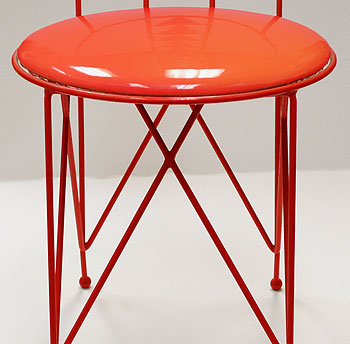
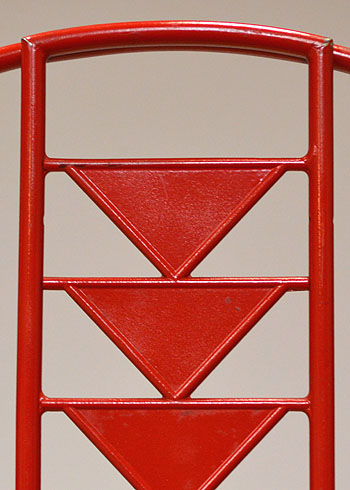
Date: 1986
Title: Cassina: 603 Midway, 2. Frank Lloyd Wright (Published by Cassina, Milan, Italy).
Author: Cassina
Description: Catalog section for Midway Gardens chairs. Cassina 603 Midway 2. The Characteristic of this chair is the lightness of the steel rod structural framework. It is part of a set that includes tables built along similar lines. Chairs in glossy enameled steel rod, white, red, blue, or grey. Removable seat and back padded with polyurethane foam. This model is also available without padded back. Fabric upholstery. Manufactured by Cassina, Milan, Italy. Acquired from the nephew of a diplomat stationed in Rome in the 1980s. While there, she ordered six chairs from Cassina. She saved the catalog and booklets.
Size: 8.5 x 11
Pages: Pp 4
ST#: 1986.141.0423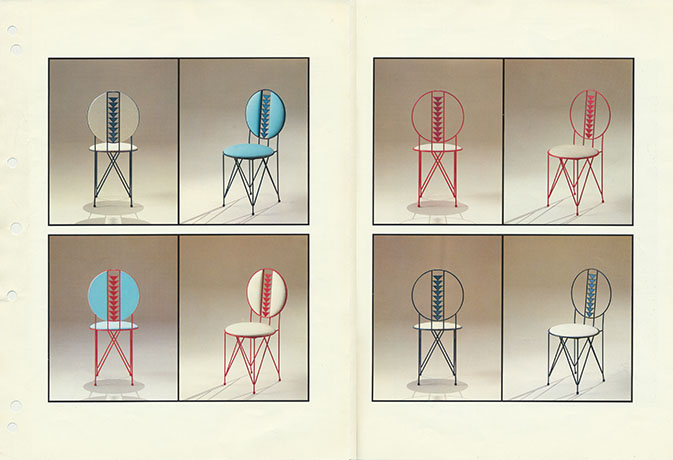
Date: 1986
Title: Midway Gardens Red Side Chair 1986 (1913 - S.180).
Description: One red framed Midway Gardens chair, seat and back cushions are dark gray fabric. Midway Gardens was designed by Frank Lloyd Wright in 1913, built in 1914 and demolished in 1929. This Midway Garden chair was designed by Wright in 1914, but never produced. In 1986, Cassina produced a line of furniture designed by Frank Lloyd Wright. Cassina 603 Midway 2. "The Characteristic of this chair is the lightness of the steel rod structural framework. It is part of a set that includes tables built along similar lines." Cassina Catalog, 1985, p.16-17. "Chairs in glossy enamelled steel rod, white, red, blue, or grey. Removable seat and back padded with polyurethane foam. This model is also available without padded back. Fabric upholstery." P.40-41. Matching tables sold with square or round crystal glass tops. The base is in glossy enamelled steel rod and available in white, red, blue or grey. Manufactured by Cassina, Milan, Italy. Printed on base, "Cassina (C). A Design by Frank Lloyd Wright. Certified by The FLW Foundation." Stamped in frame: "0671." Steel frame is in red enamel, seat in dark gary fabric. Acquired from the nephew of a diplomat stationed in Rome in the 1980s. While there, she ordered six chairs from Cassina. Includes descriptive and numbered booklet. One chair.
Size: 34.65" High x 15.75 Wide x 18.12" Deep. Seat is 18.31" High.
ST#: 1986.132.0423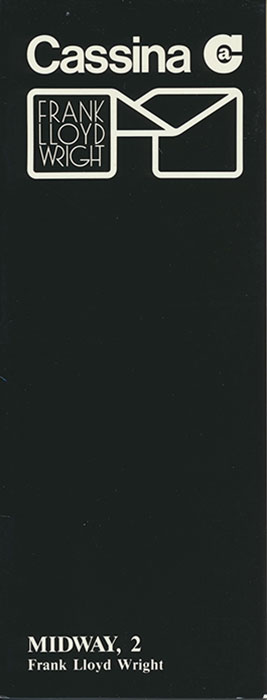
Date: 1986
Title: Cassina: 603 Midway, 2. Frank Lloyd Wright (RF:GC). (Published by Cassina, Milan, Italy).
Author: Cassina
Description: Descriptive booklet for red framed Midway Gardens chairs, seat and back cushions are dark gray fabric. Cassina 603 Midway 2. The Characteristic of this chair is the lightness of the steel rod structural framework. It is part of a set that includes tables built along similar lines. Chairs in glossy enameled steel rod, white, red, blue, or grey. Removable seat and back padded with polyurethane foam. This model is also available without padded back. Fabric upholstery. Manufactured by Cassina, Milan, Italy. Booklet in plastic pouch: No. 671. Acquired from the nephew of a diplomat stationed in Rome in the 1980s. While there, she ordered six chairs from Cassina. She saved the catalog and booklets.
Size: 2.75 x 7
Pages: Pp 8
ST#: 1986.138.0423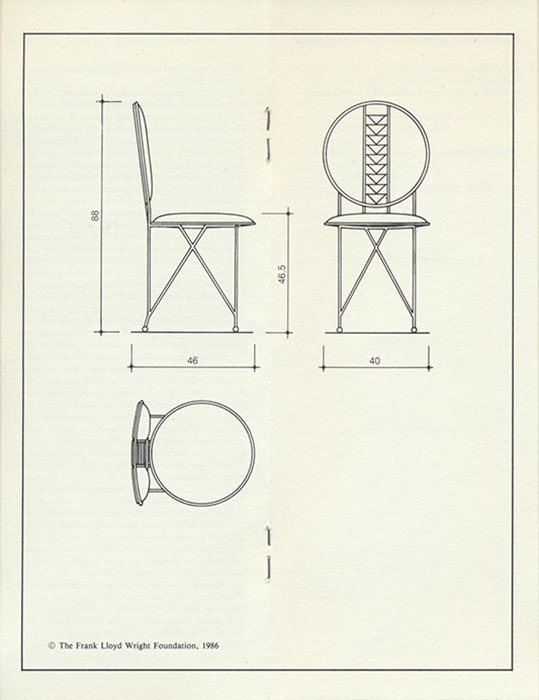
Date: 1986
Title: Midway Gardens White Side Chairs 1986 (1913 - S.180).
Description: Two white framed Midway Gardens chairs, seat and back cushions are dark gray fabric. Midway Gardens was designed by Frank Lloyd Wright in 1913, built in 1914 and demolished in 1929. This Midway Garden chair was designed by Wright in 1914, but never produced. In 1986, Cassina produced a line of furniture designed by Frank Lloyd Wright. Cassina 603 Midway 2. "The Characteristic of this chair is the lightness of the steel rod structural framework. It is part of a set that includes tables built along similar lines." Cassina Catalog, 1985, p.16-17. "Chairs in glossy enamelled steel rod, white, red, blue, or grey. Removable seat and back padded with polyurethane foam. This model is also available without padded back. Fabric upholstery." P.40-41. Matching tables sold with square or round crystal glass tops. The base is in glossy enamelled steel rod and available in white, red, blue or grey. Manufactured by Cassina, Milan, Italy. Printed on base, "Cassina (C). A Design by Frank Lloyd Wright. Certified by The FLW Foundation." Stamped in frame: "0720" and "0729." Steel frame is in white enamel, seat in dark gary fabric. Acquired from the nephew of a diplomat stationed in Rome in the 1980s. While there, she ordered six chairs from Cassina. Includes descriptive and numbered booklets. Two chairs
Size: 34.65" High x 15.75 Wide x 18.12" Deep. Seat is 18.31" High.
ST#: 1986.130.0423, 1986.131.0423
Date: 1986
Title: Cassina: 603 Midway, 2. Frank Lloyd Wright (WF:GC). (Published by Cassina, Milan, Italy).
Author: Cassina
Description: Two descriptive booklets for white framed Midway Gardens chairs, seat and back cushions are dark gray fabric. Cassina 603 Midway 2. The Characteristic of this chair is the lightness of the steel rod structural framework. It is part of a set that includes tables built along similar lines. Chairs in glossy enameled steel rod, white, red, blue, or grey. Removable seat and back padded with polyurethane foam. This model is also available without padded back. Fabric upholstery. Manufactured by Cassina, Milan, Italy. Booklets in plastic pouch: No. 720 and No. 0729. Acquired from the nephew of a diplomat stationed in Rome in the 1980s. While there, she ordered six chairs from Cassina. She saved the catalog and booklets.Two booklets.
Size: 2.75 x 7
Pages: Pp 8
ST#: 1986.139.0423, 1986.140.0423
Date: 1986
Title: Midway Gardens Blue Side Chair 1986 (1913 - S.180).
Description: One blue framed Midway Gardens chair, seat and back cushions are dark gray fabric. Midway Gardens was designed by Frank Lloyd Wright in 1913, built in 1914 and demolished in 1929. This Midway Garden chair was designed by Wright in 1914, but never produced. In 1986, Cassina produced a line of furniture designed by Frank Lloyd Wright. Cassina 603 Midway 2. "The Characteristic of this chair is the lightness of the steel rod structural framework. It is part of a set that includes tables built along similar lines." Cassina Catalog, 1985, p.16-17. "Chairs in glossy enamelled steel rod, white, red, blue, or grey. Removable seat and back padded with polyurethane foam. This model is also available without padded back. Fabric upholstery." P.40-41. Matching tables sold with square or round crystal glass tops. The base is in glossy enamelled steel rod and available in white, red, blue or grey. Manufactured by Cassina, Milan, Italy. Printed on base, "Cassina (C). A Design by Frank Lloyd Wright. Certified by The FLW Foundation." Stamped in frame: "0522." Steel frame is in blue enamel, seat in dark gary fabric. Acquired from the nephew of a diplomat stationed in Rome in the 1980s. While there, she ordered six chairs from Cassina. Includes descriptive and numbered booklet. One chair.
Size: 34.65" High x 15.75 Wide x 18.12" Deep. Seat is 18.31" High.
ST#: 1986.133.0423
Date: 1986
Title: Cassina: 603 Midway, 2. Frank Lloyd Wright (BF:GC). (Published by Cassina, Milan, Italy).
Author: Cassina
Description: Descriptive booklet for blue framed Midway Gardens chairs, seat and back cushions are dark gray fabric. Cassina 603 Midway 2. The Characteristic of this chair is the lightness of the steel rod structural framework. It is part of a set that includes tables built along similar lines. Chairs in glossy enameled steel rod, white, red, blue, or grey. Removable seat and back padded with polyurethane foam. This model is also available without padded back. Fabric upholstery. Manufactured by Cassina, Milan, Italy. Booklet in plastic pouch: No. 522. Acquired from the nephew of a diplomat stationed in Rome in the 1980s. While there, she ordered six chairs from Cassina. She saved the catalog and booklets.
Size: 2.75 x 7
Pages: Pp 8
ST#: 1986.137.0423
Date: 1986
Title: Midway Gardens Grey Side Chairs 1986 (1913 - S.180).
Description: Two grey framed Midway Gardens chairs, seat and back cushions are dark gray fabric. Midway Gardens was designed by Frank Lloyd Wright in 1913, built in 1914 and demolished in 1929. This Midway Garden chair was designed by Wright in 1914, but never produced. In 1986, Cassina produced a line of furniture designed by Frank Lloyd Wright. Cassina 603 Midway 2. "The Characteristic of this chair is the lightness of the steel rod structural framework. It is part of a set that includes tables built along similar lines." Cassina Catalog, 1985, p.16-17. "Chairs in glossy enamelled steel rod, white, red, blue, or grey. Removable seat and back padded with polyurethane foam. This model is also available without padded back. Fabric upholstery." P.40-41. Matching tables sold with square or round crystal glass tops. The base is in glossy enamelled steel rod and available in white, red, blue or grey. Manufactured by Cassina, Milan, Italy. Printed on base, "Cassina (C). A Design by Frank Lloyd Wright. Certified by The FLW Foundation." Stamped in frame: "0890" and "0661." Steel frame is in grey enamel, seat in dark gary fabric. Acquired from the nephew of a diplomat stationed in Rome in the 1980s. While there, she ordered six chairs from Cassina. Includes descriptive and numbered booklets. Two chairs.
Size: 34.65" High x 15.75 Wide x 18.12" Deep. Seat is 18.31" High.
ST#: 1986.134.0423, 1986.135.0423
Date: 1986
Title: Cassina: 603 Midway, 2. Frank Lloyd Wright (GF:GC) (Published by Cassina, Milan, Italy).
Author: Cassina
Description: Descriptive booklet for grey framed Midway Gardens chairs, seat and back cushions are dark gray fabric. Cassina 603 Midway 2. The Characteristic of this chair is the lightness of the steel rod structural framework. It is part of a set that includes tables built along similar lines. Chairs in glossy enameled steel rod, white, red, blue, or grey. Removable seat and back padded with polyurethane foam. This model is also available without padded back. Fabric upholstery. Manufactured by Cassina, Milan, Italy. Booklet in plastic pouch: No. 0890.(Booklet for No. 0661 is missing.) Acquired from the nephew of a diplomat stationed in Rome in the 1980s. While there, she ordered six chairs from Cassina. She saved the catalog and booklets.
Size: 2.75 x 7
Pages: Pp 8
ST#: 1986.136.0423
Date: 1987 Title: Biltmore Sprite.
Description: "The Biltmore Sprites, donated by Taliesin Associated Architects to the Arizona Biltmore were recently unveiled. These architectural statues of concrete were originally designed in 1914 by Frank Lloyd Wright to decorate the now destroyed Midway Gardens of Chicago." Photographed October 21, 1987 at the Arizona Biltmore Dedication Ceremony.
Size: Original 5 x 7 B&W photograph.
ST#: 1987.44.0507
Date: 1987 Title: Dedication Ceremony.
Description: "John Rattenbury of Taliesin Associated Architects explains the history of the Sprites of Midway Gardens at the unveiling at the Arizona Biltmore. The Sprites were recently restored and donated to the hotel by Taliesin. Renamed the "Biltmore Sprites," these architectural statues were originally designed in 1914 by Frank Lloyd Wright to decorate the now destroyed Midway Gardens of Chicago." Photographed October 21, 1987 at the Arizona Biltmore Dedication Ceremony.
Size: Original 7 x 5 B&W photograph.
ST#: 1987.45.0507
Date: 1987 Title: PR: The Biltmore Sprite Fact Sheet
Author: Arizona Biltmore
Description: Fact sheet concerning Sprite, Dimensions, Material, Donations, Restoration, Design and Original Sculpture.
Size: 8.5 x 11
Pages: Pg 1
ST#: 1987.47.0507
Date: 1987 Title: PR: Arizona Biltmore PR - 10/87 (Published by DBG&H, Phoenix)
Author: Spitza, Anne M.
Description: "The History of the Sprites of Midway Gardens." Includes information on the history and destruction of the Midway Gardens and the Sprites. "It seemed the Sprites were lost forever. Then sometime after World War II, word reached Taliesin... that a few of the Sprites had been saved and were lying in pieces in a farmer's field in Lake Delton, Wisconsin."
Size: 8.5 x 11
Pages: Pp 4
ST#: 1987.48.0507
Date: 1987 Title: PR: Arizona Biltmore PR - 10/87 (Published by DBG&H, Phoenix)
Author: Spitza, Anne M.
Description: "Creation of the Sprites Old & New." Includes information on the creation of the original Sprites and the restoration. "The Biltmore Sprites... are authentic, accurate reproductions of the damaged originals."
Size: 8.5 x 11
Pages: Pp 3
ST#: 1987.49.0507
Date: 1987 Title: PR: Arizona Biltmore PR - 10/87 (Published by DBG&H, Phoenix)
Author: Spitza, Anne M.
Description: "Press Conference. ...the Sprites of Midway Gardens have been resurrected from their demise. Now called the Biltmore sprites, they will be donated to the Arizona Biltmore by Taliesin on Wednesday, October 21 at 2:00 p.m., in front of the hotel." Two Copies.
Size: 8.5 x 11
Pages: Pp 2
ST#: 1987.50.0507, 1987.51.0507
Date: 1990 Title: Sprite Bud Vase.
Description: Midway Garden Sprite engraved on each side with a different angle. Silver Plated Pewter. The Museum Company #400-54920.
Size: 1.5 x 7.4
ST#: 1990.51.0706
Date: Circa 1990
Title: Prairie Avenue Bookstore, Chicago, Illinois Circa 1990.
Description: View of two recast heads from Interior Fountain at Midway Gardens, Chicago, Illinois. Midway Gardens was designed by Frank Lloyd Wright in 1913, the sculptures were executed by Alfonso Iannelli. Midway Gardens was built in 1914 and demolished in 1929. In 1939, ten years after its destruction, Edgar Tafel, one of Frank Lloyd Wright's apprentices, was supervising the construction of the Lloyd Lewis Residence in Libertyville, Illinois (1939 - S.265). During that time frame, he made the trip to Chicago to visit the site of the demolished Midway Gardens. The elements had exposed fragments, and one was the head from the fountain in the enclosed Winter Garden. Tafel took it back to the Lewis site and designed and fabricated the base in the shape of interlocked cubes, reminiscent of the designs in the Midway Garden Sprites. The Lewises loved what he had done and convinced Tafel to leave it with them, which he later greatly regretted. Recast from the original by Bill Hasbrouck.
Bill Hasbrouck of the Prairie Avenue Bookstore in Chicago, a landmark of its own, was visiting the Lewises in the mid 1970s and was so excited about the piece he convinced Katherine Lewis to allow him to borrow the original fragment to cast and create replicas. He created the mold and castings, and replicated the wood base Tafel had created in 1939. Bill and Marilyn Hasbrouck sold the replicas at their Prairie Avenue Bookshop in Chicago. The original was recast again in 1996 by John Nolan of Nolan Plastering and sold at the Prairie Avenue Bookshop. Photograph courtesy of HPZS. See additional details...
Size: 10 x 6.5 B&W photograph.
ST#: 1990.180.0122Date: 1991 Title: Trademarks of Base-Metal Tableware. Late 18th century to circa 1900 (including marks on Britannia metal, iron, steel, cooper alloys and silver-plated goods) (Copyright Ministry of Supply and Services Canada. Published under the authority of the Ministry of the Environment, Ottawa, 1991)
Author: Woodhead, Eileen
Description: Invaluable for dating the marking on the bottom of the Midway Gardens dish. (For more information see our Wright study on the Midway gardens dish.)
Size: 8.5 x 11
Pages: Pp 331
ST#: 1991.58.1010
Date: 1991 Title: Original Midway Gardens Sprite, September 1991.
Description: Clipping pasted to verso: "Frank Lloyd Wright designed many an architectural masterpieces. One of his greatest blossomed, died of economic strangulation and was erased from the face of the earth in just 15 years on Chicago's South Side. The brief but glorious life of the Midway Gardens - a landmark of architecture, jazz and haute culture - is being memorialized at Kelmscott Gallery, 4611 N. Lincoln, in the current exhibit: "˜Frank Lloyd Wright and Alfonso Iannelli - The story of the Midway Gardens". The show runs through Oct. 26. Gallery hours are 11 a.m. to 6 p.m. Tuesday through Saturday. The first World War, the postwar recession and Prohibition quickly wrote finis to the indoor-outdoor pleasure ground that provided good music, good food and (originally) drink in Wright's modern arts version of a German beer garden. The combination open-air cafe, band shell and large winter garden, decorated with tradition-shattering Cubist sculptures, opened in 1914 on South Cottage Grove and was torn down in 1929. Wright boasted in later years that it was so solidly built that the wrecking company went broke tearing it apart. Precious little remains of the place where Bix Beiderbecke made jazz hot, Benny Goodman cooled it on the clarinet, Russian ballerina Anna Pavlove danced and the house orchestra was led by Max Bendix, associate of Chicago Symphony Orchestra founder Theodore Thomas." Caption pasted to verso: "Star of the show is one of Iannelli's original concrete sprites from the Midway Gardens. It was recently found near Wisconsin Dells." Stamped on verso: "Sept 22 1991".
Size: Original 8 x 10 B&W photograph.
ST#: 1991.71.0513
Date: 1994
Title: Midway Gardens Table Lamps 1994 (1913 - S.180).
Description: The Frank Lloyd Wright Home and Studio 1994/1995 Catalog description: "For Midway Garden Center, Chicago, a fashionable place for dining and dancing out-of-doors, Wright created and almost magical setting of architecture, furniture, sculpture, murals, tableware, and lighting. Originally designed in 1913, Wright's dramatic table lamp has been carefully reproduced... The lamp is of matte black painted aluminum; the shade is opalescent glass and black patina brass." p.1-2. The base is two tiered. The stem is 5/8" x 5/8" x 29 1/2" tall. The arm is 1/2 x 1/2 x 21" long. The top of the stem has five squares included in the length, the arm has three squares. The hexagonal lamp shade is cantilevered past the base. The black metal frame is inset with white glass panels with small random red squares, equivalent to confetti in appearance. Manufactured by Yamagiwa Corporation, S2302. Original list price $1180 each.
Size: 30 3/8" H x 13 3/4" W x 29 1/2" D. Two lamps.
ST#: 1994.113.0719 (A&B)
Left: Presentation drawing, Midway Gardens table setting, Frank Lloyd Wright. Courtesy of the Frank Lloyd Wright Foundation.
Right: Detail of the Table Lamp.Date: 1996
Title: Midway Gardens Sprite Letter Opener 1996 (1914 - S.180).
Description: "Sprite sculptures once adorned the Midway Gardens entertainment complex in Chicago (1913; demolished 1929). Here interpreted as a pewter letter opener, the sprite will delight it's user on a daily basis. Solid pewter handle; steel blade." The Frank Lloyd Wright Home And Studio Catalog, 1996/1997, p.8. Licensed by the Frank Lloyd Wright Foundation. Original list price $32.00.
Size: 8.5" long.
ST#: 1996.88.0719Date: 1998 Title: Frank Lloyd Wright and Midway Gardens (Hard Cover - DJ)
Author: Kruty, Paul
Description: Original HC List Price $60.00. (First Edition)
Size:
Pages: Pp 362
ST#: 1998.27.0404
Date: 1998 Title: Midway Gardens "Sprite" Garden Sculpture
Description: A reproduction of the original sculpture designed by Frank Lloyd Wright and executed by Alfonso Iannelli. (Produced by Nichols Brothers Stoneworks, Woodinville, Washington)
Size: 42" Tall with Base
ST#: 1998.00.1098
Date: 1997
Title: Midway Gardens "Contemplative" Sprite, Cast Stone, 1997.
Description:
Cast Stone Midway Gardens "Contemplative" Sprite. Head is bowed, downcast eyes and hands folded across the chest. Designed by Frank Lloyd Wright in 1913, executed by Alfonso Iannelli. Midway Gardens officially opened on June 27th, 1914. Manufactured by Alva Museum Reproductions in 1997. Available through the Frank Lloyd Wright Home and Studio Museum Catalog, 1997/1998, back cover. Original price $110. Caption: "Scaled for use, these careful adaptations capture the different attitudes of two of Wright's strongly composed, imaginative designs. Made of cast stone with a color and finish that resemble concrete, each is 15" tall." Note: In Frank Lloyd Wright's House Beautiful, Accessories to Purchase. "Wright At Home. Sprite Sculptures. Cast stone, 15" high. Omnia/Alva. Reproductions of two of Alfonso Iannelli's sculptures from Midway Gardens (1913) in Chicago, intended for indoor use, capture the site's geometric forms." Maddex, 2000, p.161. Accompanied photo includes this plus an addition sprite, available from Omnia/Alva.
Size: 15.125" High x 3.75" Wide, 2.75" Deep.
ST#: 1997.87.0720Date: 1998
Title: Midway Gardens, Chicago, Illinois, Beer Stein, 1914/1998 (1913 - S.180).
Description: Photograph of a beer stein from the Midway Gardens, in the collection of the Minneapolis Institute of Art, photographed circa 1998. Midway Gardens covered a city block and included the exterior summer garden with performance stage and an interior Winter Garden for year round entertainment. Designed by Franjk Lloyd Wright in 1913. He designed the complete structure: furnishings, furniture, sculptures, murals, windows, dinnerware, monogram, a complete work of art.
The Midway Gardens beer steins were produced in two sizes. This taller 7" beer stein and a shorter 5.75" beer stein. The shorter was sold at auction in St. Paul, Minnesota in 2024. Courtesy of the Minneapolis Institute of Art. See Additional Details...
Size: 8 x 10 Color Photograph.
ST#: 1998.123.1025Date: 1998
Title: Midway Gardens "Queen of the Gardens" Sprite, Artist Proof, 1998.
Description: Plaster casting from the original created by Richmond, Virginia Sculpture Terence Karsellis. The original was created for, and sent to Alva Museum Reproductions in 1998. A mold was created by Alva from the original, several artist proofs created, including this one, sent to the Karsellis for approval. He recalls that two or three remained at Alva. The original was retained by Alva, and Karselis indicated that he is unaware of any additional reproductions unless they are held by the organization that obtained the assets of Alva Museum Reproductions. Designed by Frank Lloyd Wright in 1913, executed by Alfonso Iannelli. Midway Gardens officially opened on June 27th, 1914. The original sculpture included wings. "Six castings of the large, smiling, winged figure lifting a cube overhead (the Queen of the Gardens) (fig. 116) decorated the building: two on Cottage Grove (fig. 108 and plate j), two on matching piers in the garden (plate EE), and two at the rear of the band shell (plate DD)." Frank Lloyd Wright and Midway Gardens, Kruty, 1998, p.134. In 1914, at the 27th Annual Exhibition of the Chicago Architectural Club, seven Midway Garden Maquettes were exhibited at The Work of Frank Lloyd Wright: Sprite; Sprite with Baton; Cube Sprite; Octagonal Sprite; Sphere Sprite, Triangle Sprite, and Queen of the Gardens. Note: In Frank Lloyd Wright's House Beautiful, Accessories to Purchase. "Wright At Home. Sprite Sculptures. Cast stone, 15" high. Omnia/Alva. Reproductions of two of Alfonso Iannelli's sculptures from Midway Gardens (1913) in Chicago, intended for indoor use, capture the site's geometric forms." Maddex, 2000, p.161. Accompanied photo includes this plus an addition sprite, available from Omnia/Alva.
Size: Plaster casting from the original, 15.125" High x 3.625" Wide, 2" Deep.
ST#: 1998.106.0620Date: 1998
Title: Midway Gardens "Queen of the Gardens" Sprite, Cast Stone, 1998.
Description: Cast Stone Midway Gardens "Queen of the Gardens" Sprite. Standing on a pedestal, her hands are raised over head, holding a cube. Waist high decorative columns are on either side. The original sculpture included wings. Designed by Frank Lloyd Wright in 1913, executed by Alfonso Iannelli. Midway Gardens officially opened on June 27th, 1914. "Six castings of the large, smiling, winged figure lifting a cube overhead (the Queen of the Gardens) (fig. 116) decorated the building: two on Cottage Grove (fig. 108 and plate j), two on matching piers in the garden (plate EE), and two at the rear of the band shell (plate DD)." Frank Lloyd Wright and Midway Gardens, Kruty, 1998, p.134. In 1914, at the 27th Annual Exhibition of the Chicago Architectural Club, seven Midway Garden Maquettes were exhibited at The Work of Frank Lloyd Wright: Sprite; Sprite with Baton; Cube Sprite; Octagonal Sprite; Sphere Sprite, Triangle Sprite, and Queen of the Gardens. Note: In Frank Lloyd Wright's House Beautiful, Accessories to Purchase. "Wright At Home. Sprite Sculptures. Cast stone, 15" high. Omnia/Alva. Reproductions of two of Alfonso Iannelli's sculptures from Midway Gardens (1913) in Chicago, intended for indoor use, capture the site's geometric forms." Maddex, 2000, p.161. Accompanied photo includes this plus an addition sprite, available from Omnia/Alva. Available through the Frank Lloyd Wright Home and Studio Museum Catalog, 1998/1999, p.3. Original price $110. Caption: "Scaled for use, these careful adaptations capture the different attitudes of two of Wright's strongly composed, imaginative designs. Made of cast stone with a color and finish that resemble concrete, each is 15" tall." Manufactured by Alva Museum Reproductions in 1998.
Size: 15.125" High x 3.375" Wide, 2.75" Deep.
ST#: 1998.107.1120Date: 2002
Title: Midway Garden full-size "Contemplative Sprite" 2002 (1913 - S.180).
Description: Frank Lloyd Wright included many sculptures in the Midway Gardens Complex. The two most recognized Sprites, Contemplative and Smiling, were cast in concrete. Contemplative Sprite: Lowered head, downcast eyes and hands folded across the chest. Smiling Sprite: Turned head, hands folded across the chest. They appeared on either side of the two entrances on Cottage Grove Avenue (4), as well as the two entrances on the North and South sides (4). Eight towered on the wall above each sunken garden alternating between Contemplative and Smiling (16). A Sprite appeared on either side of the two entrances to the roof garden (4). Sprites were also placed atop the four narrow piers that flanked the roof garden, two on the East and two on the West sides (4). Other forms of the sprites appears throughout the complex. The sculptures were executed by Alfonso Iannelli. Produced by Nichols Brothers Stoneworks, Woodinville, Washington. Hand-cast sandstone. Metal label on back near base: "A Frank Lloyd Wright Collection Product. Frank Lloyd Wright. Authorize by the Frank Lloyd Wright Foundation." Stamped in label: "516." Original list price $1675.
Size: 66.5" high x 10.5" wide x 16" deep. Base: 14" wide x 11.5" deep. 300 pounds.
ST#: 2002.145.0819Date: 2004 Title: Midway Garden "Sprite" with Baton.
Description: Frank Lloyd Wright Licensed vase. A reproduction of the original sculpture designed by Frank Lloyd Wright and executed by Alfonso Iannelli. (Produced by Nichols Brothers Stoneworks, Woodinville, Washington)
Size: 42" tall with base
ST#: 2004.13.0704
Date: 2006
Title: Midway Gardens Font Set (Published by P22 Type Foundry. Designed for P22 by Paul Hunt.)
Author: P22 Type Foundry
Description: In 1913, Edward C. Waller, Jr. commissioned Frank Lloyd Wright to expand an Amusement Park complex and turn it into an upscale palatial beer garden. The Midway Gardens was born. FLLW® Midway„ is based on the lettering found on the Midway Garden's working drawings. The lettering itself is in Mr. Wright's distinctive hand. This type of architectural lettering is a bit more casual than standard lettering found on most blueprints. It evokes the personality of Frank Lloyd Wright in a way that complements the other fonts in the P22 FLLW font series. The set contains Midway One and Midway Two, which can be used interchangeably to give a more naturalistic feeling of hand lettering. Also included is Midway Ornaments, which features over 100 architectural and decorative elements that can be combined in many ways for surprising and effective decorative motifs and borders.
Size: Case: 5.25 x 7.5
ST#: 2006.54.0516Date: 2009
Title: Prairie Avenue Bookstore, Chicago, Illinois 2009. Bill Hasbrouck, shown in 2009 at Prairie Avenue Bookshop, 418 S. Wabash Ave, Chicago.
Description: Setting in the center of the table is a recast head from Interior Fountain at Midway Gardens, Chicago, Illinois. Midway Gardens was designed by Frank Lloyd Wright in 1913, the sculptures were executed by Alfonso Iannelli. Midway Gardens was built in 1914 and demolished in 1929. In 1939, ten years after its destruction, Edgar Tafel, one of Frank Lloyd Wright's apprentices, was supervising the construction of the Lloyd Lewis Residence in Libertyville, Illinois (1939 - S.265). During that time frame, he made the trip to Chicago to visit the site of the demolished Midway Gardens. The elements had exposed fragments, and one was the head from the fountain in the enclosed Winter Garden. Tafel took it back to the Lewis site and designed and fabricated the base in the shape of interlocked cubes, reminiscent of the designs in the Midway Garden Sprites. The Lewises loved what he had done and convinced Tafel to leave it with them, which he later greatly regretted. Recast from the original by Bill Hasbrouck.
Bill Hasbrouck of the Prairie Avenue Bookstore in Chicago, a landmark of its own, was visiting the Lewises in the mid 1970s and was so excited about the piece he convinced Katherine Lewis to allow him to borrow the original fragment to cast and create replicas. He created the mold and castings, and replicated the wood base Tafel had created in 1939. Bill and Marilyn Hasbrouck sold the replicas at their Prairie Avenue Bookshop in Chicago. The original was recast again in 1996 by John Nolan of Nolan Plastering and sold at the Prairie Avenue Bookshop. Photo courtesy of Heather Charles / Chicago Tribune. See Additional Details...
Size: 10 x 5.75 Color photograph.
ST#: 2009.58.0122
Date: 2010
Title: Midway Gardens, Chicago, Illinois, Chess Set 2010 (1913 - S.180).
Description: Midway Gardens Chess Set, authorized by the Frank Lloyd Wright Foundation includes 32 pieces carefully crafted in Cold Cast Resin.
Text in acompaning brochure: “Midway Gardens Chess Set Chicago, Illinois 1913-1929. Frank Lloyd Wright (1867-1959) is recognized world-wide as one of the greatest architects of the twentieth century. His work heralded a new thinking in architecture and his creative ability extended far beyond architecture to graphic design, furniture, art glass, sculpture and other decorative objects.
“These handsome oversize chess pieces are adaptations of the various sculptures and architectural details designed by Frank Lloyd Wright for the Midway Gardens, a city block area dedicated to entertainment. The original sculptures were larger than life size and overlooked the many open air gardens, restaurants, music, and dance areas in the complex. Demolished in 1929 due to the stock market crash and the ban on liquor, the unique sculptures would have been lost if it hadn't been for the foresight of the demolition contractor who saved them for posterity.
“The development of these chess pieces required numerous steps to enable the pieces to replicate the intricate characteristics of the original sculptures. These included study of the original drawings and historical photographs maintained in the Foundation's Archives. CAD drawings were then made from the originals and given to sculptors to create wax models. Once approved, these were used to make the final molds for casting the individual pieces. After Foundation approval, the final production of the graduated set of models, with a 5" King and Queen, had selected finishes hand applied to provide a textured "patina".
Original cost in 2024, ordered from Frank Lloyd Wright Foundation: Pieces and board: $386.60. See Additional Details...
Size: Pieces: 3" - 5" tall. Box housing pieces: 18.5" x 10.5 x 4.25. Chess board: 19" x 19" x .75". Box housing chess board: 21.5 x 21.5 x 2". Brochure, p.4, 5 x 8.
ST#: 2010.52.0324
Left: Brochure included with set.
Below: Box housing chess pieces.Date: 2015
Title: Midway Gardens Sprite Holding Two Cubes Sculpture 2015 (1913 - S.180).
Description: "Midway Gardens. "Sprite Holding Two Cubes" Sculpture. Midway Gardens (1913) was an indoor-outdoor entertainment complex on Chicago's south side and an extraordinary achievement for Frank Lloyd Wright. He personally designed all elements including murals, tableware and furniture. Wright envisioned several freestanding sculptures for the gardens. Wright designed and had Alfonso Iannelli execute geometric sculptures called "Sprites." This "Sprite Holding Two Cubes" is representative of one of three that adorned the Gardens which were salvaged before the premature and unfortunate demise of this lost treasure in 1929." Foundation description. The original "Totem Pole" as Paul Kruty described it, extended two levels higher, Frank Lloyd Wright and Midway Gardens, Kruty, 1998, p.136. If the additional two levels were added to this model, it would have been approximately 22 1/2 inches tall. Manufactured of hand-cast resin. Original list price $55.00.
Size: 3 7/8" Deep x 3.25" Wide x 14" Tall.
ST#: 2015.35.1019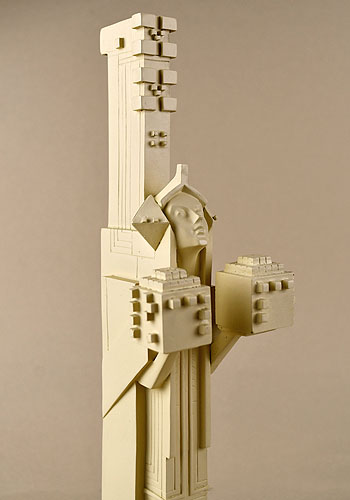
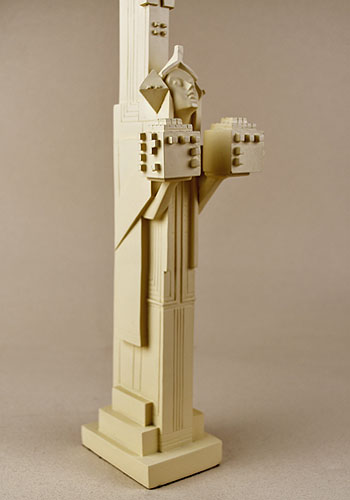
Midway Gardens. "˜Sprite Holding Two Cubes" Sculpture. Midway Gardens (1913) was an indoor-outdoor entertainment complex on Chicago's south side and an extraordinary achievement for Frank Lloyd Wright. He personally designed all elements including murals, tableware and furniture. Wright envisioned several freestanding sculptures for the gardens. Wright designed and had Alfonso Iannelli execute geometric sculptures called "Sprites." This "Sprite Holding Two Cubes" is representative of one of three that adorned the Gardens which were salvaged before the premature and unfortunate demise of this lost treasure in 1929.Date: 2015
Title: Midway Gardens Sprite With Crossed Arms Sculpture 2015 (1913 - S.180).
Description: "Midway Gardens. "˜Sprite With Crossed Arms" Sculpture. Midway Gardens (1913) was an indoor-outdoor entertainment complex on Chicago's south side and an extraordinary achievement for Frank Lloyd Wright. He personally designed all elements including murals, tableware and furniture. Wright envisioned several freestanding sculptures for the gardens. Wright designed and had Alfonso Iannelli execute geometric sculptures called "˜Sprites." This "Sprite With Crossed Arms " is representative of one of three that adorned the Gardens which were salvaged before the premature and unfortunate demise of this lost treasure in 1929." Foundation description. In 1914, at the 27th Annual Exhibition of the Chicago Architectural Club, seven Midway Garden Maquettes were exhibited at The Work of Frank Lloyd Wright: Sprite; Sprite with Baton; Cube Sprite; Octagonal Sprite; Sphere Sprite, Triangle Sprite, and Queen of the Gardens. Manufactured of hand-cast resin. Original list price $55.00.
Size: 2 5/8" Deep x 2 5/8" Wide x 13.5" Tall.
ST#: 2015.36.0520
Midway Gardens. "˜Sprite With Crossed Arms" Sculpture. Midway Gardens (1913) was an indoor-outdoor entertainment complex on Chicago's south side and an extraordinary achievement for Frank Lloyd Wright. He personally designed all elements including murals, tableware and furniture. Wright envisioned several freestanding sculptures for the gardens. Wright designed and had Alfonso Iannelli execute geometric sculptures called "˜Sprites." This "Sprite With Crossed Arms " is representative of one of three that adorned the Gardens which were salvaged before the premature and unfortunate demise of this lost treasure in 1929.Date: 2016
Title: Midway Gardens Male Sprite Holding Octagons Sculpture 2016 (1913 - S.180).
Description: "Midway Gardens. "˜Stability." Octagon Winter Garden Male Sprite. Midway Gardens was an indoor-outdoor entertainment complex located on Chicago's south side. Constructed in 1914, the complex was ornamented with concrete panels, hand-painted wall murals, lighting, and tableware all designed by Frank Lloyd Wright. Working in collaboration with sculptor Alfonso Iannelli, a group of various concrete figures, male and female, were sculpted and stood atop the building's street facades. They were gracefully positioned in the interior spaces and gardens contained within the structure. These abstractions of the human form entertain the eye and seem at times to reflect the Art Nouveau and Cubism movements of the early twentieth century. "A man's conscience is really the mainspring of what he, with some reason, might call his soul. So listen attentively to conscience, always." 1959 - Frank Lloyd Wright." Foundation description. In 1914, at the 27th Annual Exhibition of the Chicago Architectural Club, seven Midway Garden Maquettes were exhibited at The Work of Frank Lloyd Wright: Sprite; Sprite with Baton; Cube Sprite; Octagonal Sprite; Sphere Sprite, Triangle Sprite, and Queen of the Gardens.Manufactured of hand-cast resin. Original list price $44.00.
Size: 4 1/4" Deep x 5 1/8" Wide x 14" Tall.
ST#: 2016.35.1019
Midway Gardens. "Stability." Octagon Winter Garden Male Sprite. Midway Gardens was an indoor-outdoor entertainment complex located on Chicago's south side. Constructed in 1914, the complex was ornamented with concrete panels, hand-painted wall murals, lighting, and tableware all designed by Frank Lloyd Wright. Working in collaboration with sculptor Alfonso Iannelli, a group of various concrete figures, male and female, were sculpted and stood atop the building's street facades. They were gracefully positioned in the interior spaces and gardens contained within the structure. These abstractions of the human form entertain the eye and seem at times to reflect the Art Nouveau and Cubism movements of the early twentieth century. "A man's conscience is really the mainspring of what he, with some reason, might call his soul. So listen attentively to conscience, always." 1959 - Frank Lloyd Wright.Date: 2016
Title: Midway Gardens Sprite, Poetry Sphere Winter Garden Nymph 2016 (1913 - S.180).
Description: Frank Lloyd Wright (1867-1959) is recognized world-wide as one of the greatest architects of the twentieth century. His work heralded a new thinking in architecture, using innovation in design and engineering made possible by newly designed technology and materials. His creative ability extended far beyond the border of architecture to graphic design, furniture, art glass, textiles, and decorative elements for the home. Midway Gardens was an indoor-outdoor entertainment complex located on Chicago's south side. Constructed in 1914, the complex was ornamented with concrete panels, hand-painted wall murals, lighting, and tableware all designed by Frank Lloyd Wright. Working in collaboration with sculptor Alfonso Iannelli, a group of various concrete figures, male and female, were sculpted and stood atop the building's street facades. They were gracefully positioned in the interior spaces and gardens contained within the structure. These abstractions of the human form entertain the eye and seem at times to reflect the Art Nouveau and Cubism movements of the early twentieth century. "We hunger for POETRY naturally as we do for sunlight." 1928 - Frank Lloyd Wright. (Frank Lloyd Wright Foundation description.) Original sprite was executed by Alfonso Iannelli in 1914. Handmade of cold cast polyresin mixed with bronze powder, individually hand painted and polished. The Sprite was located on the east end of the south mezzanine in the winter garden. Licensed by the Frank Lloyd Wright Foundation. Original list price $99.95.
Size: 15 x 4.3 x 4.3
ST#: 2016.22.0517
Midway Gardens "Poetry" Sphere Winter Garden Nymph. These abstractions of the human form entertain the eye and seem at times to reflect the Art Nouveau and Cubism movement of the early twentieth century. "We hunger for POETRY naturally as we do for sunlight..." 1928 - Frank Lloyd Wright.Date: 2021
Title: 1) 1975/1914 Recast Head from Interior Fountain at Midway Gardens, Chicago, Illinois 2021 (1913 - S.180).
Description: View of the 1975/1914 recast head from the Midway Gardens fountain. Face is turned slightly to the right. Designed by Frank Lloyd Wright in 1913, the sculptures were executed by Alfonso Iannelli. Midway Gardens was built in 1914 and demolished in 1929. In 1939, ten years after its destruction, Edgar Tafel, one of Frank Lloyd Wright's apprentices, was supervising the construction of the Lloyd Lewis Residence in Libertyville, Illinois (1939 - S.265). During that time frame, he made the trip to Chicago to visit the site of the demolished Midway Gardens. The elements had exposed fragments, and one was the head from the fountain in the enclosed Winter Garden. Tafel took it back to the Lewis site and designed and fabricated the base in the shape of interlocked cubes, reminiscent of the designs in the Midway Garden Sprites. The Lewises loved what he had done and convinced Tafel to leave it with them, which he later greatly regretted. Recast from the original by Bill Hasbrouck. Photographed by Toomey and Co., Oak Park, Illinois. See Additional Details...
Size: 8 x 10 Color photograph.
ST#: 2021.16.1221Date: 2021
Title: 2) 1975/1914 Recast Head from Interior Fountain at Midway Gardens, Chicago, Illinois 2021 (1913 - S.180).
Description: View of the 1975/1914 recast head from the Midway Gardens fountain. Face is turned to the right. Designed by Frank Lloyd Wright in 1913, the sculptures were executed by Alfonso Iannelli. Midway Gardens was built in 1914 and demolished in 1929. In 1939, ten years after its destruction, Edgar Tafel, one of Frank Lloyd Wright's apprentices, was supervising the construction of the Lloyd Lewis Residence in Libertyville, Illinois (1939 - S.265). During that time frame, he made the trip to Chicago to visit the site of the demolished Midway Gardens. The elements had exposed fragments, and one was the head from the fountain in the enclosed Winter Garden. Tafel took it back to the Lewis site and designed and fabricated the base in the shape of interlocked cubes, reminiscent of the designs in the Midway Garden Sprites. The Lewises loved what he had done and convinced Tafel to leave it with them, which he later greatly regretted. Recast from the original by Bill Hasbrouck. Photographed by Toomey and Co., Oak Park, Illinois. See Additional Details...
Size: 8 x 10 Color photograph.
ST#: 2021.17.1221Date: 2021
Title: 3) 1975/1914 Recast Head from Interior Fountain at Midway Gardens, Chicago, Illinois 2021 (1913 - S.180).
Description: View of the 1975/1914 recast head from the Midway Gardens fountain. Face is turned away from the camera. Designed by Frank Lloyd Wright in 1913, the sculptures were executed by Alfonso Iannelli. Midway Gardens was built in 1914 and demolished in 1929. In 1939, ten years after its destruction, Edgar Tafel, one of Frank Lloyd Wright's apprentices, was supervising the construction of the Lloyd Lewis Residence in Libertyville, Illinois (1939 - S.265). During that time frame, he made the trip to Chicago to visit the site of the demolished Midway Gardens. The elements had exposed fragments, and one was the head from the fountain in the enclosed Winter Garden. Tafel took it back to the Lewis site and designed and fabricated the base in the shape of interlocked cubes, reminiscent of the designs in the Midway Garden Sprites. The Lewises loved what he had done and convinced Tafel to leave it with them, which he later greatly regretted. Recast from the original by Bill Hasbrouck. Photographed by Toomey and Co., Oak Park, Illinois. See Additional Details...
Size: 8 x 10 Color photograph.
ST#: 2021.18.1221Date: 2021
Title: 4) 1975/1914 Recast Head from Interior Fountain at Midway Gardens, Chicago, Illinois 2021 (1913 - S.180).
Description: View of the 1975/1914 recast head from the Midway Gardens fountain. Face is turned to the left. Designed by Frank Lloyd Wright in 1913, the sculptures were executed by Alfonso Iannelli. Midway Gardens was built in 1914 and demolished in 1929. In 1939, ten years after its destruction, Edgar Tafel, one of Frank Lloyd Wright's apprentices, was supervising the construction of the Lloyd Lewis Residence in Libertyville, Illinois (1939 - S.265). During that time frame, he made the trip to Chicago to visit the site of the demolished Midway Gardens. The elements had exposed fragments, and one was the head from the fountain in the enclosed Winter Garden. Tafel took it back to the Lewis site and designed and fabricated the base in the shape of interlocked cubes, reminiscent of the designs in the Midway Garden Sprites. The Lewises loved what he had done and convinced Tafel to leave it with them, which he later greatly regretted. Recast from the original by Bill Hasbrouck. Photographed by Toomey and Co., Oak Park, Illinois. See Additional Details...
Size: 8 x 10 Color photograph.
ST#: 2021.19.1221Date: 2021
Title: 5) 1975/1914 Recast Head from Interior Fountain at Midway Gardens, Chicago, Illinois 2021 (1913 - S.180).
Description: View of the 1975/1914 recast head from the Midway Gardens fountain. Face is turned to face the camera. Designed by Frank Lloyd Wright in 1913, the sculptures were executed by Alfonso Iannelli. Midway Gardens was built in 1914 and demolished in 1929. In 1939, ten years after its destruction, Edgar Tafel, one of Frank Lloyd Wright's apprentices, was supervising the construction of the Lloyd Lewis Residence in Libertyville, Illinois (1939 - S.265). During that time frame, he made the trip to Chicago to visit the site of the demolished Midway Gardens. The elements had exposed fragments, and one was the head from the fountain in the enclosed Winter Garden. Tafel took it back to the Lewis site and designed and fabricated the base in the shape of interlocked cubes, reminiscent of the designs in the Midway Garden Sprites. The Lewises loved what he had done and convinced Tafel to leave it with them, which he later greatly regretted. Recast from the original by Bill Hasbrouck. Photographed by Toomey and Co., Oak Park, Illinois. See Additional Details...
Size: 8 x 10 Color photograph.
ST#: 2021.20.1221Date: 2024
Title: Midway Gardens, Chicago, Illinois, Beer Stein, 1914/2024 (1913 - S.180).
Description: Photograph of a beer stein from the Midway Gardens, offered at Luther Auctions in 2024. Midway Gardens covered a city block and included the exterior summer garden with performance stage and an interior Winter Garden for year round entertainment. Designed by Franjk Lloyd Wright in 1913. He designed the complete structure: furnishings, furniture, sculptures, murals, windows, dinnerware, monogram, a complete work of art.
The Midway Gardens beer steins were produced in two sizes. This shorter 5.75" beer stein and a taller 7" beer stein. This shorter was sold at auction in St. Paul, Minnesota in 2024. Courtesy of Luther Auctions. See Additional Details...
Size: 8 x 10 Color Photograph.
ST#: 2024.22.1025MIDWAY GARDENS TABLEWARE PLANS (1913) 1) TABLE SETTING PLAN 2) STUDY FOR TABLE SETTING & CHAIR 3) TABLE SETTING & CHAR DESIGN 4) CHINAWARE STUDY
5) INTERIOR VIEW OF MIDWAY GARDENS
1) TABLE SETTING PLAN 1) Midway Garden, Chicago, Illinois, Table Setting Illustration 1913 (FLLW#1401.06) (1913 - S.180).
Illustration for the Midway Garden table setting, including table, lamp and vase, linens, china and fruit bowl. There are three side chairs and one tall back arm chair. Designed by Frank Lloyd Wright in 1913, Midway Gardens was built in 1914 and demolished in 1929.
Midway Gardens covered a city block and included the exterior summer garden with performance stage and an interior Winter Garden for year round entertainment. Wright designed the complete structure: furnishings, furniture, sculptures, murals, windows, dinnerware, monogram, a complete work of art. Hand written lower left: “1401.06.” (S#0120.35.1025)1B) Detail of the Midway Garden, Chicago, Illinois, Table Setting Illustration 1913 (FLLW#1401.06) (1913 - S.180). Illustration for the Midway Garden table setting, including table, lamp and vase, linens, china and fruit bowl. There are three side chairs and one tall back arm chair. 1C) Detail of the Midway Garden, Chicago, Illinois, Table Setting Illustration 1913 (FLLW#1401.06) (1913 - S.180). Illustration for the Midway Garden table setting, including table, lamp and vase, linens, china and fruit bowl. 2) STUDY FOR TABLE SETTING & CHAIR 2) Midway Garden, Chicago, Illinois, Study Illustration for Table Setting and Chair 1913 (FLLW#1401.17) (1913 - S.180). Study illustration for the Midway Garden table setting, including decorative pole, table, chairs, vase, linens and beer stein. There are three chairs at the table, a front and side view to the right. Designed by Frank Lloyd Wright in 1913, Midway Gardens was built in 1914 and demolished in 1929.
Midway Gardens covered a city block and included the exterior summer garden with performance stage and an interior Winter Garden for year round entertainment. Wright designed the complete structure: furnishings, furniture, sculptures, murals, windows, dinnerware, monogram, a complete work of art. Hand written at the top: “Studies Midway Garden Furniture 1913.” (S#0120.36.1025)2B) Detail of the Midway Garden, Chicago, Illinois, Study Illustration for Table Setting and Chair 1913 (FLLW#1401.17) (1913 - S.180). Study illustration for the Midway Garden table setting, including decorative pole, table, chairs, vase, linens and beer stein. There are three chairs at the table, a front and side view to the right. 3) TABLE SETTING & CHAIR DESIGN 3) Midway Garden, Chicago, Illinois, Interior Furniture 1913 (FLLW#1401.20) (1913 - S.180).
Illustration for the Midway Garden table setting and chair design, including the table, lamp and vase, linens, china and fruit bowl. There are two side chairs and one tall back chair at the table. To the left is a front view of the chair. On the right side are designs for the Midway Gardens Monogram, China plate and the cup and saucer. Designed by Frank Lloyd Wright in 1913, Midway Gardens was built in 1914 and demolished in 1929.
Midway Gardens covered a city block and included the exterior summer garden with performance stage and an interior Winter Garden for year round entertainment. Wright designed the complete structure: furnishings, furniture, sculptures, murals, windows, dinnerware, monogram, a complete work of art. Lower text: “Midway Garden, Interior Furniture, Frank Lloyd Wright, Architect.” Hand written lower left: “1401.20.” Hand written lower right: “1913.” FLLW#1401.18 is nearly an exact copy of the illustration. (S#0120.37.1025)3B) Detail of the Midway Garden, Chicago, Illinois, Interior Furniture 1913 (FLLW#1401.20) (1913 - S.180). Illustration for the Midway Garden table setting and chair design, including the table, lamp and vase, linens, china and fruit bowl. There are two side chairs and one tall back chair at the table. 3C) Detail of the Midway Garden, Chicago, Illinois, Interior Furniture 1913 (FLLW#1401.20) (1913 - S.180). Illustration for the Midway Garden table setting and chair design, including the table, lamp and vase, linens, china and fruit bowl. There are two side chairs and one tall back chair at the table. 3D) Detail of the Midway Garden, Chicago, Illinois, Interior Furniture 1913 (FLLW#1401.20) (1913 - S.180). Illustration for the Midway Garden table setting and chair design, including the table, lamp and vase, linens, china and fruit bowl. To the left is a front view of the chair. 3D) Detail of the Midway Garden, Chicago, Illinois, Interior Furniture 1913 (FLLW#1401.20) (1913 - S.180). Illustration for the Midway Garden table setting and chair design, including the table, lamp and vase, linens, china and fruit bowl. On the right side are designs for the Midway Gardens Monogram, China plate and the cup and saucer. 4) CHINAWARE STUDY 4) Midway Garden, Chicago, Illinois, Chinaware Study 1913 (FLLW#1401.83) (1913 - S.180). Study for the Midway Garden china and table setting. This includes, left: Midway Garden monogram, plate, cup and saucer. Top: Cup and saucer, chinaware designs. Center: Small red-square pattern, chinaware, hexagonal cup and saucer, coffee pot, dish. Designed by Frank Lloyd Wright in 1913, Midway Gardens was built in 1914 and demolished in 1929.
Midway Gardens covered a city block and included the exterior summer garden with performance stage and an interior Winter Garden for year round entertainment. Wright designed the complete structure: furnishings, furniture, sculptures, murals, windows, dinnerware, monogram, a complete work of art. Hand written lower left: “1401.83.” (S#0120.38.1025)4B) Detail of the Midway Garden, Chicago, Illinois, Chinaware Study 1913 (FLLW#1401.83) (1913 - S.180). Study for the Midway Garden china and table setting. This includes, left: Midway Garden monogram, plate, cup and saucer. Top: Cup and saucer, chinaware designs. Center: Small red-square pattern, chinaware, hexagonal cup and saucer, coffee pot, dish. 5) INTERIOR VIEW OF MIDWAY GARDENS 5) Midway Garden, Chicago, Illinois, Interior View 1913 (FLLW#1401.179) (1913 - S.180). Interior illustration of Midway Gardens with three table settings. These table and chair settings were never produced for Midway Gardens, but were executed in 1986 by Cassina. Each table is covered with a linen tablecloth. Setting on the table in the background on the left is a lamp, vase, round plate and two beer steins, which are very similar to the beer steins used by Midway Gardens. Setting on the background table on the right is lamp, vase and fruit bowl. Designed by Frank Lloyd Wright in 1913, Midway Gardens was built in 1914 and demolished in 1929.
Midway Gardens covered a city block and included the exterior summer garden with performance stage and an interior Winter Garden for year round entertainment. Wright designed the complete structure: furnishings, furniture, sculptures, murals, windows, dinnerware, monogram, a complete work of art. This illustration was published in Frank Lloyd Wright, A Testament, Wright, 1957, p.117. (S#0120.39.1025)5B) Detail of the Midway Garden, Chicago, Illinois, Interior View 1913 (FLLW#1401.179) (1913 - S.180). Interior illustration of Midway Gardens with three table settings. These table and chair settings were never produced for Midway Gardens, but were executed in 1986 by Cassina. Each table is covered with a linen tablecloth. Setting on the table in the background on the left is a lamp, vase, round plate and two beer steins, which are very similar to the beer steins used by Midway Gardens. Setting on the background table on the right is lamp, vase and fruit bowl. 5C) Detail of the Midway Garden, Chicago, Illinois, Interior View 1913 (FLLW#1401.179) (1913 - S.180). Interior illustration of Midway Gardens with three table settings. These table and chair settings were never produced for Midway Gardens, but were executed in 1986 by Cassina. Each table is covered with a linen tablecloth. 5D) Detail of the Midway Garden, Chicago, Illinois, Interior View 1913 (FLLW#1401.179) (1913 - S.180). Interior illustration of Midway Gardens with three table settings. Each table is covered with a linen tablecloth. Setting on the table in the background on the left is a lamp, vase, round plate and two beer steins, which are very similar to the beer steins used by Midway Gardens. MIDWAY GARDENS TABLEWARE (1914) LARGE OVAL PLATTER MEDIUM OVAL PLATTER SMALL OVAL PLATTER SMALL ROUND PLATE BEER STEINS SMALL TEAPOT
LARGE OVAL PLATTER (1914) 1) Midway Gardens Large Oval Platter, Chicago, Illinois, 1914 (1913 - S.180). Original large glazed porcelain oval platter. Designed for Midway Gardens, Chicago, by Frank Lloyd Wright. Midway Gardens covered a city block and included the exterior summer garden with performance stage and an interior Winter Garden for year round entertainment. Wright designed the complete structure: furnishings, furniture, sculptures, murals, windows, dinnerware, monogram, a complete work of art.
The Midway Garden monogram and plate designed by Frank Lloyd Wright. The platter is bordered with red squares, approximately 0.1875" x 0.1875." On the inside edge of the squares is a black oval line. The red squares are approximately .75 inches apart. The monogram is black lettering within a black rectangle, with a small red triangle. Manufacturer's mark is impressed in the base: "Bauscher Weiden." Also impressed in the base is “6.” and maybe “h”. Provenance: Midway Gardens, Chicago / Private Collection, Owner of the Ward W. Willits House, Highland Park, IL. Acquired from Toomey & Co., 2024. Large platter. 12.9" Wide by 8" Deep x 1.375" High. (S#0124.78.1024)2) Detail of the Midway Gardens Large Oval Platter, Chicago, Illinois, 1914 (1913 - S.180). Original large glazed porcelain oval platter. 3) Detail of the Midway Gardens Large Oval Platter, Chicago, Illinois, 1914 (1913 - S.180). Original large glazed porcelain oval platter. 4) Detail of the Midway Gardens Large Oval Platter, Chicago, Illinois, 1914 (1913 - S.180). Original large glazed porcelain oval platter. 5) Large platter. 12.9" Wide by 8", Medium platter: 9.75" by 6", Small platter: 7" by 4.5".
Small plate: 5.875".
MEDIUM OVAL PLATTER (1914) 1) Midway Gardens Medium Oval Platter, Chicago, Illinois, 1914 (1913 - S.180). Original medium glazed porcelain oval platter. Designed for Midway Gardens, Chicago, by Frank Lloyd Wright. Midway Gardens covered a city block and included the exterior summer garden with performance stage and an interior Winter Garden for year round entertainment. Wright designed the complete structure: furnishings, furniture, sculptures, murals, windows, dinnerware, monogram, a complete work of art.
The Midway Garden monogram and plate designed by Frank Lloyd Wright. The platter is bordered with red squares, approximately 0.1875" x 0.1875." On the inside edge of the squares is a black oval line. The red squares are approximately .75 inches apart. The monogram is black lettering within a black rectangle, with a small red triangle. Stamped manufacturer's mark and date to underside in red: "New York-Chicago Bauscher Weiden (Germany) 1914". Provenance: Midway Gardens, Chicago; Private Collection. Toomey & Co., Chicago. Acquired from Toomey & Co., 2024. (S#0124.67.0324)2) Detail of the Midway Gardens Medium Oval Platter, Chicago, Illinois, 1914 (1913 - S.180). Original medium glazed porcelain oval platter. 3) Detail of the Midway Gardens Medium Oval Platter, Chicago, Illinois, 1914 (1913 - S.180). Original medium glazed porcelain oval platter. 4) Large platter. 9.75" by 6". Small platter. 7" by 4.5". SMALL OVAL PLATTER (1914) 1) Midway Gardens Small Oval Platter, Chicago, Illinois, 1914 (1913 - S.180). Original small oval platter. Designed for Midway Gardens, Chicago, by Frank Lloyd Wright. Midway Gardens covered a city block and included the exterior summer garden with performance stage and an interior Winter Garden for year round entertainment. Wright designed the complete structure: furnishings, furniture, sculptures, murals, windows, dinnerware, monogram, a complete work of art.
The Midway Garden monogram and the design of the plate is by Frank Lloyd Wright. The platter is bordered with red squares, approximately 0.1875" x 0.1875." On the inside edge of the squares is a black oval line. The red squares are approximately .75 inches apart. The monogram is black lettering within a black rectangle, with a small red triangle. Marked on the bottom in red: "New York-Chicago Bauscher Weiden (Germany) 1914". Impressed mark in oval: "Bauscher Weiden." Separate impressions: "00" and “F.” Small platter. 7" by 4.5". (S#0124.64.0224)2) Detail of the Midway Gardens Small Oval Platter, Chicago, Illinois, 1914 (1913 - S.180). Original small oval platter. 3) Impressed mark in oval: "Bauscher Weiden." Separate impressions: "00" and “F.” 4) Large platter. 12.9" Wide by 8", Medium platter: 9.75" by 6", Small platter: 7" by 4.5".
Small plate: 5.875".SMALL ROUND PLATE (1914) 1) Midway Gardens Small Plate, Chicago, Illinois, 1914 (1913 - S.180). Original small glazed porcelain plate. Designed for Midway Gardens, Chicago, by Frank Lloyd Wright. Midway Gardens covered a city block and included the exterior summer garden with performance stage and an interior Winter Garden for year round entertainment. Wright designed the complete structure: furnishings, furniture, sculptures, murals, windows, dinnerware, monogram, a complete work of art.
The Midway Garden monogram and plate were designed by Frank Lloyd Wright. The plate is bordered with red squares, approximately 0.1875" x 0.1875." On the inside edge of the squares is a black circular line. The red squares are approximately .75 inches apart. The monogram is black lettering within a black rectangle, with a small red triangle. Stamped manufacturer's mark and date to underside in red: "New York-Chicago Bauscher Weiden (Germany) 1914". Impressed in the base is a barely visible “15.” Small plate, 5.875." (S#0124.69.0724)BEER STEINS (1914) 1) Midway Gardens, Chicago, Illinois, Beer Steins, 1914 (1913 - S.180).
Two original beer steins from the Midway Gardens, 1914. Midway Gardens covered a city block and included the exterior summer garden with performance stage and an interior Winter Garden for year round entertainment. Designed by Frank Lloyd Wright in 1913. He designed the complete structure: furnishings, furniture, sculptures, murals, windows, dinnerware, monogram, a complete work of art.
The Wright designed monogram appeared in four drawings: 1401.18 & 20; 1401.83 and 1401.179. It was prominently placed on the china and tea pot. The black monogram imprinted on each glass is 1.75" Wide x 1" High. The metal handle (strap, strap support, hinge and thumblift) are pewter and the lid appears to be a sturdier metal. Unlike the Midway Garden teapot, there are no markings on either the inside of the lid or the base of the glass.
These two beer steins are very well preserved. The glass is 6.25" tall, the base is 3.5" and the top is 2.75". With the glass handle it is 4.9" deep. The total height with metal handle is 7" tall. (S#0124.83.0925 : 1-2)2) Detail of the Midway Gardens, Chicago, Illinois, Beer Steins, 1914 (1913 - S.180).
Two original beer steins from the Midway Gardens.3) Detail of the Midway Gardens, Chicago, Illinois, Beer Steins, 1914 (1913 - S.180).
Two original beer steins from the Midway Gardens.4) Detail of the Midway Gardens, Chicago, Illinois, Beer Steins, 1914 (1913 - S.180).
Two original beer steins from the Midway Gardens.5) Detail of the Midway Gardens, Chicago, Illinois, Beer Steins, 1914 (1913 - S.180).
Two original beer steins from the Midway Gardens.5) Detail of the Midway Gardens, Chicago, Illinois, Beer Steins, 1914 (1913 - S.180).
Two original beer steins from the Midway Gardens.5) Detail of the Midway Gardens, Chicago, Illinois, Beer Steins, 1914 (1913 - S.180).
Two original beer steins from the Midway Gardens.6) Midway Gardens, Chicago, Illinois, Beer Stein, 1914/1998 (1913 - S.180). Photograph of a beer stein from the Midway Gardens, in the collection of the Minneapolis Institute of Art, photographed circa 1998. Midway Gardens covered a city block and included the exterior summer garden with performance stage and an interior Winter Garden for year round entertainment. Designed by Franjk Lloyd Wright in 1913. He designed the complete structure: furnishings, furniture, sculptures, murals, windows, dinnerware, monogram, a complete work of art.
The Midway Gardens beer steins were produced in two sizes. This taller 7" beer stein and a shorter 5.75" beer stein. The shorter was sold at auction in St. Paul, Minnesota in 2024. (ST#1998.123.1025)Midway Gardens, Chicago, Illinois, Beer Stein, 1914/2024 (1913 - S.180).
Photograph of a beer stein from the Midway Gardens, offered at Luther Auctions in 2024. Midway Gardens covered a city block and included the exterior summer garden with performance stage and an interior Winter Garden for year round entertainment. Designed by Franjk Lloyd Wright in 1913. He designed the complete structure: furnishings, furniture, sculptures, murals, windows, dinnerware, monogram, a complete work of art.
The Midway Gardens beer steins were produced in two sizes. This shorter 5.75" beer stein and a taller 7" beer stein. This shorter was sold at auction in St. Paul, Minnesota in 2024. (ST#2024.22.1025)8) Detail of the Midway Gardens, Chicago, Illinois, Tableware, 1914 (1913 - S.180). SMALL TEAPOT (1914) 1) Midway Gardens Teapot, Chicago, Illinois, 1914 (1913 - S.180). Original silver-plate teapot from the Midway Gardens. The Midway Gardens was designed by Frank Lloyd Wright in 1913. It covered a city block and included the exterior summer garden with performance stage and an interior Winter Garden for year round entertainment. Wright designed the complete structure: furnishings, furniture, sculptures, murals, windows, dinnerware, monogram, a complete work of art.
It is very clear that Frank Lloyd Wright designed the monogram that is engraved on this teapot, but there is no evidence that he designed the teapot itself. The “Coffee / Teapot” he designed in 1401.83 is clearly a Wright design. We surmise that this teapot was ordered out of a catalog and engraved with the monogram frank Lloyd Wright designed. Unlike the ceramic plates and platters where Wright designed the plates and the monogram, we would conclude the monogram was designed by Wright, but not the teapot. (S#0124.80.0625)2) Detail of the Midway Gardens Teapot, Chicago, Illinois, 1914 (1913 - S.180). Original silver-plate teapot from the Midway Gardens. 3) Detail of the Midway Gardens Teapot, Chicago, Illinois, 1914 (1913 - S.180). Original silver-plate teapot from the Midway Gardens. Sometime during the last 100 years, someone desecrated the teapot by attempting to grind off the Midway Garden monogram. But they failed to fully remove it, and in the process removed part of the silver plating. 4) Detail of the Midway Gardens Teapot, Chicago, Illinois, 1914 (1913 - S.180). Original silver-plate teapot from the Midway Gardens. The handle is insulated with a small piece of bone. 5) Detail of the Midway Gardens Teapot, Chicago, Illinois, 1914 (1913 - S.180). Original silver-plate teapot from the Midway Gardens. Impressed in the base: “6701", the manufacturer’s model number; “IBP”, possibly the manufacturer Independent Birmingham Potters; “M. G.” within a rectangle, (Midway Gardens), and “68,” the number of the teapot. There is a “68" imprinted on the inside of the teapot’s lid. It appears that each teapot was sequentially numbers. 6) Detail of the Midway Gardens Teapot, Chicago, Illinois, 1914 (1913 - S.180). Original silver-plate teapot from the Midway Gardens. There is a “68" imprinted on the inside of the teapot’s lid. It appears that each teapot was sequentially numbers. 7) Detail of the Midway Gardens Teapot, Chicago, Illinois, 1914 (1913 - S.180). Original silver-plate teapot and oval platter from the Midway Gardens. MIDWAY GARDENS BY J. W. TAYLOR (1914)
1) Midway Gardens, Chicago, Illinois, Summer Garden 1914 (1913 - S.180).
The Midway Gardens Summer Garden at night, looking Southwest toward the Stage. The South Arcade is to the left. Designed by Frank Lloyd Wright in 1913, it was built in 1914. Midway Gardens covered a city block and included the exterior summer garden with performance stage and an interior Winter Garden for year round entertainment. Wright designed the complete structure: furnishings, furniture, sculptures, murals, windows, dinnerware, monogram, a complete work of art. Weed vases and table lamps can be seen in the foreground. Light poles, urns and sprites can be seen in the background.
Text lower left: “Photo by J. W. Taylor, Chicago, 1914.” Photograph by J.W. Taylor, Chicago, in 1914. This image was used in a postcard S#0124.82. (S#0124.81.0925)2) Detail of the Midway Gardens, Chicago, Illinois, Summer Garden 1914 (1913 - S.180). 3) Detail of the Midway Gardens, Chicago, Illinois, Summer Garden 1914 (1913 - S.180). 4) Detail of the Midway Gardens, Chicago, Illinois, Summer Garden 1914 (1913 - S.180). 5) Detail of the Midway Gardens, Chicago, Illinois, Summer Garden 1914 (1913 - S.180). MIDWAY GARDENS POSCARD (1914)
Midway Gardens, Chicago, Illinois, Post Card, 1914 (1913 - S.180).
Original postcard published in 1914. The Midway Gardens Summer Garden at night, looking Southwest toward the Stage. The South Arcade is to the left. Designed by Frank Lloyd Wright in 1913, it was built in 1914. Midway Gardens covered a city block and included the exterior summer garden with performance stage and an interior Winter Garden for year round entertainment. Wright designed the complete structure: furnishings, furniture, sculptures, murals, windows, dinnerware, monogram, a complete work of art. Weed vases and table lamps can be seen in the foreground. Light poles, urns and sprites can be seen in the background. This post card utilized a photograph by J. W. Taylor. Top left: “Midway Gardens” logo designed by Frank Lloyd Wright. Text lower left: “Midway Gardens, Chicago.” (S#0124.82.0925)MIDWAY GARDENS RECAST FOUNTAIN HEAD 1975/1914
Recast Head from Interior Fountain at Midway Gardens, Chicago, Illinois Circa 1975/1914 (1913 - S.180). Designed by Frank Lloyd Wright in 1913, the sculptures were executed by Alfonso Iannelli. Midway Gardens was built in 1914 and demolished in 1929. In 1939, ten years after its destruction, Edgar Tafel, one of Frank Lloyd Wright's apprentices, was supervising the construction of the Lloyd Lewis Residence in Libertyville, Illinois (1939 - S.265). During that time frame, he made the trip to Chicago to visit the site of the demolished Midway Gardens. The elements had exposed fragments, and one was the head from the fountain in the enclosed Winter Garden. Tafel took it back to the Lewis site and designed and fabricated the base in the shape of interlocked cubes, reminiscent of the designs in the Midway Garden Sprites. The Lewises loved what he had done and convinced Tafel to leave it with them, which he later greatly regretted.
Bill Hasbrouck of the Prairie Avenue Bookstore in Chicago, a landmark of its own, was visiting the Lewises in the mid 1970s and was so excited about the piece he convinced Katherine Lewis to allow him to borrow the original fragment to cast and create replicas. He created the mold and castings, and replicated the wood base Tafel had created in 1939. Bill and Marilyn Hasbrouck sold the replicas at their Prairie Avenue Bookshop in Chicago. The original was recast again in 1996 by John Nolan of Nolan Plastering and sold at the Prairie Avenue Bookshop. According to Toomey and Co., this particular recast head is believed to be from the original casting executed by BillHasbrouck with the reproduction of Tafel's wooden base.
Two fountains were located in the Winter Garden, one at either end of the promenade. Midway Gardens was sold to the Edelweiss Brewing Company in 1916 and turned into a beer garden. Prohibition was enacted in January 1920 and lasted throughout the 20's. This brought about an early demise to Midway Gardens as an entertainment center. Since the open-air patios and the enclosed Winter Gardens were far too visible to be converted to a speakeasy, ownership of the Midway Gardens continued to change hands several times, serving once as a garage and a car wash. The building was finally closed and demolished in October of 1929.
In 1953, Iannelli wrote an essay for his unpublished book. "My last problems were two fountains at the entry of the dining room which was worked out by John (Lloyd Wright) and me on the Cube theme - children sprites playing over and around the Cube - a playful garland of planes winding over and around, protruding and receding into the mass. Mr. Wright made some suggestions as it was being carried out." Alfanso Iannelli, Jameson, 2013, p.80-81.
There are very few photographs that survived. One is a Edelweiss Gardens postcard circa 1918. It is the only known photograph of the "Cube" fountain in its original location. At some point, one of the fountains was moved to the middle of the dance floor and was photographed by either Walter Burley Griffin or Marion Mahony Griffin. Providence Toomey & Co., Oak Park. Acquired from Toomey & Co. Completed in concrete and oak. Overall: 8" Wide x 8" Deep x 14 ½" Tall.
1) Recast Head from Interior Fountain at Midway Gardens, Chicago, Illinois (1913 - S.180). View of the 1975/1914 recast head from the Midway Gardens fountain. Head is turned slightly to the right. 2) Recast Head from Interior Fountain at Midway Gardens, Chicago, Illinois (1913 - S.180). View of the 1975/1914 recast head from the Midway Gardens fountain. Head is turned to the right. 3) Recast Head from Interior Fountain at Midway Gardens, Chicago, Illinois (1913 - S.180). View of the 1975/1914 recast head from the Midway Gardens fountain. Back of the head. 4) Recast Head from Interior Fountain at Midway Gardens, Chicago, Illinois (1913 - S.180). View of the 1975/1914 recast head from the Midway Gardens fountain. Head is facing to the left. 5) Recast Head from Interior Fountain at Midway Gardens, Chicago, Illinois (1913 - S.180). View of the 1975/1914 recast head from the Midway Gardens fountain. Head is facing the camera. Midway Garden, Chicago, Illinois, Winter Garden Sculpture Drawing 1913 (1913 - S.180). Drawing for the Winter Garden Sculpture. Designed by Frank Lloyd Wright in 1913, the sculptures were executed by Alfonso Iannelli. Midway Gardens was built in 1914 and demolished in 1929. Two fountains were located in the Winter Garden, one at either end of the promenade. As you enter Midway Gardens through the Belvedere, stairs lead down to the Promenade. This fountain was originally located in the center of the stairs. The promenade lead to the Winter Garden Restaurant. In 1953, Iannelli wrote an essay for his unpublished book. "My last problems were two fountains at the entry of the dining room which was worked out by John (Lloyd Wright) and me on the Cube theme - children sprites playing over and around the Cube - a playful garland of planes winding over and around, protruding and receding into the mass. Mr. Wright made some suggestions as it was being carried out." Alfanso Iannelli, Jameson, 2013, p.80-81. Hand Written lower left: "0107.01." It was later renumbered "1401.213." Text lower right: "Front Elevation." Courtesy of the Frank Lloyd Wright Archives, Avery Library. (S#0120.27.0122) Detail of the illustration above. Midway Gardens Winter Garden Fountain, Chicago, Illinois, Circa 1918 (1913 - S.180). study photograph of a circa 1918 Edelweiss Gardens (Midway Garden) postcard. Designed by Frank Lloyd Wright in 1913, the sculptures were executed by Alfonso Iannelli. Midway Gardens was built in 1914 and demolished in 1929. Two fountains were located in the Winter Garden, one at either end of the promenade. As you enter Midway Gardens through the Belvedere, stairs lead down to the Promenade. This fountain was located in the center of the stairs. The promenade lead to the Winter Garden Restaurant. In 1953, Iannelli wrote an essay for his unpublished book. "My last problems were two fountains at the entry of the dining room which was worked out by John (Lloyd Wright) and me on the Cube theme - children sprites playing over and around the Cube - a playful garland of planes winding over and around, protruding and receding into the mass. Mr. Wright made some suggestions as it was being carried out." Alfanso Iannelli, Jameson, 2013, p.80-81. This is one of only two photographs of the fountain that has survived. In 1939, ten years after its destruction, Edgar Tafel, one of Frank Lloyd Wright's apprentices, was supervising the construction of the Lloyd Lewis Residence in Libertyville, Illinois (1939 - S.265). During that time frame, he made the trip to Chicago to visit the site of the demolished Midway Gardens. The elements had exposed fragments, and one was the head from the fountain in the enclosed Winter Garden. Tafel took it back to the Lewis site and designed and fabricated the base in the shape of interlocked cubes, reminiscent of the designs in the Midway Garden Sprites. See recast head from interior fountain. Study photographed of postcard enhance by Douglas M. Steiner. (S#0139.18.0122) Detail of the fountain above. Midway Gardens Winter Garden Fountain, Chicago, Illinois, Circa 1920 (1913 - S.180). enlarged and enhanced study photograph of the Winter Garden Fountain. Designed by Frank Lloyd Wright in 1913, the sculptures were executed by Alfonso Iannelli. Midway Gardens was built in 1914 and demolished in 1929. Two fountains were located in the Winter Garden, one at either end of the promenade. As you enter Midway Gardens through the Belvedere, stairs lead down to the Promenade. This fountain was originally located in the center of the stairs. The promenade lead to the Winter Garden Restaurant. At some point in time, one of the two fountains was moved to the center of the dance floor and set on a pedestal. In 1953, Iannelli wrote an essay for his unpublished book. "My last problems were two fountains at the entry of the dining room which was worked out by John (Lloyd Wright) and me on the Cube theme - children sprites playing over and around the Cube - a playful garland of planes winding over and around, protruding and receding into the mass. Mr. Wright made some suggestions as it was being carried out." Alfanso Iannelli, Jameson, 2013, p.80-81. This is one of only two photographs of the fountain that has survived. In 1939, ten years after its destruction, Edgar Tafel, one of Frank Lloyd Wright's apprentices, was supervising the construction of the Lloyd Lewis Residence in Libertyville, Illinois (1939 - S.265). During that time frame, he made the trip to Chicago to visit the site of the demolished Midway Gardens. The elements had exposed fragments, and one was the head from the fountain in the enclosed Winter Garden. Tafel took it back to the Lewis site and designed and fabricated the base in the shape of interlocked cubes, reminiscent of the designs in the Midway Garden Sprites. See recast head from interior fountain. Photographed by either Walter Burley Griffin or Marion Mahony Griffin. Enlarged and enhanced study photographed enhance by Douglas M. Steiner. (S#0142.31.0122) Detail of the fountain above. Prairie Avenue Bookstore, Chicago, Illinois Circa 1990. View of two recast heads from Interior Fountain at Midway Gardens, Chicago, Illinois. Midway Gardens was designed by Frank Lloyd Wright in 1913, the sculptures were executed by Alfonso Iannelli. Midway Gardens was built in 1914 and demolished in 1929. In 1939, ten years after its destruction, Edgar Tafel, one of Frank Lloyd Wright's apprentices, was supervising the construction of the Lloyd Lewis Residence in Libertyville, Illinois (1939 - S.265). During that time frame, he made the trip to Chicago to visit the site of the demolished Midway Gardens. The elements had exposed fragments, and one was the head from the fountain in the enclosed Winter Garden. Tafel took it back to the Lewis site and designed and fabricated the base in the shape of interlocked cubes, reminiscent of the designs in the Midway Garden Sprites. The Lewises loved what he had done and convinced Tafel to leave it with them, which he later greatly regretted. Recast from the original by Bill Hasbrouck. Bill Hasbrouck of the Prairie Avenue Bookstore in Chicago, a landmark of its own, was visiting the Lewises in the mid 1970s and was so excited about the piece he convinced Katherine Lewis to allow him to borrow the original fragment to cast and create replicas. He created the mold and castings, and replicated the wood base Tafel had created in 1939. Bill and Marilyn Hasbrouck sold the replicas at their Prairie Avenue Bookshop in Chicago. The original was recast again in 1996 by John Nolan of Nolan Plastering and sold at the Prairie Avenue Bookshop. Photograph courtesy of HPZS. (S#1990.180.0122) Prairie Avenue Bookstore, Chicago, Illinois 2009. Bill Hasbrouck, shown in 2009 at Prairie Avenue Bookshop, 418 S. Wabash Ave, Chicago. Setting in the center of the table is a recast head from Interior Fountain at Midway Gardens, Chicago, Illinois. Midway Gardens was designed by Frank Lloyd Wright in 1913, the sculptures were executed by Alfonso Iannelli. Midway Gardens was built in 1914 and demolished in 1929. In 1939, ten years after its destruction, Edgar Tafel, one of Frank Lloyd Wright's apprentices, was supervising the construction of the Lloyd Lewis Residence in Libertyville, Illinois (1939 - S.265). During that time frame, he made the trip to Chicago to visit the site of the demolished Midway Gardens. The elements had exposed fragments, and one was the head from the fountain in the enclosed Winter Garden. Tafel took it back to the Lewis site and designed and fabricated the base in the shape of interlocked cubes, reminiscent of the designs in the Midway Garden Sprites. The Lewises loved what he had done and convinced Tafel to leave it with them, which he later greatly regretted. Recast from the original by Bill Hasbrouck. Bill Hasbrouck of the Prairie Avenue Bookstore in Chicago, a landmark of its own, was visiting the Lewises in the mid 1970s and was so excited about the piece he convinced Katherine Lewis to allow him to borrow the original fragment to cast and create replicas. He created the mold and castings, and replicated the wood base Tafel had created in 1939. Bill and Marilyn Hasbrouck sold the replicas at their Prairie Avenue Bookshop in Chicago. The original was recast again in 1996 by John Nolan of Nolan Plastering and sold at the Prairie Avenue Bookshop. Photo courtesy of Heather Charles / Chicago Tribune. (S#2009.58.0122) MIDWAY DANCING GARDENS BY GILMAN LANE (1925) MIDWAY GARDENS CHESS SET (2010) ALFONSO & MARGARET IANNELLI Alfonso and Margaret Iannelli Alfonso Iannelli (1888-1965). Born to a poor shoemaker in Andretta, Italy, Alfonso Iannelli studied the techniques of the traveling artists who stayed at his parent's small inn. His father then set off alone for America to build a new life for the family. In 1898, Iannelli, his mother and three brothers finally joined him in Newark, New Jersey, where Alfonso was soon apprenticed to a jeweler and by 1900, to the famous sculptor, Gutzon Borglum (Mt. Rushmore). Working with Frank Lloyd Wright inspired Iannelli to create sculpture that was totally integrated into a cohesive, organic architectural artwork. Wright saw Iannelli as a talented interpreter of his design language and a worthy partner to Richard Bock, his usual sculptor. Wright passed off all the sculpture as his own in the ensuing publicity, crushing Iannelli and depriving him of any credit in what could have been his triumphant Chicago debut. When Wright later asked him to create the sculpture for his Imperial Hotel in Tokyo, Iannelli refused, an action he later came to regret.
Date: 1969 Title: "The Posters of Alfonso Iannelli."
Description: A brochure for the set of six posters produced for the Orpheum Theater. "During the years 1911 through 1915 Alfonso Iannelli produced his series of lobby posters for the Orpheum Theater in Los Angeles, a playhouse for the foremost vaudeville acts of the day. The posters were not printed. The originals were hung behind glass, with phonographs of the stars appearing in rectangles Iannelli provided in the compositions... The posters are now in the possession of Architectural Foundation, as is the entire Iannelli Collection..." Inside includes six illustrations of the posters. $6.00 each or $30.00 for the set. Posters were produced by The Chicago School of Architectural Foundation. " (Brochure published by Prairie School Press, Chicago) Gift of Greg Brewer.
Size: 5.5 x 8.5.
Pages: Pp 4
S#: 1803.18.0516
Date: 1981 Title: Candlestick designed by Alfonso Iannelli for the Church of Christ The King, Tulsa, Oklahoma, circa 1926.
Description: Barry Byrne, Architect. Byrne was an associate in Wright's Oak Park studio. Iannelli worked with Wright on the Midway Gardens. Aluminum, 36 (H) x 11 (diameter). This photograph was published in "Frank Lloyd Wright", Kelmscott Galleries, 1981, page 25. Acquired from Kelmscott Galleries.
Size: Original 3.5 x 8.5 B&W photograph.
ST#: 1981.132.0413
Date: 2013 Title: Alfonso Iannelli, Modern By Design (Hard Cover DJ) (Published by Top Five Books, LLC, Oak Park, Illinois)
Author: Jameson, David
Description: The first biography of the influential modernist artist and sculptor. In 1914 Frank Lloyd Wright asked an unknown twenty-six-year-old Italian-American immigrant to sculpt the strikingly geometric figures for his landmark Chicago masterpiece, Midway Gardens. Decades later, when New York's Metropolitan Museum of Art installed one of Midway Gardens' female "Sprite" sculptures, they listed Wright as its only artist. In all those years that followed the original project, Wright never publicly referred to the actual sculptor responsible for those remarkable figures, perhaps preferring to keep the secret of their success away from the world. That secret was Alfonso Iannelli. (Publisher's description.) Includes more than 350 full-color plates. We assisted the author by providing correspondence between Wright and Iannelli concerning Midway Gardens. Original list price $80.00. Gift from David Jameson. (First Edition)
Size: 9.75 x 11.25
Pages: Pp 364
ST#: 2013.03.0713
IANNELLI / MARTIN CORRESPONDENCE
Date: 1902
Title: E-Z Polish Factory, Chicago, Illinois, Pre Frank Lloyd Wright Letterhead, 1902 (1905 - S.114).
Description: Copy of a letter from William E. Martin to his brother “Dar” (Darwin D. Martin). After acknowledging his 37th birthday to come, he speaks in glowing terms of Frank Lloyd Wright’s talents and abilities. “...he is pure gold.” This was written on a copy of the pre-1905 letterhead which was replaced by the letterhead designed by Frank Lloyd Wright in 1905 for the E-Z Polish Factory. The copy of this letter was part of the package of correspondence between William E. Martin and Alfonso Iannelli Studio.
Letterhead text: “Martin & Martin. E-Z Stove Polish. 1902 - Twentieth Year making Stove Polish and of E-Z the Tenth.”
Text of letter:
Dear Dar, Oct 2 1902. 5:20 pm
37 - Sat. eh! - quite aways to 40. I have been - seen - talked to, admired one of nature's noblemen - Mr. Frank Lloyd Wright. He is an athletic-looking young man of medium build, black hair (bushy, not long) about 32 yrs. old. A splendid type of manhood. He is not a freak - not a "crank" - highly educated and polished, but no dude - a straightforward businesslike man - with high ideals. I met his mother, a beautiful type of woman.
He says that the way labor and materials are now, that he would not care to try for anything in his line under 5000.00 - but thinks a design that would please me could be made.
I told him of your lot - he says it would be a pity for you to build on a 75 foot front, unless the houses on each side of you stood well to one side (which is unlikely).
He would be pleased indeed to design your house - and further he is the man to build your office. He has had large experience in large office buildings with Adler & Sullivan, was educated as a civil engineer, was head man in A.&S., and stood next to Mr. S. He says it is strange that he is only known as a residence architect - when his best and largest experience was in large buildings - I suppose that if you discover this man - that Mr. L. would never consent to his drawing the plans - yet I am sure he is the man you want, and if some way could be devised so that Mr. L. could first discover him that he would be tickled to death with his find. Mr. Wright says he don't want any man to accept his ideas just because they are his - he proposes to furnish a reason for his ideas and wants judgements made solely on the merits.
You will fall in love with him - in 10 min. conversation. He will build you the finest, most sensible house in Buffalo. You will be the envy of every rich man in Buffalo, it will be published in all the Buffalo papers, it will be talked about all over the East. You will never grow tired of his work, and what more can you ask? When will you come to see him?
Can you not manage to have him first discovered by Mr. L. An office such as Wright can build will be talked about all over the country. It would be an ad. that money spent in any other way cannot buy. I am not too enthusiastic in this - he is pure gold.
W E M
Copy of three page letter was part of a correspondence package between William E. Martin and Alfonso Iannelli Studio.
Size: Three sheets 8.5 x 11
S#: 0052.38.0525Date: 1905/1934
Title: E-Z Polish Factory, Chicago, Illinois, Letterhead and Monogram, 1905/1934 (1905 - S.114).
Description: Original Letterhead and Monogram for the E-Z Polish Factory, including additional copies of correspondence between William Martin and Alfonso Iannelli Studio.
Designed by Frank Lloyd Wright in 1905, this letter was dated May 31, 1934. The E-Z Polish Factory building was not the first for the Martins. In 1902 Wright designed a home in Oak Park for William E. Martin (S.061).This established a long line of projects for the Martin families. Other related structures included: The Larkin Building, Buffalo (1903 - S.093); The Darwin Martin Residence, Buffalo (1904 - S.100); George and Delta (Martin) Barton Residence, Buffalo (1903 - S.103) for Darwin Martin’s sister); The William Heath Residence, Buffalo (1904 - S.1904) (Larkin Attorney); The Darwin Martin Gardener’s Cottage, Buffalo (1905 - S.090). Frank Lloyd Wright designed the E-Z Polish Factory (1905 - S.114) for brothers William and Darwin Martin; Isabel Martin, Graycliff, Derby, NY (1927 - S.225-226).
Frank Lloyd Wright included this monograph in his drawing of the elevation for the E-Z Polish Building Scheme I (FLLW #504.04). This monogram also hung above the entryway in the form of a sign. This letterhead and monogram are in stark contrast to the original used in 1902.
Monograph text: “Martin And Martin.” 3005-17 Carroll Ave. Chicago, Illinois. E-Z Polishes. Help Cleaner. On either side of the monogram are four small red squares outlined in black. This represents the four squares on either side of the two front entrances to the E-Z Polish Building.
Letter text: “Iannelli Studio , Park Ridge, Ill.
Gentleman:
Yours of the 29th noted.
We might gladly pay sum you mention if your production was known in advance, but do not feel like obligating ourselves for so much and possibly not get enough better sales design than others have.
Kindly return the colored sketch left with you, at once.
Yours very truly,
Martin & Martin
WEM: D Signed In pen: W E Martin
Printed on beige letterhead stock with a watermark: “Fairway Bond.” Printed in two color, black and red. Part of a correspondence package between William E. Martin and Alfonso Iannelli Studio.
Size: 8.5 x 11
S#: 0058.74.0525Date: 1934
Title: E-Z Polish Factory, Chicago, Illinois, Letter, 1934 (1905 - S.114).
Description: Copy of a letter from William E. Martin to Alfonso Iannelli Studio regarding a package design for white shoe dressing. The copy of this letter was part of the package of correspondence between William E. Martin and Alfonso Iannelli Studio. The Martin And Martin letterhead monograph was designed by Frank Lloyd Wright in 1905.
Text of letter: May 28, 1934
Iannelli Studio,
255 N. Park
Park Ridge, Ill.
Gentlemen:
We understand that you will make but one sketch to start. You may hit it the first time. We really must keep the cost down as much as possible. Your best efforts will be highly appreciated on this little job.
Tours very truely,
Martin & Martin
WED : D Signed: W. E. Martin
Copy of a single page letter that was part of a correspondence package between William E. Martin and Alfonso Iannelli Studio.
Size: Single sheet 8.5 x 11.
S#: 0376.19.0525Date: 1934
Title: E-Z Polish Factory, Chicago, Illinois, Letter, 1934 (1905 - S.114).
Description: Copy of a letter from Alfonso Iannelli Studio to William E. Martin regarding a package design for white shoe dressing. The copy of this letter was part of the package of correspondence between William E. Martin and Alfonso Iannelli Studio.
Text of letter: May 29, 1934
Martin & Martin
3005 Carroll Ave.
Chicago, Illinois
Attention Mr. W. E. Martin
Dear Mr. Martin:
With regard to the package for the white shoe dressing. I have reviewer the situailon and I find that I can't possibly turn out a satisfactory piece of work under the charge mentioned to you of $150. I should iiite to do this but to get the resulta that I feel I must, that anount of expense is incurred. Should you feel that thâs la more than you can expend, I fear we will not be able to take on this problem of yours.
Very truly yours
Iannelli Studio,
Copy of a single page letter that was part of a correspondence package between William E. Martin and Alfonso Iannelli Studio.
Size: Single sheet 8.5 x 11.
S#: 0376.20.0525Date: 1934
Title: E-Z Polish Factory, Chicago, Illinois, Letter, 1934 (1905 - S.114).
Description: Original carbon copy of a letter from Alfonso Iannelli Studio to William E. Martin regarding a package design for white shoe dressing. The copy of this letter was part of the package of correspondence between William E. Martin and Alfonso Iannelli Studio.
Text of letter: June 5th, 1934
Martin & Martin
3005 Carroll Ave.
Chicago, Illinois
Attention Mr. W. E. Martin
Dear Mr. Martin:
Several days ago we mailed you the colored sketch left with us, and trust it arrived in good condition..
Very truly yours
Iannelli Studio,
Original carbon copy of a trimmed single page letter that was part of a correspondence package between William E. Martin and Alfonso Iannelli Studio.
Size: Single sheet 7.5 x 11.
S#: 0376.21.0525THE ARCHITECT AND ENGINEER OF CALIFORNIA Date: 1915
Title: The Architect and Engineer of California - February 1915 (Digital) (Published monthly by The Architect and Engineer of California)
Author: Anonymous
Description: "The Aesthetic in Concrete. ...One of the latest examples of beauty and utility in concrete is the Midway Gardens in Chicago. This structure is doubtless the most unique architectural conception in the world.
Mr. Frank Lloyd Wright designed the Midway Gardens and Mr. A. Iannelli supervised the modeling of figures and panels.
In idea, the Midway Gardens are modeled after the gardens of Germany and other Continental European countries. Instead of the stiff rows of benches which have characterized other American parks of similar intent , the interior court is dotted with small white tables and chairs at which the audience may supplement its appreciation of music with a cooling glass or a comforting supper.
Architecturally, the gardens are modeled after nothing European. They are not an attempt to reproduce a Greek temple or a Swiss chalet, but are purely and originally American. They bear upon them unmistakably the stamp of their architect, Frank Lloyd Wright, with their continuous horizontal lines and low, broad overhanging eaves. Throughout the whole, concrete is the pre dominating feature. Some of the walls and columns are partly of cream colored brick, setting off the grey concrete work admirably, but the construction is fundamentally concrete. And the most wonderful part of it all, is the intricacy of some of the designs executed in concrete"”elaborate sculpture with some thing of the oriental suggested in its delicate traceries. Those who see in concrete only a material to be used in bulky masses will be confounded by the results achieved here." Includes 11 photographs of Midway Gardens, Four of which we have not seen before. Original cover price 25c. (Digital copy)
Size: 8.5 x 11
Pages: Pp 67-76
S#: 0128.69.0122THE CEMENT ERA Date: 1914
Title: The Cement Era - June 1914 - (Published monthly by The Cement Era Publishing Company, Chicago, Illinois)
Author: White, Charles E. Jr.
Description: An article that includes two photographs of Frank Lloyd Wright's Work. "Hints to Young Cement House Designers. This article may be taken, also, as hints to designers of riper years"”if they will read them. For architects of the better sort are usually wide open for information; they are quite ready to consider with regard, matters touching their profession, from any point of view...
Cement (and by this term please understand that we meant cement hollow wall, solid wall, blocks, cement plaster or any other type of cement exterior finish) is a plastic material, and the first thing I would impress upon the young designer is this fact. In other words, you can spread cement in huge sheets covering a building from end to end and from top to bottom in a single, jointless, monolithic mass. Yet, though you can do this thing with cement, why do immature designers frequently try to make their cement surfaces look like stone? Cement need not borrow from stone. Cement has its own characteristics, its own peculiar homogeneous beauty. Treated naturally this beauty is enhanced. Smooth it or rough-cast it, tint it or leave it with natural color, as you like, but do not imitate stone or any other material if you would secure the best results...
For another type of Middle -Western cement house glance at Plate B (designed by Frank Lloyd Wright), in which simple horizontal and vertical lines are the rule. The exterior surface of the wall is entirely smooth, mouldings around doors and windows and extending horizontally across the walls being employed to relieve an effect of wall treatment that might prove otherwise monotonous. Although this is a large house, the same idea is often used successfully in small and inexpensive houses; that is , smooth walls with simple mouldings around doors and windows and wide over-hanging eaves, plastered on the under side...
In designing cement bungalows the architect has a somewhat different problem than with the two-story house. Steep roofs much cut up are not usually successful for a house of but one story, for the reason that, a complicated roof would be overwhelming. Let your bungalow roof be low and simple in outline if you wish to get the pretty effect of the house illustrated in Plate D, a very nice example of good taste in cement bungalow design." Includes two homes designed by Frank Lloyd Wright.
Plate B: William G. Fricke House Designed by Frank Lloyd Wright in 1907.
Caption: "Type of cement house as yet rarely found anywhere except in the Middle West. The distinguishing characteristics of this style are low, broad over-hanging eaves and continuous horizontal mouldings extending around the building on all sides. Such a type is particularly adaptable for cement houses, and for this reason its popularity with designers is increasing. Many small and inexpensive houses have been built in like manner. -- Frank Lloyd Wright, Architect. Plate B."
Plate D: Frank J. Baker House Designed by Frank Lloyd Wright in 1909.
Caption: "In bungalows the young designer is sometimes confronted with a difficult problem. To get an attractive small, single-story house which shall be cheap, durable and good -looking takes brains and perseverance. Cement is most often employed in bungalows and many clever designers are securing wonderfully artistic results at low cost. Note the simple, low roof which is now usually conceded best for bungalows. Rows of casement windows give abundance of light and air, inside, and excellent architectural effect outside. Plate D."
Size: 8.5 x 11
Pages: Pp 44-47
S#: 0124.52.0122Date: 1914
Title: The Cement Era - July 1914 (Published monthly by The Cement Era Publishing Company, Chicago, Illinois)
Author: Anonymous
Description: Concrete Decorates Pleasure Gardens. (Midway Gardens) ...Architecturally, the gardens are modeled after nothing European. They are not an attempt to reproduce a Greek temple or a Swiss chalet, but are purely and originally American. They bear upon them unmistakably the stamp of their architect, Frank Lloyd Wright, with their continuous horizontal lines and low, broad overhanging eaves. Throughout the whole, concrete is the predominating feature. Some of the walls and columns are partly of cream colored brick, setting off the grey concrete work admirably, but the construction is fundamentally concrete. And the most wonderful part of it all, is the intricacy of some of the designs executed in concrete - elaborate sculpture with something of the oriental suggested in its delicate traceries. Those who see in concrete only a material to be used in bulky masses will be confounded by the results achieved here.
The gardens are about square in shape. At the east is the main pavilion, several stories in height "” though the stories are really low-ceiled balconies ranged around a main central room. In the front of the building, on either side, are two smaller rooms, with leaded glass windows and mission woodwork, to be used as grill rooms. In the basement are the kitchens, ice-boxes, serving counters, etc. Inclined ways lead up and out from this level to that of the central court on either side. The switchboards for the lighting system, lavatories, etc., are also located in the basement.
Stretching from either end of this structure down the sides of the great open court in the center are two colonnades of two stories each. The platform for the orchestra is at the west side of the court. The walls for the shell are of brick, while the curved shell itself is of brown-stained woodwork.
The court, however, is not an unbroken square, but is in reality a series of terraces. Across the front of the orchestra stand is one terrace about 15 feet wide. A low brick wall with a concrete coping divides this from the main court, a little below. Through the center of the court and parallel to the stand runs a low concrete wall dividing it into two sections, the one away from the stand being elevated about 18 inches above the other. As the court approaches the pavilion and colonnades, a double line of terraces rises, the walls being of brick with concrete copings.
The main body of the pavilion occupies the central two-thirds of the east side of the gardens. At either side, massive brick pedestals rise to the level of a low overhanging balcony, the wall of which is constructed of ornate filagreed panels of concrete, capped by a concreted coping. Above the level of this balcony, the pedestals are continued in rectangular ornamented panels of concrete. At either end of the balcony stands a winged figure holding a cube aloft, all cast in concrete. Behind and inside these pedestals, others of the same concrete panels rise and between these runs a high wall of the panels.
From either side of this main portion of the pavilion, wings run out to the corners where the colonnade joins it. These wings preserve the same horizontal lines of the balcony and brickwork above it and carry them on to the colonnade. Here, in the corner structures, are more balconies and more ornamental concrete panel work. Along the terrace wall in front of each wing is a row of eight spindles in the form of female figures, again in concrete. The walls joining the ends of the colonnades with the orchestra stand are of brick for a few feet, then of concrete panels for the rest of their height.
The design and construction of the buildings offer many points of interest. All floors and interior columns are of reinforced concrete. Chicago AA Portland Cement, sand and crushed stone are used for this work. The materials are mixed in two different plants, the one at the east using a Ransome mixer, that at the west a Marsh- Capron. The concrete was wheeled to place in barrows directly or transported in barrows to double platform elevators and hoisted to the upper stories. The reinforcement consists of twisted square and plain round rods, the flat slab method of construction being used. In many places there are cantilever sections of flooring and balconies which presented interesting problems of design, in which I-beams have been used as well as the rod reinforcement. Interior walls are largely made of structural tile. These are plastered over, No. 24 gauge 3-pound special expanded metal being used as lathing for the plaster.
The mass and reinforced concrete work was poured in the usual way, employing wooden forms. In many places, such as the ceilings of the colonnades and the bottoms of balconies, where this poured work is to be the final surface and is to be exposed, narrow, shallow strips of wood were nailed to the bottom forms, making a pattern sunk into the finished concrete.
The architectural concrete work is done in a very different manner. The plant for this work is in the rear of the gardens, supervised by Mr. A. Iannelli, the sculptor of the figures and panels. There are nearly 100 of the figures in all, and many hundred panels of different designs. Patterns, similar to those used in making castings in a foundry, have been made of wood and plaster, exactly reproducing the desired figures. From these patterns, molds are made of paper and a glue-like gelatinous substance, the mold for a figure being divided into two parts. In these molds the figures are poured. When they have set the molds are removed. This type of mold makes the work possible, since the figures contain angles which it would be impossible to secure with a rigid mold. Water from a hose is kept spraying over the completed figures until they have cured sufficiently to allow them to become dry. Here is also a carpenter shop for making wooden forms, with a saw rig driven by a Novo gasoline engine. Includes three photographs of Midway Gardens. (Digital Copy)
Size: 8.5 x 11
Pages: Pp 277-278
S#: 0124.51.0122ROCK PRODUCTS AND BUILDING MATERIALS Date: 1915
Title: Rock Products and Building Materials (Published Semi-Monthly by The Francis Publishing Company, Chicago, Illinois) - January 7, 1915
Author: Anonymous
Description: "Decorative Features of Midway Garden. Unique Expression of Art as Developed by Frank Lloyd Wright, Architectural Genius of Chicago. ...One of the latest examples of beauty and utility in concrete is the Midway Gardens in Chicago.
This structure is doubtless the most unique architectural conception in the world, which is graphically described in a handsome booklet entitled "Beauty and Utility of Concrete," published by the Chicago Portland Cement Co., whose "AA" Portland cement was used throughout the job, and from which publication the pictures shown here with are reproduced.
Frank Lloyd Wright, the famous architect of Chicago, designed the Midway Gardens. A. Iannelli supervised the modeling of figures and panels. The Mueller Construction Co. were the contractors and executed all concrete work with men especially trained for the work. In idea, the Midway Gardens are modeled after the gardens of Germany and other Continental European countries. Architecturally, the gardens are modeled after nothing European. They are not an attempt to reproduce a Greek temple or a Swiss chalet, but are purely and originally American. They bear upon them unmistakably the stamp of their architect Frank Lloyd Wright, with their continuous horizontal lines and low, broad overhanging eaves. Throughout the whole, concrete is the predominating feature. Some of the walls and columns are partly of cream colored brick, setting off the grey concrete work admirably, but the construction is fundamentally concrete. And the most wonderful part of it all, is the intricacy of some of the designs executed in concrete - elaborate sculpture with something of the oriental suggested in its delicate traceries. Those who see in concrete only a material to be used in bulky masses will be confounded by the results achieved here.
The architectural concrete work was done in a plant constructed for this work in the rear of the gardens, supervised by A. Iannelli, the sculptor of the figures and panels. There are nearly 100 of the figures in all, and many hundred panels of different designs. Patterns, similar to those used in making castings in a foundry, have been made of wood and plaster, exactly reproducing the desired figures. From these patterns molds are made of paper and glue-like gelatinous substance, the mold for a figure being divided into two parts. In these molds the figures are poured. When they have set the molds are removed. This type of mold makes the work possible, since the figures contain angles which it would be impossible to secure with a rigid mold. Water from a hose is kept spraying over the completed figures until they have cured sufficiently to allow them to become dry. Here is also a carpenter shop for making wooden forms, with a saw rig driven by a Novo gasoline engine.
Some of the designs were such as to necessitate a mold of over eighty individual parts, which could be removed one at a time to make it possible to free the cement casting, which was done in the dry cast process and removed immediately from the molds, as otherwise no such effect could have been produced..." Includes five photographs of Midway Gardens.
Size: (Digital edition) 8.5 x 11
Pages: Pp 26-27
S#: 0128.68.0122
HOME ARTIFACTS AUDIO BOOKS PERIODICALS PHOTOS POSTCARDS POSTERS STAMPS STUDIES ASSISTING ABOUT SLIDE SHOW To donate or pass on information, comments or questions:
steinerag@msn.com
©Copyright Douglas M. Steiner, 2001, 2025





